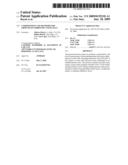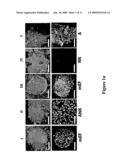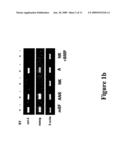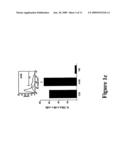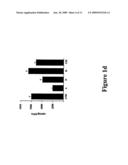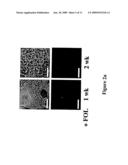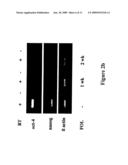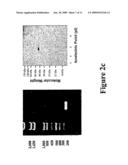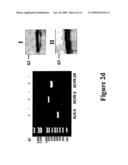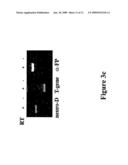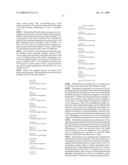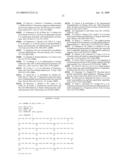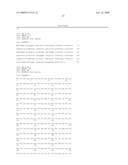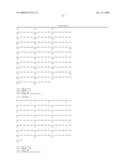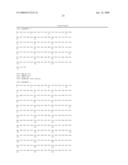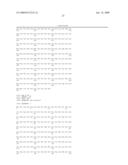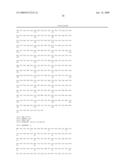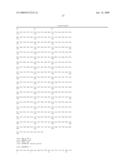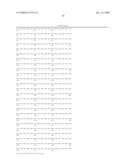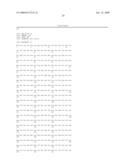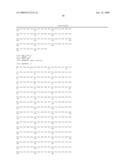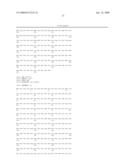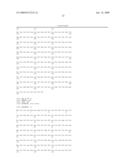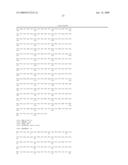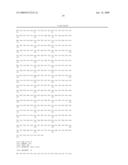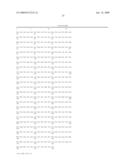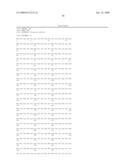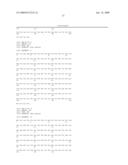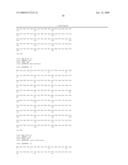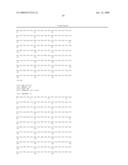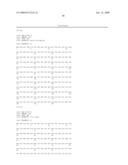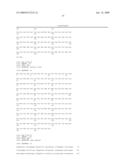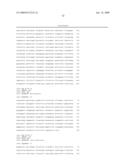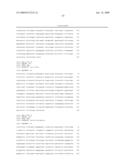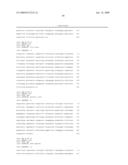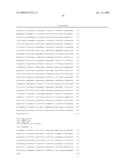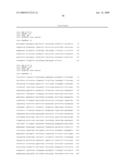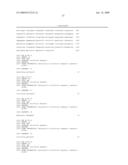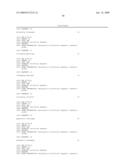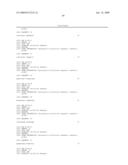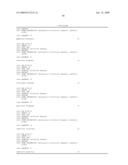Patent application title: COMPOSITIONS AND METHODS FOR GROWTH OF EMBRYONIC STEM CELLS
Inventors:
Alberto Hayek (La Jolla, CA, US)
Gillian Beattie (San Diego, CA, US)
Ana Lopez (San Diego, CA, US)
IPC8 Class: AA61K4500FI
USPC Class:
424 937
Class name: Drug, bio-affecting and body treating compositions whole live micro-organism, cell, or virus containing animal or plant cell
Publication date: 2009-06-18
Patent application number: 20090155218
Claims:
1. A method for maintenance of an undifferentiated stem cell, said method
comprising exposing a stem cell to a member of the transforming growth
factor-beta (TGFβ) family of proteins, a member of the fibroblast
growth factor (FGF) family of proteins, or nicotinamide (NIC) in an
amount sufficient to maintain the cell in an undifferentiated state for a
sufficient amount of time to achieve a desired result.
2. The method of claim 1, wherein the method comprises exposing said cell to two or more of a TGFβ family member, an FGF family member, and NIC.
3. The method of claim 1, wherein the method comprises exposing said cell to a TGFβ family member, an FGF family member, and NIC.
4. The method of claim 1, wherein the TGFβ family member is Activin A.
5. The method of claim 1, wherein the FGF family member is keratinocyte growth factor (KGF).
6. The method of claim 1, wherein said exposing results in growth of said cell.
7. The method of claim 1, wherein said exposing is repeated at least one time.
8. The method of claim 1, wherein said stem cell is a mammalian stem cell.
9. The method of claim 1, wherein said stem cell is a human stem cell.
10. The method of claim 1, wherein said stem cell is an embryonic stem cell.
11. The method of claim 1, wherein the desired result comprises culturing said stem cell for ten passages or more.
12. The method of claim 1, wherein the desired result comprises culturing said stem cell for thirty passages or more.
13. The method of claim 1, wherein the TGFβ family member shows 30% or greater sequence identity with SEQ ID NO:1.
14. The method of claim 1, wherein the TGFβ family member shows 80% or greater sequence identity with SEQ ID NO:1.
15. The method of claim 1, wherein the TGFβ family member shows 90% or greater sequence identity with SEQ ID NO:1.
16. The method of claim 1, wherein the TGFβ family member shows 95% or greater sequence identity with SEQ ID NO:1.
17. The method of claim 1, wherein the TGFβ family member shows 99% or greater sequence identity with SEQ ID NO:1.
18. The method of claim 1, wherein the FGF family member shows 30% or greater sequence identity with SEQ ID NO:17.
19. The method of claim 1, wherein the FGF family member shows 80% or greater sequence identity with SEQ ID NO:17.
20. The method of claim 1, wherein the FGF family member shows 90% or greater sequence identity with SEQ ID NO:17.
21. The method of claim 1, wherein the FGF family member shows 95% or greater sequence identity with SEQ ID NO:17.
22. The method of claim 1, wherein the FGF family member shows 99% or greater sequence identity with SEQ ID NO:17.
23. A composition comprising a) a culture medium and b) a TGFβ family member, an FGF family member, NIC, or a combination of two or more of these.
24. The composition of claim 23, wherein the TGFβ family member is Activin A.
25. The composition of claim 23, wherein the FGF family member is KGF.
26. The composition of claim 23, further comprising a stem cell.
27. The composition of claim 26, wherein said stem cell is a mammalian stem cell.
28. The composition of claim 26, wherein said stem cell is a human stem cell.
29. The composition of claim 26, wherein said stem cell is an embryonic stem cell.
30. The composition of claim 23, wherein the TGFβ family member shows 30% or greater sequence identity with SEQ ID NO:1.
31. The composition of claim 23, wherein the TGFβ family member shows 80% or greater sequence identity with SEQ ID NO:1.
32. The composition of claim 23, wherein the TGFβ family member shows 90% or greater sequence identity with SEQ ID NO:1.
33. The composition of claim 23, wherein the TGFβ family member shows 95% or greater sequence identity with SEQ ID NO:1.
34. The composition of claim 23, wherein the TGFβ family member shows 99% or greater sequence identity with SEQ ID NO:1.
35. The composition of claim 23, wherein the FGF family member shows 30% or greater sequence identity with SEQ ID NO:17.
36. The composition of claim 23, wherein the FGF family member shows 80% or greater sequence identity with SEQ ID NO:17.
37. The composition of claim 23, wherein the FGF family member shows 90% or greater sequence identity with SEQ ID NO:17.
38. The composition of claim 23, wherein the FGF family member shows 95% or greater sequence identity with SEQ ID NO:17.
39. The composition of claim 23, wherein the FGF family member shows 99% or greater sequence identity with SEQ ID NO:17.
40. A composition comprising a combination of two or more of a) at least one purified TGFβ family member protein, b) at least one purified FGF family member protein, and 3) purified NIC.
41. The composition of claim 40, which is a culture medium for stem cells.
42. The composition of claim 41, wherein the stem cells are mammalian stem cells.
43. The composition of claim 41, wherein the stem cells are human stem cells.
44. The composition of claim 41, wherein the stem cells are embryonic stem cells.
45. The composition of claim 41, wherein the TGFβ family member is Activin A.
46. The composition of claim 41, wherein the FGF family member is KGF.
47. An undifferentiated, pluripotent stem cell derived from a culture that has been passaged at least 10 times.
48. The stem cell of claim 47, wherein the culture has been passaged at least 20 times.
49. The stem cell of claim 47, wherein the culture has been passaged at least 30 times.
50. The stem cell of claim 47, wherein the stem cell has been passaged in the presence of media comprising a TGFβ family member, an FGF family member, or NIC, but not in the presence of conditioned media, feeder cells, or LIF.
51. The stem cell of claim 47, wherein the stem cell is a mammalian stem cell.
52. The stem cell of claim 47, wherein the stem cell is a human stem cell.
53. The stem cell of claim 47, wherein the stem cell is an embryonic stem cell.
54. A stem cell produced by a method comprising exposing a stem cell to a member of the transforming growth factor-beta (TGFβ) family of proteins, a member of the fibroblast growth factor (FGF) family of proteins, or nicotinamide (NIC) in an amount sufficient to maintain the cell in an undifferentiated state.
55. A kit comprising two or more of the following:a) a TGFβ family member,b) an FGF family member,c) NIC,d) a stem cell, ande) stem cell culture media.
56. The kit of claim 55, wherein the TGFβ family member is Activin A.
57. The kit of claim 55, wherein the FGF family member is KGF.
58. The kit of claim 55, wherein the stem cell is a mammalian stem cell.
59. The kit of claim 55, wherein the stem cell is a human stem cell.
60. The kit of claim 55, wherein the stem cell is an embryonic stem cell.
61. A method for maintenance of an undifferentiated stem cell, said method comprising exposing a stem cell to a member of the transforming growth factor-beta (TGFβ) family of proteins, a member of the fibroblast growth factor (FGF) family of proteins, or nicotinamide (NIC) in an amount sufficient to maintain the cell in an undifferentiated state for a sufficient amount of time to achieve a desired result, wherein the stem cell is not also exposed to a feeder cell, conditioned media, or leukemia inhibitory factor.
62. A composition comprising a) a culture medium and b) a TGFβ family member, an FGF family member, NIC, or a combination of two or more of these, wherein said composition does not comprise feeder cells, conditioned media, or LIF.
63. A differentiated cell derived from a stem cell grown or maintained by a method comprising exposing a stem cell to a member of the transforming growth factor-beta (TGFβ) family of proteins, a member of the fibroblast growth factor (FGF) family of proteins, or nicotinamide (NIC) in an amount sufficient to maintain the cell in an undifferentiated state.
64. An embryonic stem cell grown or maintained by a method comprising exposing a stem cell to a member of the transforming growth factor-beta (TGFβ) family of proteins, a member of the fibroblast growth factor (FGF) family of proteins, or nicotinamide (NIC) in an amount sufficient to maintain the cell in an undifferentiated state.
65. A pharmaceutical composition comprising a stem cell grown or maintained by a method comprising exposing a stem cell to a member of the transforming growth factor-beta (TGFβ) family of proteins, a member of the fibroblast growth factor (FGF) family of proteins, or nicotinamide (NIC) in an amount sufficient to maintain the cell in an undifferentiated state.
66. A cell derived from a stem cell grown or maintained by a method comprising exposing a stem cell to a member of the transforming growth factor-beta (TGFβ) family of proteins, a member of the fibroblast growth factor (FGF) family of proteins, or nicotinamide (NIC) in an amount sufficient to maintain the cell in an undifferentiated state
Description:
CROSS-REFERENCE TO RELATED APPLICATIONS
[0001]The present application claims the benefit of the filing date of U.S. provisional patent application No. 60/552,318, filed 10 Mar. 2004, the entire disclosure of which is hereby incorporated herein in its entirety by reference.
BACKGROUND OF THE INVENTION
[0002]1. Field of the Invention
[0003]The present invention relates to the field of molecular and cellular biology. More particularly, the present invention relates to growth of embryonic stem cells in culture in an undifferentiated state, and use of such cells for the study of cellular processes and development of medically useful products.
[0004]2. Description of Related Art
[0005]Due to their pluripotency, stem cells show great promise for treatments of many human diseases. Their ability to differentiate into any cell type makes them a valuable resource for research and development of treatments for diseases and disorders affecting numerous different cell types, tissues, and organs. Thus, there is currently intense interest in studying them, developing methods for growing and maintaining them in an undifferentiated state, and controlling differentiation of them to produce cell types of interest for treatments.
[0006]It has been proposed that stem cells, including adult stem cells and embryonic stem cells, either as isolated or modified by introduction of new genes or deletion or replacement of defective genes, can be used to replace or supplement defective or lost body tissues and organs, including those that produce substances that are critical for health and life. However, maintaining undifferentiated pluripotent stem cells in culture, a necessity for this type of research and subsequently for treatment, is notoriously difficult. When placed in culture containing no supplemental additives, undifferentiated stem cells spontaneously begin rapid differentiation and then typically slow or stop dividing. Thus, to date, few stem cells are actually available for research and development of treatments. To overcome this problem, researcher are attempting to devise ways to culture stem cells in an undifferentiated state through addition of exogenous substances that inhibit differentiation while permitting the cells to continue to divide.
[0007]The two most widely studied embryonic stem cell types are mouse embryonic stem cells (mESC) and human embryonic stem cells (hESC). Maintenance of the undifferentiated state and pluripotency in mouse embryonic stem cells requires the presence of mouse fibroblast feeder layers (mEFs) or activation of STAT3 with leukemia inhibitory factor (LIF). Likewise, hESC are typically cultured on mEFs or in media obtained from growth of fibroblasts. Because human embryonic stem cell lines have only recently become available for research, the intracellular pathways for self renewal and differentiation are, at this time, largely unknown. However, it is becoming apparent that the requirements for growth of hESC will be significantly different from those required for growth of MESC. For example, recently it was discovered that, unlike the situation with mESC, activation of STAT3 is not sufficient to block differentiation of hESC when grown on mEFs or when treated with conditioned media from mEFs.4 In addition, in a report published after the filing date of the priority document for this application, it was disclose that basic fibroblast factor (bFGF), a type of keratinocyte growth factor (KGF), together with noggin, inhibits differentiation of hESC. (Xu, R.-H. et al., 2005). Thus, according to the authors, addition of bFGF to culture media enables the continued growth and maintenance of hESC without the need for feeder cells.
[0008]Although advances are being made in the culturing of stem cells, and specifically embryonic stem cells, there is still a need in the art for practical, reliable methods and materials for maintaining and growing undifferentiated stem cells in culture. In particular, there exists a need in the art for methods and materials for growth and maintenance of undifferentiated hESC.
SUMMARY OF THE INVENTION
[0009]The present invention provides methods, compositions, and kits for growth and maintenance of undifferentiated stem cells, including embryonic stem cells. Thus, the present invention relates to maintenance of the undifferentiated state and/or pluripotency in embryonic stem cells. The methods, compositions, and kits are suitable for use in culturing stem cells for use in research, production of research and medical substances, and treatment of diseases and disorders, particularly those affecting humans.
[0010]In a first aspect, the present invention provides methods for growth and maintenance of undifferentiated stem cells. Generally, the methods comprise exposing stem cells to a member of the transforming growth factor β (TGFβ) family of proteins, such as Activin A, in an amount sufficient to maintain the cells in an undifferentiated state for a sufficient amount of time to achieve a desired result. The desired result can be any medically or scientifically relevant result, such as, but not limited to, production of a particular substance, confluency of the culture on a culture plate, production of a sufficient number of cells for transfer to new culture media (i.e., for passage), or production of a sufficient number of cells for implantation into a subject. The methods can comprise exposing the stem cells to a member of the fibroblast growth factor family (FGF) of proteins, such as KGF (also known as FGF7), in an amount sufficient to permit growth and maintenance of the cells in culture, including, but not limited to growth through multiple passages, such as about ten passages or more. Thus, the various forms of the method of the invention can result in growth and maintenance of stem cells in an undifferentiated state for at least ten passages in culture. The methods can likewise comprise exposing stem cells to nicotinamide (NIC) in an amount sufficient to permit growth and maintenance of the cells in culture through multiple passages, such as about ten passages, twenty passages, thirty passages, or more. The methods can permit growth and maintenance of stem cells in culture in the absence of any feeder cells, conditioned media, and/or leukemia inhibitory factor (LIF). In embodiments, the methods maintain the cells in a pluripotent state.
[0011]In a second aspect, the invention provides compositions that can be used to grow and/or maintain stem cells in an undifferentiated or pluripotent state. Generally, the compositions comprise a member of the TGFβ family, such as Activin A, a member of the FGF family, such as KGF, or NIC, or a combination of two or all three of these, in an amount and form that is sufficient to permit growth and/or maintenance of at least one culture of stem cells in an undifferentiated state for a sufficient amount of time to achieve a desired result. In accordance with the discussion of the methods, above, the desired result can be any medically or scientifically relevant result. Thus, in embodiments, the compositions can comprise KGF in amount sufficient to grow and/or maintain at least one culture of stem cells in an undifferentiated state for a sufficient amount of time to achieve a desired result. In embodiments, the compositions can comprise NIC in amount sufficient to grow and/or maintain at least one culture of stem cells in an undifferentiated state for a sufficient amount of time to achieve a desired result. In various embodiments, the compositions comprise combinations of two or more of Activin A, KGF, and NIC. The compositions of the invention generally comprise a component in addition to the TGFβ family member, the FGF family member, and/or NIC. The additional component can be any substance that is known to be suitable for, or compatible with, growth of stem cells or for introduction of stem cells or substances produced by stem cells into an animal or human subject. In embodiments, it is culture media. In view of the usefulness of the compositions of the invention in growing and maintaining stem cells, it is evident that the compositions of the invention can themselves comprise stem cells, including embryonic stem cells, such as hESC.
[0012]In a third aspect, the invention provides kits that contain some or all of the materials that are needed to grow and/or maintain embryonic stem cells in an undifferentiated or pluripotent state. In its most basic form, the kit comprises at least one container containing a member of the TGFβ family of proteins, a member of the FGF family of proteins, and/or NIC in an amount sufficient to grow and maintain stem cells in culture for a sufficient amount of time to achieve a desired result. The desired result can be any medically or scientifically relevant result, such as production of a detectable amount of a particular substance, confluency of the culture on a culture plate, production of a sufficient number of cells for implantation into a subject, and the like.
[0013]In a fourth aspect, the present invention provides stem cells that are undifferentiated and pluripotent. The stem cells are grown and maintained in the compositions of the invention. In embodiments, the stem cells are provided in compositions that do not comprise feeder cells, conditioned media from mouse embryonic feeder layers, and/or STAT3 activation.
BRIEF DESCRIPTION OF THE DRAWINGS
[0014]The accompanying drawings, which are incorporated in and constitute a part of this specification, illustrate features of several embodiments of the invention, and together with the written description, serve to explain certain facets of the invention.
[0015]FIG. 1 shows differentiation of hES cells in the absence of activin A. FIG. 1a shows the morphology and differentiation state of HSF6 cells observed by phase contrast microscopy (upper layer), and immunohistochemistry (lower layer). FIG. 1b shows semi-quantitative RT-PCR (26 cycles) of hES cells for oct-4 and nanog under a variety of culture conditions on mEFs (lane 1) or on laminin (lane 2-5). FIG. 1c shows a representative experiment of comparison of cell surface-antigen expression using FACS. FIG. 1d shows a representative experiment of comparison of proliferation of hES cells in the presence of activin A (A), NIC(N), KGF (K) or a combination of all 3 (ANK), and in FGF2 supplemented CM.
[0016]FIG. 2 shows the effect of activin/follistatin on mEF maintenance of pluripotency in HSF6 cells. FIG. 2a shows HSF6 cells from FIG. 1 Panel I, cultured on mEFs in the presence of follistatin for 1 week (left panels) and 2 weeks (right panels). FIG. 2b shows semi-quantitative RT-PCR (26 cycles) of HSF6 cells on mEFs for oct-4 and nanog in the presence and absence of follistatin. FIG. 2c shows identification of activin A transcripts in mEFs derived from CF-1 mice and precursor protein in mEF conditioned media using RT-PCR and Western blots.
[0017]FIG. 2d shows identification of activin pathway signaling components in HSF6 cells.
[0018]FIG. 3 shows long-term maintenance of pluripotency in hES cells cultured with activin A NIC and KGF. FIG. 3a shows analysis of stem cell markers in HSF6 cells cultured in the presence of activin A, KGF and NIC for 20 passages.
[0019]FIG. 3b shows teratoma formation in nude mice. FIG. 3c shows RT-PCR analysis of lineage specific markers in embryoid bodies derived from hES cells cultured in the presence of activin A, KGF and NIC.
DETAILED DESCRIPTION OF VARIOUS EMBODIMENTS OF THE INVENTION
[0020]Reference will now be made in detail to various exemplary embodiments of the invention. The following detailed description of certain embodiments of the invention should not be construed as limiting the invention in any way, but rather should be understood as an explanation of various embodiments to help describe the invention to those of skill in the art.
DEFINITIONS
[0021]Unless otherwise specifically defined herein, all terms used in this document are used in accordance with their general and customary usage in the arts of molecular biology and cellular biology. The following terms are defined as follows:
[0022]As used herein, the words "a", "an", and "the" include both singular and plural references unless the context of the sentence clearly dictates otherwise.
[0023]As used herein, the term "or" means one or a combination of two or more of the listed choices.
[0024]As used herein, the term "comprising" when placed before the recitation of steps in a method means that the method encompasses one or more steps that are additional to those expressly recited, and that the additional one or more steps may be performed before, between, and/or after the recited steps. For example, a method comprising steps a, b, and c encompasses a method of steps a, b, x, and c, a method of steps a, b, c, and x, as well as a method of steps x, a, b, and c. Furthermore, the term "comprising" when placed before the recitation of steps in a method does not necessarily require sequential performance of the listed steps, unless the context of the sentence clearly dictates otherwise. For example, a method comprising steps a, b, and c encompasses a method of performing steps in the order of steps a, c, and b, the order of steps c, b, and a, and the order of steps c, a, and b, etc.
[0025]As used herein, the terms "contacting" and "exposing" are used interchangeably, and, when used in connection with cells and a substance, mean placing the substance in a location and under conditions that will allow it to touch the cell in order to produce "contacted" or "exposed" cells.
[0026]As used herein, the term "cell" refers to a single cell as well as to a population of (i.e., more than one) cells. The population may be a pure population comprising one cell type. alternatively, the population may comprise more than one cell type. In the present invention, there is no limit on the number of cell types that a cell population may comprise. Furthermore, as used herein, the term "cell culture" refers to any in vitro culture of cells. Included within this term are continuous cell lines (e.g., with an immortal phenotype), primary cell cultures, finite cell lines (e.g., non-transformed cells), and any other cell population maintained in vitro, including oocytes and embryos.
[0027]As used herein, the term "mixed cell culture" refers to a mixture of two or more types of cells. In some embodiments, the cells are cell lines that are not genetically engineered, while in other embodiments the cells are genetically engineered cell lines. In some embodiments the cells contain genetically engineered molecules. The present invention, while not so limited, encompasses any combination of cell types suitable for production of teratomas, or for the detection, identification, and/or quantitation of apoptosis in samples, including mixed cell cultures in which all of the cell types used are not genetically engineered, mixtures in which one or more of the cell types are genetically engineered and the remaining cell types are not genetically engineered, and mixtures in which all of the cell types are genetically engineered.
[0028]As used herein, the term "primary cell" is a cell which is directly obtained from a tissue (e.g. blood) or organ of an animal, including a human, in the absence of culture. Typically, though not necessarily, a primary cell is capable of undergoing ten or fewer passages in vitro before senescence and/or cessation of proliferation. In contrast, a "cultured cell" is a cell which has been maintained and/or propagated in vitro for ten or more passages.
[0029]As used herein, the term "cultured cells" refer to cells which are capable of a greater number of passages in vitro before cessation of proliferation and/or senescence when compared to primary cells from the same source. Cultured cells include "cell lines" and "primary cultured cells."
[0030]As used herein, the term "cell line" refers to cells that are cultured in vitro, including primary cell lines, finite cell lines, continuous cell lines, and transformed cell lines. The term does not require that the cells be capable of an infinite number of passages in culture. Cell lines may be generated spontaneously or by transformation.
[0031]As used herein, the terms "primary cell culture" and "primary culture" refer to cell cultures that have been directly obtained from cells in vivo, such as from animal or insect tissue. These cultures may be derived from adult as well as fetal tissue.
[0032]As used herein, the terms "monolayer", "monolayer culture", and "monolayer cell culture" refer to cells that have adhered to a substrate and grow as a layer that is one cell in thickness. Monolayer cells may be grown in any format, including but not limited to flasks, tubes, coverslips (e.g., shell vials), roller bottles, etc. Monolayer cells may also be grown attached to microcarriers, including but not limited to beads.
[0033]As used herein, the terms "suspension" and "suspension culture" refer to cells that survive and proliferate without being attached to a substrate. Suspension cultures can be produced using hematopoietic cells, transformed cell lines, and cells from malignant tumors.
[0034]As used herein, the terms "culture media" and "cell culture media" refer to media that are suitable to support the growth of cells in vitro (i.e., cell cultures). It is not intended that the term be limited to any particular culture medium. For example, it is intended that the definition encompass outgrowth as well as maintenance media. Indeed, it is intended that the term encompass any culture medium suitable for the growth of the cell cultures of interest.
[0035]As used herein the term, the term "in vitro" refers to an artificial environment and to processes or reactions that occur within an artificial environment. In vitro environments are exemplified by, but are not limited to, test tubes and cell cultures.
[0036]As used herein, the term "in vivo" refers to the natural environment (e.g., an animal or a cell) and to processes or reactions that occur within a natural environment.
[0037]As used herein, the terms "proliferation" and "growth", which are used interchangeably, refer to an increase in cell number. In contrast, "maintenance" means continued survival of a cell or population of cells, but not necessarily survival with an increase in numbers of cells.
[0038]As used herein, the term "differentiate" and all of its forms refers to the maturation process cells undergo whereby they develop distinctive characteristics, and/or preform specific functions, and/or are less likely to divide.
[0039]As used herein, the terms "isolate" and "purify", and all of their forms refer to the reduction in the amount of at least one contaminant (such as protein and/or nucleic acid sequence) from a sample. Thus purification results in an "enrichment" (i.e., an increase) in the amount of a desirable protein and/or nucleic acid sequence in the sample.
[0040]As used herein, the term "amino acid sequence" refers to an amino acid sequence of a naturally occurring or engineered protein molecule. "Amino acid sequence" and like terms, such as "polypeptide", "peptide", or "protein" are not meant to limit the amino acid sequence to the complete, native amino acid sequence associated with the recited protein molecule.
[0041]As used herein, the terms "receptor proteins" and "membrane receptor proteins" refer to membrane spanning proteins, or portions thereof, that bind a ligand (e.g., gp 130, a microbial molecule; endotoxin, such as LPS, LTA; dsRNA, and the like).
[0042]As used herein, the term "ligand" refers to a molecule that binds to a second molecule. A particular molecule may be referred to as either, or both, a ligand and second molecule. Examples of second molecules include a receptor of the ligand, and an antibody that binds to the ligand.
[0043]As used herein, the term "activating" when in reference to a biochemical response (such as kinase activity) and/or cellular response (such as cell proliferation) refers to increasing the biochemical and/or cellular response. As used herein, the term "activated" when in reference to a cell, refers to a cell that has undergone a response that alters its physiology and shifts it towards making a biologically response and becoming biologically "active" hence "activated". For example, a monocyte becomes activated to mature into a macrophage. For another example, a macrophage becomes activated upon contact with endotoxin (such as LPS) wherein the activated macrophage can produce an increased level and/or type of molecule associated with activation (e.g. iNOS, MMP-12 Metalloelastase and the like). In another example, an immature dendritic cell becomes activated to mature into a functional dendritic cell. An "activated" cell does not necessarily, although it may, undergo growth or proliferation.
[0044]As used herein, the terms "naturally occurring", "wild-type", and "wt" when applied to a molecule or composition (such as nucleotide sequence, amino acid sequence, cell, apoptotic blebs, external phosphatidylserine, etc.), mean that the molecule or composition can be found in nature and has not been intentionally modified by man. For example, a naturally occurring polypeptide sequence refers to a polypeptide sequence that is present in an organism that can be isolated from a source in nature, wherein the polypeptide sequence has not been intentionally modified by man.
[0045]The terms "derived from" and "established from" when made in reference to any cell disclosed herein refer to a cell which has been obtained (e.g., isolated, purified, etc.) from the parent cell in issue using any manipulation, such as, without limitation, infection with virus, transfection with DNA sequences, treatment and/or mutagenesis using for example chemicals, radiation, etc., selection (such as by serial culture) of any cell that is contained in cultured parent cells. A derived cell can be selected from a mixed population by virtue of response to a growth factor, cytokine, selected progression of cytokine treatments, adhesiveness, lack of adhesiveness, sorting procedure, and the like.
[0046]As used herein, the term "biologically active," refers to a molecule (e.g. peptide, nucleic acid sequence, carbohydrate molecule, organic or inorganic molecule, and the like) having structured, regulatory, and/or biochemical functions in vivo.
[0047]Unless defined otherwise in reference to the level of molecules and/or phenomena, the terms "reduce", "inhibit", "diminish", "suppress", "decrease", and all of their forms, when in reference to the level of any molecule (e.g., protein, nucleic acid sequence, protein sequence, proliferation, rate of differentiation, etc.), phenomenon (e.g., protein-protein interactions, catalytic activity, apoptosis, cell death, cell survival, cell proliferation, cell differentiation, caspase cleavage, receptor dimerization, receptor complex formation, DNA fragmentation, molecule translocation, binding to a molecule, expression of a nucleic acid sequence, transcription of a nucleic acid sequence, enzyme activity, etc.) in a first sample relative to a second sample, mean that the quantity of molecule and/or phenomenon in the first sample is lower than in the second sample by any amount that is detectable.
[0048]Unless defined otherwise in reference to the level of molecules and/or phenomena, the terms "increase", "elevate", "raise", and all of their forms when in reference to the level of any molecule (e.g., protein, nucleic acid sequence, protein sequence, proliferation, rate of differentiation, etc.), phenomenon (e.g., protein-protein interactions, catalytic activity, apoptosis, cell death, cell survival, cell proliferation, cell differentiation, caspase cleavage, receptor dimerization, receptor complex formation, DNA fragmentation, molecule translocation, binding to a molecule, expression of a nucleic acid sequence, transcription of a nucleic acid sequence, enzyme activity, etc.) in a first sample relative to a second sample, mean that the quantity of the molecule and/or phenomenon in the first sample is higher than in the second sample by any amount that is statistically significant using any art-accepted statistical method of analysis.
[0049]As used herein, the term "apoptosis" refers to the process of non-necrotic death that takes place in metazoan animal cells following activation of an intrinsic cell suicide program. Apoptosis is a normal process in the proper development and homeostasis of metazoan animals and usually leads to cell death. Apoptosis is also triggered pathologically by microbial infections resulting in increasing susceptibility to apoptosis and/or outright death. Apoptosis involves sequential characteristic morphological and biochemical changes. One early marker of apoptosis is the flipping of plasma membrane phosphatidylserine, inside to outside, with cellular blebbing called "zeiosis," of plasma membrane releasing vesicles containing cellular material including RNA and DNA as apoptotic bodies. During apoptosis, there is cell expansion followed by shrinkage through release of apoptotic bodies and lysis of the cell, nuclear collapse and fragmentation of the nuclear chromatin, at certain intranucleosomal sites, due to activation of endogenous nucleases. Apoptotic bodies are typically phagocytized by other cells, in particular immunocytes such as monocytes, macrophages, immature dendritic cells and the like. One of skill in the art appreciates that reducing the ability to undergo apoptosis results in increased cell survival, without necessarily (although it may include) increasing cell proliferation. Accordingly, as used herein, the terms "reduce apoptosis" and "increase survival" are equivalent. Also, as used herein, the terms "increase apoptosis" and "reduced survival" are equivalent.
[0050]As used herein, the term "cellular response" refers to an increase or decrease of activity by a cell. For example, the "cellular response" may constitute but is not limited to apoptosis, death, DNA fragmentation, blebbing, proliferation, differentiation, adhesion, migration, DNA/RNA synthesis, gene transcription and translation, and/or cytokine secretion or cessation of such processes. A "cellular response" may comprise an increase or decrease of dephosphorylation, phosphorylation, calcium flux, target molecule cleavage, protein-protein interaction, nucleic acid-nucleic acid interaction, and/or protein/nucleic acid interaction and the like. As used herein, the term "target molecule cleavage" refers to the splitting of a molecule (for example in the process of apoptosis, cleavage of procaspases into fragments, cleavage of DNA into predicable sized fragments and the like). As used herein, the term "interaction" refers to the reciprocal action or influence of two or more molecules on each other.
[0051]As used herein, the term "transgenic" when used in reference to a cell refers to a cell that contains a transgene, or whose genome has been altered by the introduction of a transgene. The term "transgenic" when used in reference to a tissue refers to a tissue that comprises one or more cells that contain a transgene, or whose genome has been altered by the introduction of a transgene. Transgenic cells and tissues may be produced by several methods including the introduction of a "transgene" comprising nucleic acid (usually DNA) into a target cell or integration of the transgene into a chromosome of a target cell by way of human intervention, such as those known to those of skill in the art.
[0052]As used herein, the term "transgene" refers to any nucleic acid sequence which is introduced into the cell by experimental manipulations. A transgene may be an "endogenous DNA sequence" or a "heterologous DNA sequence" (i.e., "foreign DNA"). The term "endogenous DNA sequence" refers to a nucleotide sequence which is naturally found in the cell into which it is introduced so long as it does not contain some modification (e.g., a point mutation, the presence of a selectable marker gene, etc.) relative to the naturally-occurring sequence. The term "heterologous DNA sequence" refers to a nucleotide sequence which is ligated to, or is manipulated to become ligated to, a nucleic acid sequence to which it is not ligated in nature, or to which it is ligated at a different location in nature. Heterologous DNA is not endogenous to the cell into which it is introduced, but has been obtained from another cell. Heterologous DNA also includes an endogenous DNA sequence which contains some modification. Generally, although not necessarily, heterologous DNA encodes RNA and proteins that are not normally produced by the cell into which it is expressed. Examples of heterologous DNA include reporter genes, transcriptional and translational regulatory sequences, selectable marker proteins (e.g., proteins which confer drug resistance), etc.
[0053]As used herein, the terms "agent", "test agent", "molecule", "test molecule", "compound", and "test compound" are used interchangeably herein and refer to any type of molecule (for example, a peptide, nucleic acid, carbohydrate, lipid, organic molecule, and inorganic molecule, etc.) any combination molecule for example glycolipid, etc.) obtained from any source (for example, plant, animal, protist, and environmental source etc.), or prepared by any method (for example, purification of naturally occurring molecules, chemical synthesis, and genetic engineering methods, etc.). Thus, these terms are synonymous with the term "substance". In one embodiment, the term "test agent" refers to any chemical entity, pharmaceutical, drug, and the like that can be used to treat or prevent a disease, illness, sickness, or disorder of bodily function. Test agents comprise both known and potential therapeutic agents. A test agent can be determined to be therapeutic by screening using the screening methods of the present invention. A "known therapeutic agent" refers to a therapeutic agent that has been shown (e.g., through animal trials or prior experience with administration to humans) to be effective in such treatment or prevention. In other words, a known therapeutic agent is not limited to an agent efficacious in the treatment of disease (e.g., cancer). Agents are exemplified by, but not limited to, antibodies, nucleic acid sequences such as ribozyme sequences, and other agents as further described herein. The test agents identified by and/or used in the invention's methods include any type of molecule (for example, a peptide, nucleic acid, carbohydrate, lipid, organic, and inorganic molecule, etc.) obtained from any source (for example, plant, animal, and environmental source, etc.), or prepared by any method (for example, purification of naturally occurring molecules, chemical synthesis, and genetic engineering methods, etc.).
[0054]Unless otherwise indicated by the terms "exactly", "precisely", or another equivalent term, all numbers expressing quantities of ingredients, properties such as molecular weight, reaction conditions, and so forth as used herein, are to be understood as being modified in all instances by the term "about", and thus to inherently include variations of up to 10% greater or less than the actual number stated. Accordingly, unless indicated to the contrary, the numerical parameters herein are approximations that may vary depending upon the desired properties sought to be obtained by the present invention. At the very least, each numerical parameter should at least be construed in light of the number of reported significant digits and by applying ordinary rounding techniques. Notwithstanding that the numerical ranges and parameters describing the broad scope of the invention are approximations, the numerical values in the specific examples are reported as precisely as possible. Any numerical value, however, inherently contains standard deviations that necessarily result from the errors found in the numerical value's testing measurements.
[0055]The term "alter" and all of its forms as used herein in reference to the level of any molecule (e.g., nucleic acid sequence, protein sequence, apoptotic blebs, external phosphatidylserine, etc.), and/or phenomenon (e.g., apoptosis, cell death, cell survival, cell proliferation, caspase cleavage, receptor dimerization, receptor complex formation, DNA fragmentation, molecule translocation, binding to a molecule, expression of a nucleic acid sequence, transcription of a nucleic acid sequence, enzyme activity, etc.) refers to an increase or decrease in the quantity of the molecule and/or phenomenon, regardless of whether the quantity is determined objectively, and/or subjectively.
[0056]Reference herein to any specifically named protein (such as activin A polypeptide, KGF, etc.) refers to any and all equivalent fragments, fusion proteins, and variants of the specifically named protein, having at least one of the biological activities (disclosed herein) of the specifically named protein, wherein the biological activity is detectable by any method. Naming of a protein thus includes all forms of that protein, including specific forms of a protein that is generically referred to herein.
[0057]The term "fragment" when in reference to a protein (such as activin A polypeptide, KGF, etc.) refers to a portion of that protein that may range in size from four (4) contiguous amino acid residues to the entire amino acid sequence minus one amino acid residue. Thus, a polypeptide sequence comprising "at least a portion of an amino acid sequence" is equivalent to a "fragment" and comprises from four (4) contiguous amino acid residues of the amino acid sequence to the entire amino acid sequence.
[0058]The terms "variant" and "homolog" (such as activin A polypeptide, KGF, etc.) as used herein are proteins that differ from a reference protein by insertion, deletion, and/or substitution of one or more amino acids, where the insertion, deletion, and/or substitution preferably does not alter the primary biological function of the reference protein. Variants and homologs include proteins having structural and functional characteristics in common with a reference protein, but from a different species. In embodiments, the substitutions are conserved changes to one or more amino acids. The term "conservative substitution" of an amino acid refers to the replacement of that amino acid with another amino acid which has a similar hydrophobicity, polarity, and/or structure. For example, the following aliphatic amino acids with neutral side chains may be conservatively substituted one for the other: glycine, alanine, valine, leucine, isoleucine, serine, and threonine. Aromatic amino acids with neutral side chains which may be conservatively substituted one for the other include phenylalanine, tyrosine, and tryptophan. Cysteine and methionine are sulphur-containing amino acids which may be conservatively substituted one for the other. Also, asparagine may be conservatively substituted for glutamine, and vice versa, since both amino acids are amides of dicarboxylic amino acids. In addition, aspartic acid (aspartate) may be conservatively substituted for glutamic acid (glutamate) as both are acidic, charged (hydrophilic) amino acids. Also, lysine, arginine, and histidine my be conservatively substituted one for the other since each is a basic, charged (hydrophilic) amino acid. Guidance in determining which and how many amino acid residues may be substituted, inserted or deleted without abolishing biological and/or immunological activity may be found using computer programs well known in the art, for example, DNAStar® software. Thus, members of a family of proteins, such as members of the TGFβ family and the FGF family, contain variants and homologs of other members of the family.
[0059]The "TGFβ family" means proteins having structural and functional characteristics of known TGFβ family members. The TGFβ family of proteins is well characterized, both from structural and functional aspects. It includes the TGFβ series of proteins, the Inhibins (including Inhibin A and Inhibin B), the Activins (including Activin A, Activin B, and Activin AB), MIS (Mullerian inhibiting substance), BMP (bone morphogenetic proteins), dpp (decapentaplegic), Vg-1, MNSF (monoclonal nonspecific suppressor factor), and others. Of the various well-characterized activities of the TGFβ family members, TGFβ is considered to be the most potent growth inhibitor for normal and transformed epithelial cells, endothelial cells, fibroblasts, neuronal cells, lymphoid cells, and other hematopoietic cell types. Activity of this family of proteins is based on specific binding to certain receptors on various cell types. Members of this family share regions of sequence identity, particularly at the C-terminus, that correlate to their function. The TGFβ family includes more than one hundred distinct proteins, all sharing at least one region of amino acid sequence identity. Members of the family include, but are not limited to, the following proteins, as identified by their GenBank accession numbers: P07995, P18331, P08476, Q04998, P03970, P43032, P55102, P27092, P42917, P09529, P27093, P04088, Q04999, P17491, P55104, Q9WUK5, P55103, O88959, O08717, P58166, O61643, P35621, P09534, P48970, Q9NR23, P25703, P30884, P12643, P49001, P21274, O46564, O19006, P22004, P20722, Q04906, Q07104, P30886, P18075, P23359, P22003, P34821, P49003, Q90751, P21275, Q06826, P30885, P34820, Q29607, P12644, Q90752, O46576, P27539, P48969, Q26974, P07713, P91706, P91699, P27091, O42222, Q24735, P20863, O18828, P55106, Q9PTQ2, O14793, O08689, O42221, O18830, O18831, O18836, O35312, O42220, P43026, P43027, P43029, O95390, Q9R229, O93449, Q9Z1W4, Q9BDW8, P43028, Q7Z4P5, P50414, P17246, P54831, P04202, P01137, P09533, P18341, O19011, Q9Z1Y6, P07200, Q9Z217, O95393, P55105, P30371, Q9MZE2, Q07258, Q96S42, P97737, AAA97415.1, NP--776788.1, NP--058824.1, EAL24001.1, 1S4Y, NP--001009856.1, NP--032406.1, NP--999193.1, XP--519063.1, AAG17260.1, CAA40806.1, NP--001009458.1, AAQ55808.1, AAK40341.1, AAP33019.1, AAK21265.1, AAC59738.1, CAI46003.1, B40905, AAQ55811.1, AAK40342.1, XP--540364.1, P55102, AAQ55810.1, NP--990727.1, CAA51163.1, AAD50448.1, JC4862, PN0504, BAB17600.1, AAH56742.1, BAB17596.1, CAG06183.1, CAG05339.1, BAB17601.1, CAB43091.1, A36192, AAA49162.1, AAT42200.1, NP--789822.1, AAA59451.1, AAA59169.1, XP--541000.1, NP--990537.1, NP--002184.1, AAC14187.1, AAP83319.1, AAA59170.1, BAB16973.1, AAM66766.1, WFPGBB, 1201278C, AAH30029.1, CAA49326.1, XP--344131.1, AAH48845.1, XP--148966.3, I48235, B41398, AAH77857.1, AAB26863.1, 1706327A, BAA83804.1, NP--571143.1, CAG00858.1, BAB17599.1, BAB17602.1, AAB61468.1, PN0505, PN0506, CAB43092.1, BAB17598.1, BAA22570.1, BAB16972.1, BAC81672.1, BAA12694.1, BAA08494.1, B36192, C36192, BAB16971.1, NP--034695.1, AAA49160.1, CAA62347.1, AAA49161.1, AAD30132.1, CAA58290.1, NP--005529.1, XP--522443.1, AAM27448.1, XP--538247.1, AAD30133.1, AAC36741.1, AAH10404.1, NP--032408.1, AAN03682.1, XP--509161.1, AAC32311.1, NP--651942.2, AAL51005.1, AAC39083.1, AAH85547.1, NP--571023.1, CAF94113.1, EAL29247.1, AAW30007.1, AAH90232.1, A29619, NP--001007905.1, AAH73508.1, AAD02201.1, NP--999793.1, NP--990542.1, AAF19841.1, AAC97488.1, AAC60038.1, NP 989197.1, NP--571434.1, EAL41229.1, AAT07302.1, CAI19472.1, NP--031582.1, AAA40548.1, XP--535880.1, NP--037239.1, AAT72007.1, XP--418956.1, CAA41634.1, BAC30864.1, CAA38850.1, CAB81657.2, CAA45018.1, CAA45019.1, BAC28247.1, NP--031581.1, NP--990479.1, NP--999820.1, AAB27335.1, S45355, CAB82007.1, XP--534351.1, NP--058874.1, NP--031579.1, 1REW, AAB96785.1, AAB46367.1, CAA05033.1, BAA89012.1, 1ES7, AAP20870.1, BAC24087.1, AAG09784.1, BAC06352.1, AAQ89234.1, AAM27000.1, AAH30959.1, CAG01491.1, NP--571435.1, 1REU, AAC60286.1, BAA24406.1, A36193, AAH55959.1, AAH54647.1, AAH90689.1, CAG09422.1, BAD16743.1, NP--032134.1, XP--532179.1, AAB24876.1, AAH57702.1, AAA82616.1, CAA40222.1, CAB90273.2, XP--342592.1, XP--534896.1, XP--534462.1, 1LXI, XP--417496.1, AAF34179.1, AAL73188.1, CAF96266.1, AAB34226.1, AAB33846.1, AAT12415.1, AAO33819.1, AAT72008.1, AAD38402.1, BAB68396.1, CAA45021.1, AAB27337.1, AAP69917.1, AAT12416.1, NP--571396.1, CAA53513.1, AAO33820.1, AAA48568.1, BAC02605.1, BAC02604.1, BAC02603.1, BAC02602.1, BAC02601.1, BAC02599.1, BAC02598.1, BAC02597.1, BAC02595.1, BAC02593.1, BAC02592.1, BAC02590.1, AAD28039.1, AAP74560.1, AAB94786.1, NP--001483.2, XP--528195.1, NP--571417.1, NP--001001557.1, AAH43222.1, AAM33143.1, CAG10381.1, BAA31132.1, EAL39680.1, EAA12482.2, P34820, AAP88972.1, AAP74559.1, CAI16418.1, AAD30538.1, XP--345502.1, NP--038554.1, CAG04089.1, CAD60936.2, NP--031584.1, B55452, AAC60285.1, BAA06410.1, AAH52846.1, NP--031580.1, NP--036959.1, CAA45836.1, CAA45020.1, Q29607, AAB27336.1, XP--547817.1, AAT12414.1, AAM54049.1, AAH78901.1, AAO25745.1, NP--570912.1, XP--392194.1, AAD20829.1, AAC97113.1, AAC61694.1, AAH60340.1, AAR97906.1, BAA32227.1, BAB68395.1, BAC02895.1, AAW51451.1, AAF82188.1, XP--544189.1, NP--990568.1, BAC80211.1, AAW82620.1, AAF99597.1, NP--571062.1, CAC44179.1, AAB97467.1, AAT99303.1, AAD28038.1, AAH52168.1, NP--001004122.1, CAA72733.1, NP--032133.2, XP--394252.1, XP--224733.2, JH0801, AAP97721.1, NP--989669.1, S43296, P43029, A55452, AAH32495.1, XP--542974.1, NP--032135.1, AAK30842.1, AAK27794.1, BAC30847.1, EAA12064.2, AAP97720.1, XP--525704.1, AAT07301.1, BAD07014.1, CAF94356.1, AAR27581.1, AAG13400.1, AAC60127.1, CAF92055.1, XP--540103.1, AAO20895.1, CAF97447.1, AAS01764.1, BAD08319.1, CAA10268.1, NP--998140.1, AAR03824.1, AAS48405.1, AAS48403.1, AAK53545.1, AAK84666.1, XP--395420.1, AAK56941.1, AAC47555.1, AAR88255.1, EAL33036.1, AAW47740.1, AAW29442.1, NP--722813.1, AAR08901.1, AAO15420.2, CAC59700.1, AAL26886.1, AAK71708.1, AAK71707.1, CAC51427.2, AAK67984.1, AAK67983.1, AAK28706.1, P07713, P91706, P91699, CAG02450.1, AAC47552.1, NP--005802.1, XP--343149.1, AW34055.1, XP--538221.1, AAR27580.1, XP--125935.3, AAF21633.1, AAF21630.1, AAD05267.1, Q9Z1W4, NP--031585.2, NP--571094.1, CAD43439.1, CAF99217.1, CAB63584.1, NP--722840.1, CAE46407.1, XP--417667.1, BAC53989.1, BAB19659.1, AAM46922.1, AAA81169.1, AAK28707.1, AAL05943.1, AAB17573.1, CAH25443.1, CAG10269.1, BAD16731.1, EAA00276.2, AAT07320.1, AAT07300.1, AAN15037.1, CAH25442.1, AAK08152.2, 2009388A, AAR12161.1, CAG01961.1, CAB63656.1, CAD67714.1, CAF94162.1, NP--477340.1, EAL24792.1, NP--001009428.1, AAB86686.1, AAT40572.1, AAT40571.1, AAT40569.1, NP--033886.1, AAB49985.1, AAG39266.1, Q26974, AAC77461.1, AAC47262.1, BAC05509.1, NP--055297.1, XP--546146.1, XP--525772.1, NP--060525.2, AAH33585.1, AAH69080.1, CAG12751.1, AAH74757.2, NP--034964.1, NP--038639.1, O42221, AAF02773.1, NP--062024.1, AAR18244.1, AAR14343.1, XP--228285.2, AAT40573.1, AAT94456.1, AAL35278.1, AAL35277.1, AAL17640.1, AAC08035.1, AAB86692.1, CAB40844.1, BAC38637.1, BAB16046.1, AAN63522.1, NP--571041.1, AAB04986.2, AAC26791.1, AAB95254.1, BAA11835.1, AAR18246.1, XP--538528.1, BAA31853.1, AAK18000.1, XP--420540.1, AAL35276.1, AAQ98602.1, CAE71944.1, AAW50585.1, AAV63982.1, AAW29941.1, AAN87890.1, AAT40568.1, CAD57730.1, AAB81508.1, AAS00534.1, AAC59736.1, BAB79498.1, AAA97392.1, AAP85526.1, NP--999600.2, NP--878293.1, BAC82629.1, CAC60268.1, CAG04919.1, AAN10123.1, CAA07707.1 AAK20912.1, AAR88254.1, CAC34629.1, AAL35275.1, AAD46997.1, AAN03842.1, NP--571951.2, CAC50881.1, AAL99367.1, AAL49502.1, AAB71839.1, AAB65415.1, NP--624359.1, NP--990153.1, AAF78069.1, AAK49790.1, NP--919367.2, NP--001192.1, XP--544948.1, AAQ18013.1, AAV38739.1, NP--851298.1, CAA67685.1, AAT67171.1, AAT37502.1, AAD27804.1, AAN76665.1, BAC11909.1, XP--421648.1, CAB63704.1, NP--037306.1, A55706, AAF02780.1, CAG09623.1, NP--067589.1, NP--035707.1, AAV30547.1, AAP49817.1, BAC77407.1, AAL87199.1, CAG07172.1, B36193, CAA33024.1, NP--001009400.1, AAP36538.1, XP--512687.1, XP--510080.1, AAH05513.1, 1KTZ, AAH14690.1, AAA31526.1.
[0060]The "FGF family" means proteins having structural and functional characteristics of known FGF family members. The FGF family of proteins is well characterized, both from structural and functional aspects. It includes at least 20 distinct members (not including variants and homologs), including the specific FGF series of proteins (FGF1 and FGF2), the K-FGF (found in Kaposi's sarcoma cells), and the KGF proteins. The members of this family that have been identified to date exhibit 30-70% amino acid sequence homology. Members of the family include, but are not limited to, the following proteins, as identified by their GenBank accession numbers: P21781, P79150, P48808, Q9N198, P36363, Q02195, P70492, O15520, O35565, Q9ESS2, Q9HCT0, P36364, P54130, P31371, O43320, Q91875, Q9NP95, O54769, P48801, P36386, P05524, P11487, P48802, Q92915, P12034, P48807, P15656, P70379, P48806, Q8R5L7, P48805, P70377, P48804, Q92913, P61329, Q11184, P10767, Q92914, P21658, P70378, P08620, P61148, Q616M7, P48800, P34004, P15655, P13109, P09038, P48803, Q6PBT8, P05230, P03969, Q7SIF8, P20003, P48798, P12226, Q6GLR6, P20002, P03968, Q7M303, P19596, Q60487--3, Q6SJP8, P48799, O76093, O89101, O88182, P11403, O60258, P63075, P37237, Q9N1S8, P55075, Q90722, Q805B2, O35622, O95750, Q9JJN1, Q9NSA1, Q9GZV9, P41444, O10284, Q9EPC2, Q8VI82, O62682, Q9JYA0, Q9JT82, P01030--3, NP--002000.1, AAA67335.1, AAX19003.1, NP--001003237.1, NP--001009235.1, NP--032034.1, S26049, AAF26734.1, BAC39707.1, NP--071518.1, AAL16059.1, AAG31597.1, BAD84165.1, AAH88532.1, AAR87872.1, B46289, C46289, NP--001007762.1, CAB90393.1, D46289, NP--004456.1, XP--526931.1, NP--037083.1, BAB60779.1, AAM46926.1, CAG46489.1, NP--032028.1, BAD74123.1, AAL05875.1, AAK59700.1, NP--001009230.1, AAR37413.1, NP--990027.1, CAB76368.1, CAD29182.1, AAC78789.1, CAG08586.1, NP--878290.1, AAL16959.1, NP--570107.1, NP--075793.1, AAH10956.1, BAC57976.1, AAQ93357.1, AAC25096.1, AAL16963.1, AAO25617.1, AAG29501.1, NP--989730.1, NP--998966.1, CAC17692.1, NP--038546.1, NP--037084.1, NP--003859.1, XP--420304.1, NP--068639.1, BAB71729.1, AAT85804.1, NP--085117.1, CAF99081.1, NP--076451.1, NP--085113.1, BAC34892.1, CAF91044.1, XP--426335.1, CAA87635.1, CAG13262.1, CAA80987.1, AAH81367.1, CAG01370.1, NP--032033.1, NP--570830.1, NP--571366.1, NP--005238.1, AAC06148.1, BAC22069.1, XP--529049.1, AAH76721.1, NP--001001743.1, AAF31398.1, AAO33291.1, AAL16957.1, CAA44480.1, NP--991265.1, AAN16025.1, AAB18918.1, CAI15768.1, NP--034330.2, NP--990108.1, NP--445880.1, AAF31392.1, AAB71606.1, P70379, XP--542656.1, NP--071559.2, NP--997550.1, CAA44479.1, AAL83904:1, NP--001012382.1, NP--001009561.1, AAW69551.1, AAN04097.1, TVHUF5, NP--004455.1, P12034, NP--378668.1, NP--004105.1, AAH85439.1, CAI43189.1, CAI42700.1, CAI42699.1, BAD72887.1, CAG09626.1, NP--001009563.1, XP--534534.1, XP--524019.1, NP--001012380.1, NP--071547.1, NP--034333.1, NP--990219.1, AAF31390.1, XP--549094.1, CAA76422.1, CAG07674.1, NP--004104.3, XP--526425.1, XP--535845.1, XP 521287.1, NP--570827.1, CAH91802.1, AAH22524.1, P48804, AAB71607.1, AAV90630.1, CAF98890.1, AAB53825.2, CAH93046.1, CAG01557.1, H88481, JG0184, AAB18786.3, CAA94240.1, NP--004103.1, XP--511297.1, CAD19830.1, AAC98812.1, BAB88673.1, NP--066276.2, XP--543862.1, CAA45054.1, CAI51960.1, XP--546591.1, XP--485825.1, NP--570829.1, CAG07288.1, CAA35925.1, CAA94239.1, BAC39686.1, BAB63249.1, AAA62261.1, 2020426A, NP--571983.1, NP--571710.1, CAG04681.1, CAG09818.1, CAF99854.1, AAL16961.1, CAF99073.1, CAB37648.2, AAP32155.1, 1BFG, 1IIL, 1FQ9, 1BLD, 1BFC, 1BAS, AAH37601.1, BAD24666.1, NP--957054.1, A60721, CAG11711.1, 1K5V, NP--001998.1, 1JY0, BAD69615.1, CAG00679.1, AAH32697.1, CAI29610.1, BAC22072.1, AAB29057.2, 1JQZ, 1605206A, CAI43097.1, CAE72484.1, 11JT, A48834, NP--001001398.1, NP--990764.1, AAH74391.1, 1P63, CAF94666.1, 1JTC, AAA52534.1, A32398, P09038, AAQ73204.1, AAV74297.1, NP--001997.4, AAV70487.1, AAA52532.1, 1JT4, 1JT3, 1BFF, 2BFH, NP--062178.1, 1E0O, XP--526572.1, NP--032032.1, 1HKN, 1DZD, 1DZC, 1EVT, 2AXM, XP--544946.1, AAL82819.1, Q7SIF8, 1JT5, P48803, CAA42869.1, 11PZZ, 1M16, S00185, P48798, NP--776481.1, NP--001009769.1, AAV67380.1, XP--533298.1, A40117, 1Q03, GKBOB, AAC35912.1, CAA78854.1, JC4268, S31622, BAB40835.1, AAA72209.1, BAA89483.1, AAA57275.1, 1JT7, CAA46341.1, AAH74324.1, 1Q04, BAC38631.1, 1NZK, CAG02426.1, 1K5U, 1DJS, NP--776480.1, NP--034332.1, BAC22070.1, CAG06239.1, 1AFC, BAC22066.1, 1201195A, CAA43863.1, Q7M303, NP--999973.1, XP--522091.1, NP--990511.1, CAG02165.1, AAK52308.1, BAC22067.1, Q60487--3, XP 426414.1, XP--540801.1, 1BAR, AAV38378.1, NP--032031.1, NP--062072.1, P48799, NP--990045.1, AAK37962.1, CAG04671.1, BAA13958.1, XP--544322.1, NP--446261.1, AAQ89228.1, NP--003858.1, XP--522325.1, XP--528080.1, NP--062071.1, BAC38656.1, AAF75524.1, AAO38854.1, BAD74124.1, XP--396434.1, BAD72875.1, AAP22372.1, CAF90784.1, AAC60303.1, AAF73225.1, CAF90913.1, AAP92385.1, BAB68397.1, NP--034335.1, AAF73226.1, AAH86718.1, CAA71365.1, AAO15593.1, AAG45674.1, AAB82614.1, AAA93298.1, AAM22684.1, Q90722, CAF91385.1, NP--149354.1, NP--579820.1, AAB34255.1, AAM55238.1, AAH48734.1, AAH69106.1, AAN73036.1, BAC02894.1, AAH82344.1, CAB64349.1, AAK52310.1, AAK52309.1, AAA48616.1, AAL16958.1, XP--543982.1, AAO25618.1, CAE11791.1, CAF95430.1, AAD13853.1, EAL29203.1, NP--990005.1, XP 543258.1, XP--547883.1, XP--527117.1, NP--878276.1, BAC03477.1, CAC86028.1, NP--001012379.1, NP--732452.1, NP--732453.1, AAO41473.1, AAC47427.1, NP--001012246.1, XP--522624.1, AAQ89954.1, AAH66859.1, NP--032029.1, YP--164239.1, XP--549294.1, 1PWA, BAD06584.1, AAF70374.1, NP--570109.1, AAQ88669.1, AAP36636.1, YP--195014.1, CAG06656.1, NP--570108.1, BAA85130.1, AAQ89444.1, XP--524333.1, NP--064397.1, AAH18404.1, NP--061986.1, BAA85129.1, NP--001009564.2, BAD69717.1, BAC22071.1, AAN28104.1, AAQ88689.1, AAF65566.1, AAB71608.1, XP--540802.1, CAI25614.1, AAC59026.1, AAD15898.1, AAA85394.1, CAG06655.1, CAA41788.1, AAA66662.1, XP--541510.1, CAG01371.1, BAD02829.1, BAC22068.1, XP--425663.1, BAC55965.1, NP--073148.1, XP--421720.1, BAD60785.1, AAC63708.1, O62682, XP--522092.1, NP--570110.1, XP--392106.1, CAG02425.1, AAV97593.1, BAB68346.1, AAL16962.1, YP--164240.1, YP--195015.1, NP--848339.1, CAF99321.1, CAA71967.1, A32484, CAA28029.1, AAL01804.1, AAK85589.1, AAM93422.1, CAA05888.1, AAO27576.1, AAO27575.1, CAH93705.1, AAU00991.1, AAL37368.1, EAL46196.1, NP--701691.1.
[0061]The term "teratoma" refers to a tumor arising from cells of the three embryologic germ cell layers: ectoderm, mesoderm, and endoderm. The term "embryologic germ cell layers" as used herein refers to layers of cells in the embryo that become specialized and express certain characteristic features in their final developed form (e.g. ectoderm, mesoderm, and endoderm). The term "endoderm" refers to cells of the endodermal germ layers that develop into intestines. The term "mesoderm" refers to cells of the mesodermal germ layers that develop into blood vessels. The term "ectoderm" refers to cells of the ectodermal germ layers that develop into central and peripheral nerves, epidermis of skin.
[0062]The terms "stem cell", "unspecialized cell", "uncommitted cell", and "undifferentiated cell" refer to a cell that has a unique capacity to renew itself and to give rise to specialized cell types that make up the tissues and organs of the body. A stem cell is without tissue-specific structures and tissue-specific functions (e.g. heart muscle cell, nerve cell, etc.). Stem cells can be derived from embryonic (e.g. embryonic stem cell), fetal, and adult tissues. The terms "specialized", "committed", and "differentiated" refer to cells with tissue-specific structures and/or tissue-specific functions (e.g. heart muscle cell, nerve cell, etc.). The term "differentiation" when it refers a cell refers to the process whereby an unspecialized acquires the features of a specialized cell (e.g. a heart, liver, or muscle cell).
[0063]The term "progenitor cell" refers to a cell in fetal and/or adult tissues and is partially specialized, can divide, and gives rise to differentiated cells.
[0064]The terms "embryonic stem cell", "ES cell", and "pluripotent cell" refer to undifferentiated cells derived from the inner cell mass of embryos that have the potential to become any specialized cell type. The term "embryonic germ cell" refers to a cell derived of fetal tissue including, for example, from the primordial germ cells of the gonadal ridge of the 5 to 10 week fetus.
[0065]The term "mammalian embryonic stem cell" refers to ES cells derived from a mammal. It is not meant to limit the mammals that can contribute stem cells, and thus can include humans (hES), monkeys, great apes, pigs, horses, cows, sheep, dogs, cats, mice, rats, etc.
[0066]The terms "adult stem cell", "multipotent stem cell", and "somatic stem cell" refer to an undifferentiated cell found in a differentiated tissue that can proliferate and differentiate to yield the specialized cell types of the tissue from which it originated.
[0067]The term "clonality derived stem cell" refers to a stem cell that is generated by the division of a single stem cell and is genetically identical to that stem cell.
[0068]The terms "totipotent", "pluripotent", "and "multipotent" refer to cells at different stages in development. The term "totipotent stem cell" refers to a cell that can form after the division of a fertilized egg and can form a blastocyst and develop into a complete individual (e.g. mouse Oct-4+ cells). The term "pluripotent cell" refers to a cell that has the potential to develop into any cell type. The term "multipotent stem cell" refers to a cell that is found in mature tissue with the ability to differentiate into at least two or more differentiated descendant cells are formed by the body to replace worn out cells in tissues and organs (e.g. blood cells, etc.).
[0069]The term "plasticity" refers to the ability of stem cells from one adult tissue to generate a differentiated and specialized cell type (s) of another tissue.
[0070]The term "feeder layer" refers to cells used in co-culture for a desired effect, for example to maintain pluripotent stem cells.
[0071]The term "conditioned medium" refers to culture medium that has been in contact with live cells and contains a range of cell-derived molecules (e.g. growth substances, etc.) that when placed in contact with a subsequent batch of cells may enhance the growth or differentiation of subsequent cells. The term "non-conditioned medium" refers to cell medium that has not been in contact with cells. In the absence of a description, media should be understood to mean non-conditioned media.
[0072]The term "fibroblast feeder" refers to a feeder layer comprising fibroblasts. The term "fibroblast" refers to a stellate (star-shaped) or spindle-shaped cell with cytoplasmic processes present in connective tissue, capable of forming fibers such as collagen fibers. The term "mouse fibroblast feeder," and "mEF" refers to a feeder layer comprising mouse fibroblasts, while the term "conditioned medium from mouse fibroblast feeder" refers to culture medium that has been exposed to mouse fibroblast cells.
[0073]The term "laminin" and "LAM" refer to an extracellular matrix protein which contains a number of functional domains that allow it to assemble into sheets to act as a cell attachment substrate and allows it to act as a ligand to act as a growth factor (e.g. inducing differentiation, etc.).
[0074]The term "POU" is an acronym derived from the names of three mammalian transcription factors, the pituitary-specific Pit-1, the octamer-binding proteins Oct-1 and Oct-2, and the neural Unc-86 from Caenorhabditis elegans. The term "POU transcription factor" refers to a member of a POU gene family that is a DNA-binding protein capable to activate the transcription of genes bearing cis-acting elements containing an octameric sequence called the octamer motif, within their promoter or enhancer region.
[0075]The terms "Oct-4 POU transcription factor", "octamer-binding transcription factor 3", "Oct-3", "OCT3", "Octamer-binding transcription factor 4", "Oct-4", "OCT4", "POU5F1", "OTF3", "class V POU factor Oct-3", and "POU domain, class 5, transcription factor 1", refer to a POU transcription factor in undifferentiated stem cells.
[0076]The term "nanog" refers to a homeobox transcription factor found in undifferentiated stem cells.
[0077]The term "tumor rejection antigen", "TRA", and "human embryonal carcinoma marker antigen" refer to keratin sulphate-associated antigens. These include proteins detected with monoclonal antibodies for TRA-1-60, TRA-1-81, TRA-1-85, TRA-2-54, TRA-2-49.
[0078]The term "stage-specific embryonic antigens", "SSEA-1", "SSEA-2", "SSEA-3", and "SSEA-4" refer to a carbohydrate antigen whose cell surface expression changes upon differentiation. For example in murine ES cells, undifferentiated murine pluripotent cells express SSEA-1 while differentiation is characterized by the loss of SSEA-1 expression and may be accompanied, in some instances, by the appearance of SSEA-3 and SSEA-4. For example in humans, undifferentiated human EC, ES and EG cells express the antigens SSEA-3, SSEA-4, TRA-1-60 and TRA-1-81 while differentiating human EC and ES cells are characterized by an increase in SSEA-1 expression and a down regulation of SSEA-3 and SSEA-4.
[0079]The terms "Activin A", "ACTA", "ACTa", and "ACT" refer to a homodimer of "inhibin beta-A chain" or "activin beta-A chain". The term "activin B" refers to a homodimer of "inhibin beta-B chain" or a homodimer of "activin beta-B chain". The term "activin AB" refers to a dimer of "inhibin beta-A chain and beta-B chain. All of these proteins are members of the Activin protein group of proteins, which are members of the TGFβ family of proteins. The terms "inhibin" and "inhibins" refer to a member of the TGFβ family that inhibits diverse biological functions such as hypothalamic and pituitary hormone secretion, gonadal hormone secretion, stem cell development and maturation, erythroid differentiation, insulin secretion, nerve cell survival, embryonic axial development, bone growth, etc. and may oppose the functions of the activins, wherein their function is related to their subunit composition. The term inhibin includes both inhibin A and Inhibin B.
[0080]The terms "keratinocyte growth factor", "KGF", "Fibroblast growth factor-7", "FGF-7", "HBGF-7", and "heparin-binding growth factor-7", refer to a growth factor of the fibroblast growth factor family active on keratinocytes. The term "keratinocyte" refers to a cell that makes keratin. The term "keratin" refers to large molecules found in specialized epithelial cells such as those of the upper layer of the skin, hair, nails, and animal horns.
[0081]The term "leukemia inhibitory factor", "LIF", "leukemia inhibitory factor precursor", "differentiation-stimulating factor", "D factor", "melanoma-derived LPL inhibitor", "MLPLI", "HILDA", "human interleukin for DA cells", and "myeloid growth factor human interleukin for DA cells" refer to a cell messenger protein that inhibits differentiation of stem cells and induces terminal differentiation in leukemic cells and induces hematopoietic differentiation in normal and myeloid leukemia cells.
[0082]The term "embryo" refers to a developing organism from the time of fertilization until significant differentiation has occurred, for example in humans until the end of the eighth week of gestation, when it becomes known as a fetus.
[0083]The terms "STAT" and "Signal Transducers and Activators of Transcription" refer to a molecule in the family of proteins that regulates genes (e.g. STAT1, STAT2, STAT3, STAT4, STAT5. STAT6, etc.). The term "STAT3" refers to an oncogene involved in activating expression of cyclin D1, c-Myc, bcl-xl, etc., and involved in promoting cell-cycle progression, cellular transformation, and in preventing apoptosis.
[0084]As used herein, the term "protein kinase" refers to a protein that catalyzes the addition of a phosphate group from a nucleoside triphosphate to an amino acid in a protein. Kinases comprise the largest known enzyme superfamily and vary widely in their target proteins. Kinases can be categorized as protein tyrosine kinases (PTKs), which phosphorylate tyrosine residues (e.g. Janus family tyrosine kinases (JAK)), and protein serine/threonine kinases (STKs), which phosphorylate serine and/or threonine residues and the like.
[0085]As used herein, the term "protein phosphatase" refers to proteins that remove a phosphate group from a protein. Protein phosphatases are generally divided into two groups, receptor-type and non-receptor type (e.g. intracellular) proteins. An additional group includes dual specificity phosphatases. Examples of protein phosphatases include, but are not limited to, human protein phosphatase (PROPHO), FIN13, cdc25 tyrosine phosphatase, protein tyrosine phosphatase (PTP) 20, PTP 1D, PTP-D1, PTP λ, PTP-S31 (See e.g., U.S. Pat. Nos. 5,853,997; 5,976,853; 5,294,538; 6,004,791; 5,589,375; 5,955,592; 5,958,719; and 5,952,212; all of which are incorporated herein by reference). Examples of targets for protein phosphatase are STATs.
[0086]As used herein, a "subject" is any living organism into which stem cells or a substance produced using stem cells can be introduced, including, but not limited to animals. As used herein, the term "animal" includes humans unless otherwise noted by reference to "non-human animals".
DESCRIPTION OF EXEMPLARY EMBODIMENTS
[0087]The present invention relates to maintenance of the undifferentiated state and/or pluripotency in stem cells. In specific embodiments, it relates to maintaining undifferentiated stem cells, such as human embryonic stem cell lines, using culture medium enriched with a TGFβ family member, such as Activin A, an FGF family member, such as keratinocyte growth factor, nicotinamide (NIC), or a combination of two or all of these, without using fibroblast feeder layers or leukemia inhibitory factor.
[0088]In a first aspect, the present invention provides a method for maintenance of undifferentiated stem cells, where the method comprises exposing a stem cell to one or more proteins from the TGFβ family of proteins in an amount sufficient to maintain the cell in an undifferentiated state for a sufficient amount of time to achieve a desired result. In some embodiments, the TGFβ family member is an Activin, such as Activin A. In some embodiments, the FGF family member is KGF. In embodiments, the method is also a method for growth of undifferentiated stem cells. The method can comprise repeating the exposing step with additional (i.e., new) TGFβ family member protein, FGF family member, and/or NIC at the same or a different amount used in the initial exposing. The method is preferably an in vitro method.
[0089]As discussed above, the stem cell can be a single cell or population of cells. Furthermore, the cell can be from any species, including human, mouse, rat, monkey, dog, cat, horse, sheep, pig, etc. Likewise, the stem cell can be natural or recombinant. In certain embodiments, fresh biopsied materials are employed to provide stem cells. In other embodiments, cultured stem cells are employed. With regard to the latter, it is not intended that the present invention be limited by the particular culturing method of culturing materials. In one embodiment, the stem cells used in the method are cultured in serum-free culture medium. In one embodiment, the stem cells used in the method are cultured in DSR medium with supplementation (as described in Example 1).
[0090]In certain embodiments, the invention provides a method wherein the cells of interest are mammalian. In another embodiment, the invention provides a method wherein the cells of interest are human. A variety of stem cell types can be cultured by the compositions and methods of the present invention, including but not limited to stem cells selected from the group consisting of embryonic and fetal stem cells. It is not intended that the present invention be limited to the sources of stem cells either. Thus, in embodiments, stem cells are derived from embryonic tissue. In other embodiments, stem cells are derived from fetal tissue. In one embodiment, stem cells are derived from blood.
[0091]As discussed above, the method does not limit the species from which the stem cell originates. A variety of species may be used as sources of stem cells, including but not limited to human, great apes, monkeys, cows, horses, sheep, pigs, goats, dogs, cats, guinea pigs, rats, mice, goldfish, xenopus, zebrafish, etc. In addition, the invention is not limited in the differentiation state of the cells when exposed to the various substances disclosed herein. Thus, in embodiments, the invention provides a method wherein the cells of interest are undifferentiated. In other embodiments, the invention provides a method wherein the cells of interest are differentiated. In another embodiment, the invention provides a method wherein the contacted cells are undifferentiated. In another embodiment, the invention provides a method wherein the contacted cells are pluripotent. In another embodiment, the invention provides a method wherein the contacted cells are pluripotent in vivo. In another embodiment, the invention provides a method wherein the contacted cells are pluripotent in vitro. In another embodiment, the invention provides a method wherein the contacted cells have the same karyotype as the cells of interest.
[0092]According to the method of the invention, exposing can be any action that permits a TGFβ family protein, such as Activin A, to contact a stem cell. Thus, exposing can be simply adding a TGFβ family protein, such as Activin A, to a medium in which a stem cell is present. It also can be adding a precursor of the TGFβ family protein, such as Activin A, to the medium along with a cell, protein, or chemical that can convert the precursor to a functional protein, such as Activin A. Exposing can be performed manually (e.g., by a human adding Activin A to a culture of stem cells) or automatically (e.g., by a machine).
[0093]The amount of TGFβ family protein to be used and exposed to the cell may vary depending on the cell type, the desired result, the number of cells, the volume of the media in which the cell is growing, and the speed with which the result is desired to be obtained. Although variation in the amount to be added is to be expected based on these and other parameters, the invention contemplates the use of about 5 ng/ml to about 500 ng/ml of TGFβ family member protein (final concentration in the medium). Thus, in embodiments, the method comprises adding at least one TGFβ family member protein in an amount sufficient to achieve a final concentration of 5 ng/ml, 6 ng/ml, 7 ng/ml, 9 ng/ml, 10 ng/ml, 12 ng/ml, 14 ng/ml, 17 ng/ml, 20 ng/ml, 24 ng/ml, 26 ng/ml, 30 ng/ml, 35 ng/ml, 40 ng/ml, 45 ng/ml, 50 ng/ml, 55 ng/ml, 60 ng/ml, 70 ng/ml, 85 ng/ml, 100 ng/ml, 120 ng/ml, 140 ng/ml, 170 ng/ml, 200 ng/ml, 240 ng/ml, 290 ng/ml, 350 ng/ml, 400 ng/ml, 450 ng/ml, or 500 ng/ml, or any other specific amount between 5 and 500 ng/ml. In embodiments, the TGFβ family member protein is Activin A.
[0094]Alternatively, the TGFβ family member protein can be present in the medium in a concentration of from about 0.01 nM to about 100 nM. Thus, in various embodiments, the medium comprises exactly or about 0.01 nM, 0.05 nM, 0.1 nM, 0.5 nM, 1 nM, 2 nM, 3 nM, 4 nM, 5 mM, 8 nM, 10 nM, 16 nM, 25 nM, 32 nM, 45 nM, 64 nM, 75 nM, 85 nm, or 100 nM (or any other specific amount between 0.01 nM and 100 nM) of a TGFβ family member protein, such as Activin A.
[0095]The amount of time that the cells are maintained in an undifferentiated state will vary depending on the ultimate desired result. It can vary from one hour or less to days, weeks, or years. For example, the amount of time can be about 10 weeks or more, about 15 weeks or more, about 20 weeks or more, about 25 weeks or more, or about 30 weeks or more. The method permits the practitioner to control stem cell maintenance and growth by adjusting the amount of TGFβ family member protein exposed to the cells, the time of exposure, and the number of times exposure is repeated. It is contemplated that exposures subsequent to the first exposure are to be performed, at least in part, with additional TGFβ family member. According to the invention, subsequent exposures with a TGFβ family member that comprises solely the same TGFβ family member that was previously exposed to the cell is considered merely an extension of the original exposure. The amount of time is conveniently expressed in the number of passages of cells grown in culture. In general, the method permits maintenance or growth of a cell for less than one passage to 30 or more passages. Thus, in particular embodiments, the method permits maintenance or growth of a cell for one passage, two passages, three passages, four passages, five passages, six passages, seven passages, eight passages, nine passages, ten passage, eleven passages, twelve passages, thirteen passages, fourteen passages, fifteen passages, sixteen passages, seventeen passages, eighteen passages, nineteen passages, twenty passages, twenty-one passages, twenty-two passages, twenty-three passages, twenty-four passages, twenty-five passages, twenty-six passages, twenty-seven passages, twenty-eight passages, twenty-nine passages, thirty passages, or more. In addition, according to the invention, exposure of a cell to a TGFβ family member, such as Activin A, permits maintenance or growth of the cell for a fraction of a passage, such as 1/10 of a passage, 1/5 of a passage, 1/3 of a passage, 1/2 of a passage, 2/3 of a passage, and 4/5 of a passage. In effect, the method can permit a practitioner to maintain and/or grow a stem cell for days, weeks, months, or years.
[0096]In view of the standard practice of splitting and saving cell culture cells for future use, the invention contemplates storing the cells that have been treated according to the present methods. Storing can be accomplished by any known technique, including those that involve freezing of cells for long-term storage.
[0097]The desired result to be obtained through maintenance and/or growth of the cell can be any medically or scientifically relevant result, such as, but not limited to, production of a particular substance, confluency of the culture on a culture plate, production of a sufficient number of cells for transfer to new culture media (i.e., for passage), or production of a sufficient number of cells for implantation into a subject. There are numerous and varied uses for stem cells that have been proposed and implemented, including, but not limited to repopulation of blood cells after cancer treatments, treatment for CNS degenerative diseases, such as Alzheimer's disease and Parkinson's disease, and treatment for diabetes. Any and all of the proposed and implemented uses are suitable desired results according to the present method.
[0098]The TGFβ protein can be naturally obtained or recombinant. Furthermore, as used herein with regard to the method of the invention, the term Activin A includes fragments and derivatives of Activin A, as defined below and above. The sequence of one particular human Activin A encompassed by the term Activin A is given in SEQ ID NO:1. Other non-limiting examples of Activin A are given in SEQ ID NO:2-16, while non-limiting examples of nucleic acids encoding Activin A are given in SEQ ID NO:33-34.
[0099]The method can comprise exposing the stem cell to a member of the FGF family of proteins, such as KGF, in an amount sufficient to permit maintenance and/or growth of the cell for a sufficient amount of time to achieve a desired result. It has been found that addition of an FGF family member, such as KGF, to cultures of stem cells improves growth of those cells. In particular, addition of an FGF family member stops the slowing and cessation of growth that is typically seen in stem cell cultures. Indeed, it has been found that addition of an FGF family member, such as KGF, to a stem cell culture permits maintenance and growth of the culture for multiple passages, including, but not necessarily limited to 10 or more passages. This effect is particularly pronounced in cultures also containing a TGFβ family member protein, such as Activin A.
[0100]In embodiments where the FGF family member protein is exposed to cells along with a TGFβ family member protein, the FGF family member protein can be exposed to the cell before, at the same time, or after exposure to the TGFβ family member protein.
[0101]As the FGF family member protein is being exposed to the same cells as the TGFβ family member protein, it is evident that the disclosure above with regard to cells is equally applicable to methods that comprise exposing cells to an FGF family member protein. Likewise, the results that can be desired will overlap with those disclosed above and will be any desired by those of skill in the art.
[0102]The FGF family member protein can be exposed to the cells in any amount that is sufficient to achieve a desired result, in accordance with the discussion above. Exposure can be accomplished by any of the actions discussed above with respect to the TGFβ family member protein. Among the desired results contemplated, a particularly interesting one is growth of stem cells for a relatively long time, such as for 10 or more passages. Accordingly, the amount of time can be one passage, two passages, three passages, four passages, five passages, six passages, seven passages, eight passages, nine passages, ten passage, or more. In accordance with the discussion above, it can be any number of passages or partial passages up to 30 passages or more. Furthermore, any portion of one or more passages may be a desired amount of time. Thus, the amount of time can range from less than one hour to a day or more to a week or more. The amount of time can be about 5 weeks, about 10 weeks, about 15 weeks, about 20 weeks, about 25 weeks, about 30 weeks, or more, including any specific number of weeks in between these exemplary numbers.
[0103]In various embodiments, the FGF family protein is exposed to the cell in such a manner that it is present in the medium comprising the cell in a concentration of 0.5 ng/ml to 1 mg/ml. Thus, in particular embodiments, the FGF family member protein, such as KGF, is present in an amount of exactly or about 0.50 ng/ml, 0.75 ng/ml, 1 ng/ml, 2 ng/ml, 3 ng/ml, 5 ng/ml, 7.5 ng/ml, 10 ng/ml, 20 ng/ml, 30 ng/ml, 40 ng/ml, 45 ng/ml, 50 ng/ml, 55 ng/ml, 60 ng/ml, 75 ng/ml, 85 ng/ml, 100 ng/ml, 125 ng/ml, 150 ng/ml, 175 ng/ml, 200 ng/ml, 250 ng/ml, 350 ng/ml, or 500 ng/ml (or any amount between 0.50 ng/ml, and 1 mg/ml).
[0104]As with exposing the cell to a TGFβ family member protein, exposing the cell to an FGF family member protein can comprise repeating the exposing step. Repetition of exposing an FGF family member protein to the cell is contemplated under the same parameters discussed above with regard exposing a TGFβ family member protein, such as Activin A, to the cell.
[0105]The FGF family member protein can be naturally obtained or recombinant. Furthermore, as used herein with regard to particular embodiments of the method of the invention, the term KGF includes fragments and derivatives of KGF as well as molecules considered as species of KGF, as defined below and above. The sequence of one particular human KGF encompassed by the term KGF is given in SEQ ID NO:17. Other non-limiting examples of KGF are given in SEQ ID NO:18-24, while non-limiting examples of nucleic acids encoding KGF are given in SEQ ID NO:25-31.
[0106]The method of the invention can likewise comprise exposing stem cells to nicotinamide (NIC) in an amount sufficient to permit growth and maintenance of the cells in culture through multiple passages. It has been found that culturing stem cells in NIC permits maintenance and growth for an extended period of time. Thus, according to this embodiment of the method, the desired result can be passage of the cell through at least one, five, nine, ten, eleven, twelve, thirteen, fourteen, fifteen, sixteen, seventeen, eighteen, nineteen, twenty, or more passages (including any other whole number of passages within this range, and fractions thereof).
[0107]Exposing a cell to NIC can be accomplished using the actions and considerations discussed above with regard to a TGFβ family protein and/or an FGF family protein. Likewise, in addition to extending the maintenance and growth period of the cells, NIC may be exposed to the cell for any of a number of reasons that would be apparent to those of skill in the art, including those discussed above with regard to TGFβ family member proteins. The cells and characteristics listed above are equally applicable to embodiments comprising exposing the cells to NIC, as are the results and the considerations with regard to repeating exposure.
[0108]As with the TGFβ and FGF family members, the amount of NIC to be exposed to the cell can vary depending on the desired result, the amount of cells, and other parameters. In general, amounts of NIC that can be present in the medium containing the cell can vary from about 0.5 mM to about 500 mM. Thus, in particular embodiments, NIC is present in the medium in a concentration of exactly or about 0.5 mM, 1 mM, 1.5 mM, 2 mM, 3 mM, 4 mM, 5 mM, 6 mM, 7 mM, 8 mM, 9 mM, 10 mM, 11 mM, 12 mM, 13 mM, 14 mM, 15 mM, 17 mM, 20 mM, 24 mM, 26 mM, 30 mM, 35 mM, 40 mM, 45 mM, 50 mM, 60 mM, 70 mM, 85 mM, 100 mM, 120 mM, 140 mM, 170 mM, 200 mM, 240 mM, 290 mM, 350 mM, 400 mM, 450 mM, or 500 mM.
[0109]As discussed above, exposure of cells to NIC permits extended periods of growth with no change in pluripotent status or karyotype. In addition, certain well-known surface markers remain on the cell surface after extended exposure to NIC.
[0110]In general, the methods of the present invention can permit growth and maintenance of stem cells in culture in the absence of any feeder cells, conditioned media, and/or leukemia inhibitory factor (LIF). In embodiments, the methods maintain the cells in a pluripotent state. In various embodiments, the method is a method of inhibiting or delaying differentiation of undifferentiated stem cells. In embodiments, it is a method of inhibiting or delaying loss of pluripotency of stem cells (i.e., delaying commitment of a stem cell to a particular cell type).
[0111]In view of the above disclosure, it is evident that the invention provides a method for maintaining and/or proliferating mammalian embryonic stem (ES) cells, where the method comprises: a) providing i) ES cells of interest, and ii) one or more of Activin A, keratinocyte growth factor, and nicotinamide; and b) contacting the ES cells of interest with the Activin A, keratinocyte growth factor, and/or nicotinamide to produce contacted ES cells. Among other things, such a method provides a means to maintain undifferentiated stem cells, a means to promote cell proliferation through cell division, and a means to maintain cells in an undifferentiated state while promoting proliferation in order to increase numbers of undifferentiated cells. In embodiments, this method is a method wherein the contacting is in the absence of mouse fibroblast feeder cells. In yet other embodiments, the invention is a method wherein the contacting is in the absence of conditioned medium from mouse fibroblast feeder cells. In further embodiments, the invention is a method wherein the contacting is in the absence of leukemia inhibitory factor. In addition, in embodiments where maintenance is achieved and embodiments where the cells remain in contact with the Activin A, KGF, and/or NIC for a period of time sufficient to permit growth of the cells, the contact is performed, at least partially, in the absence of mouse fibroblast feeder cells, conditioned medium from mouse fibroblast feeder cells, and/or leukemia inhibitory factor. It is not intended that the present invention be limited to the manner in which the stem cells are maintained and grown.
[0112]In a particular embodiment, the invention provides a method for maintaining and/or proliferating mammalian embryonic stem (ES) cells, wherein the method comprises: a) providing; i) ES cells of interest, and ii) one or more of a first polypeptide having at least 90% identity to SEQ ID NO:1 and/or a second polypeptide having at least 90% homology to SEQ ID NO:17; and b) contacting the ES cells in vitro with the first and second polypeptides to produce contacted ES cells. In embodiments, the invention provides a method wherein the concentration of the first polypeptide maintains the contacted ES cells in an undifferentiated state. In another embodiment, the invention provides a method wherein the concentration of the second polypeptide maintains proliferation of said contacted ES cells.
[0113]It is to be noted that stem cells treated in accordance with the methods of this invention typically show normal karyotype and markers for those undifferentiated cells, and typically remain pluripotent.
[0114]In a second aspect of the invention, the invention provides compositions that can be used to maintain and/or grow stem cells in an undifferentiated or pluripotent state, or to compositions comprising the stem cells. Generally, the compositions comprise a stem cell and/or a TGFβ family member protein, such as Activin A, an FGF family member protein, such as KGF, and/or NIC in an amount and form that is sufficient to permit growth and/or maintenance of at least one culture of stem cells in an undifferentiated state for a sufficient amount of time to achieve a desired result. In accordance with the discussion of the methods, above, the desired result can be any medically or scientifically relevant result, including preparing sufficient numbers of cells for storage. Thus, compositions according to this aspect of the invention are those that are useful in practicing the method of the present invention. In embodiments, the FGF family member protein is not basic fibroblast growth factor (bFGF). In embodiments, the composition is a pharmaceutical composition comprising a stem cell, a TGFβ family member, an FGF family member, NIC, or a combination of two or more of these. The compositions can be useful for, among other things, stem cell therapeutics.
[0115]Compositions comprising a TGFβ family member protein may comprise any form of the member protein, from any source. Accordingly, compositions comprising Activin A may comprise any form of the protein, from any source. As discussed above, numerous examples of Activin A proteins are given in the Sequence Listing and listed herein by GenBank accession numbers. Others are encompassed as well. Likewise, derivatives, such as those having a sequence presented in the Sequence Listing or known in the art, but having post-translational modifications that do not negatively affect the ability of the Activin A to promote maintenance and growth of stem cells in an undifferentiated state, are encompassed by the present invention. For example, variants having substantial amino acid identity with one or more of the sequences presented herein or known in the art as Activin A sequences are encompassed. Thus, compositions comprising a protein sharing 80%, 90%, 95%, 96%, 97%, 98%, 99%, or more identity with one or more of the sequences disclosed herein, such as SEQ ID NO:1, are encompassed by the present compositions. In embodiments, the invention provides a composition comprising recombinant Activin A, which comprises a polypeptide at least 90% identical to SEQ ID NO:1. Accordingly in other embodiments, recombinant Activin A polypeptides are at least 90%, 95%, 96%, 97%, 98%, 99% (or more) identical to any of SEQ ID NOs:1 or 3-16. In a particular embodiment, the invention provides a composition comprising recombinant human Activin A.
[0116]In certain embodiments, the composition can comprise a nucleic acid that encodes a TGFβ family member, such as Activin A. In these embodiments, the composition also comprises other substances that permit expression of the nucleic acid to express the Activin A. In these embodiments, the nucleic acids are those disclosed herein or those known to persons of skill in the art. The nucleic acids also include nucleic acids that hybridize to one or more Activin A-encoding nucleic acids under stringent hybridization conditions, or nucleic acids that share high identity with one or more Activin A-encoding nucleic acids, such as 80%, 90%, 95%, 98%, 99%, or more identity.
[0117]Compositions comprising an FGF family member protein may comprise any form of the member protein, from any source. Accordingly, compositions comprising KGF may comprise any form of the protein, from any source. As discussed above, numerous examples of KGF proteins are given in the Sequence Listing. Others are encompassed as well, such as, but not limited to, fibroblast growth factors (FGF). Likewise, derivatives, such as those having a sequence presented in the Sequence Listing, listed above, or known in the art, but having post-translational modifications that do not negatively affect the ability of the FGF family member protein to promote maintenance and growth of stem cells in an undifferentiated state, are encompassed by the present invention. For example, variants having substantial amino acid identity with one or more of the sequences presented herein or known in the art as KGF sequences are encompassed. Thus, compositions comprising a protein sharing 80%, 90%, 95%, 96%, 97%, 98%, 99%, or more identity with one or more of the sequences disclosed herein, such as SEQ ID NO:17, are encompassed by the present compositions.
[0118]In certain embodiments, the composition can comprise a nucleic acid that encodes an FGF family member protein, such as KGF. In these embodiments, the composition also comprises other substances that permit expression of the nucleic acid to express the protein. In these embodiments, the nucleic acids are those disclosed herein or those known to persons of skill in the art. The nucleic acids also include nucleic acids that hybridize to one or more FGF family-encoding nucleic acids under stringent hybridization conditions, or nucleic acids that share high identity with one or more FGF family-encoding nucleic acids, such as 80%, 90%, 95%, 98%, 99%, or more identity. As will be understood by those of skill in the art, it may be advantageous to produce a nucleotide sequence encoding a protein of interest, wherein the nucleotide sequence possesses non-naturally occurring codons. Therefore, in some embodiments, codons preferred by a particular prokaryotic or eukaryotic host (Murray et al., Nucl. Acids Res., 17 (1989)) are selected, for example, to increase the rate of expression or to produce recombinant RNA transcripts having desirable properties, such as a longer half-life, than transcripts produced from naturally occurring sequence. The invention does not limit the source (e.g., cell type, tissue, animal, etc.), nature (e.g., synthetic, recombinant, purified from cell extract, etc.), and/or sequence of the nucleotide sequence of interest and/or protein of interest.
[0119]In embodiments, the invention provides compositions comprising a TGFβ family member and an FGF family member. In one embodiment, the invention provides a composition comprising Activin A (ACTa) and keratinocyte growth factor (GF), wherein the concentration of ACTa in the composition maintains embryonic stem cells in an undifferentiated state, and the concentration of KGF in the composition maintains proliferation of embryonic stem cells. In one embodiment, the present invention relates to compositions for the maintenance of the undifferentiated state with Activin A, and for increasing proliferation with keratinocyte growth factor, NIC, or both.
[0120]In embodiments, the Activin A, KGF, or both are recombinant.
[0121]In one embodiment, the invention provides a composition comprising a first polypeptide having at least 90% identity to SEQ ID NO:1, and a second polypeptide having at least 90% identity to SEQ ID NO:17, wherein the concentration of the first polypeptide in the composition is sufficient to maintain embryonic stem cells in an undifferentiated state, and the concentration of the second polypeptide in the composition is sufficient to maintain proliferation of embryonic stem cells. Accordingly, in other embodiments, the first polypeptide is at least 90%, 95%, 96%, 97%, 98%, 99% (or more) identical to any of SEQ ID NOs:1 and 3-16. Likewise, in other embodiments, the second polypeptide is at least 90%, 95%, 96%, 97%, 98%, 99% (or more) identical to any of SEQ ID NOs:17-24.
[0122]In one embodiment, a variant of Activin A and/or KGF is present, and the sequence of each variant independently has at least 95% identity, at least 90% identity, at least 85% identity, at least 80% identity, at least 75% identity, at least 70% identity, and/or at least 65% identity with the sequence of one of the sequences disclosed herein.
[0123]In another embodiment, the invention provides a composition comprising a recombinant KGF, wherein the recombinant keratinocyte growth factor comprises a polypeptide at least 90% identical to SEQ ID NO:17. In another embodiment, the invention provides a composition in which the keratinocyte growth factor is from one or more of SEQ ID NOs:11-14. Accordingly in other embodiments, the second polypeptide is at least 90%, 95%, 96%, 97%, 98%, 99% (or more) identical to any of SEQ ID NOs: 17-24.
[0124]A composition according to the invention can comprise nicotinamide. NIC can be present in the composition in an amount sufficient to permit at least one culture of stem cells to maintain viability and/or grow for a desired length of time.
[0125]The TGFβ and FGF family members and the NIC can independently be provided in any physical form, including in liquid or solid (dried) form. When provided in liquid form, additional stabilizers may be included to aid in storage. Dried forms can include additional substances that are included during the drying, which may be added to aid in stability during drying or rehydration.
[0126]The compositions of the invention generally comprise a component in addition to TGFβ and FGF family members, and the NIC. The additional component can be any substance that is known to be suitable for, or compatible with, growth of stem cells or for introduction of stem cells or substances produced by stem cells into an animal or human subject. For example, it may include water or an aqueous solution containing, for example, salts (e.g., NaCl), detergents (e.g., SDS), and other components (e.g., Denhardt's solution, dry milk, salmon sperm DNA, etc.). Alternatively, it may contain blood or blood products, such as serum or serum components. Thus, it may be growth (i.e., culture) media, including growth media generally known in the art as "KO" serum media or media containing "KO" serum. The culture medium can comprise a TGFβ family member, an FGF family member, NIC, or a combination of two or all three of these. While each and every component of the composition need not be biologically compatible, it is preferred that the components either be biologically compatible or be present in a concentration that is sufficiently low as to minimize the negative biological effects of the component to a level that is acceptable, based on any number of criteria typically used to evaluate biocompatibility. Preferably, the composition comprising TGFβ and FGF family members, and the NIC is sterile (except, of course, with regard to stem cells or other cells intentionally included in the composition). In view of the usefulness of the compositions of the invention in growing and maintaining stem cells, it is evident that the compositions of the invention can themselves comprise stem cells, including embryonic stem cells, such as hESC.
[0127]As mentioned immediately above, in certain embodiments, the composition comprises stem cells. The stem cells can be cells grown in the presence of one or more TGFβ family members, one or more FGF family members, NIC, or a combination of two or all three of these. The stem cells may be, but are not necessarily, in an undifferentiated state. Furthermore, while it is often desirable to have all of the cells in a composition in an undifferentiated state, it is recognized that, due to the heterogeneity in growth and survival of cells, it is likely that less than 100% of the cells in the composition will have the characteristics desired. This fact is not to be understood as excluding compositions having a significant number (e.g., 50%, 60%, 70%, 80%, 90%, 95%, 97%, 98%, 99%, or more) of cells in an undifferentiated or pluripotent state.
[0128]In a third aspect, the invention provides kits that contain some or all of the materials that are needed to grow and/or maintain embryonic stem cells in an undifferentiated or pluripotent state. In its most basic form, the kit comprises at least one container containing a TGFβ family member, such as Activin A, an FGF family member, such as KGF, NIC, or a combination of two or all three of these in an amount sufficient to grow and maintain stem cells in culture for a sufficient amount of time to achieve a desired result. Preferably, the cells are in an undifferentiated, pluripotent state. The desired result can be any medically or scientifically relevant result, such as production of a detectable amount of a particular substance, confluency of the culture on a culture plate, production of a sufficient number of cells for implantation into a subject, and the like. In embodiments, the kit includes all of the components needed to practice one or more embodiment of the methods of the invention. Ancillary components are also included in certain embodiments of the kit, as are instructions for using the materials in the kit in accordance with the invention.
[0129]Thus, in certain embodiments, the kit comprises a single container containing a TGFβ family member (such as Activin A), an FGF family member (such as KGF), NIC, or a combination of two or all three of these. In other embodiments, the kit comprises two or more containers, each containing one or more of a TGFβ family member, such as Activin A, an FGF family member, such as KGF, and NIC. In the latter case, the containers are provided separately in a packaged combination (i.e., in a single package, which can be, but is not necessarily, the kit itself). That is, a composition comprising, for example, Activin A, KGF, NIC, or a combination of two or all three of these is contained in a first container, and another composition independently comprising one or more of these components (in any amounts) is contained in a second, different container, both being included in a single package. Multiple containers of various compositions according to the invention (as well as other compositions useful in the invention) can be included in a single kit to permit the practitioner to make various volumes of materials to be used, for example, in practicing the methods of the invention. In this way, practitioners may practice the invention multiple times or on large volumes of cells without having to obtain multiple kits.
[0130]The amount of TGFβ and FGF family member proteins and/or NIC are independently selected to be sufficient to permit at least one culture of stem cells to be maintained or grown for a desired amount of time. Each substance can be contained in its own container or two or more can be contained in a single container. In this way, the practitioner can select the appropriate substance or combination of substances for the specific application needed.
[0131]In certain embodiments, at least two of a TGFβ family member protein, such as Activin A, an FGF family member protein, such as KGF, and NIC are provided together in a packaged combination. That is, at least two of these, and preferably three, are contained in a single container within the kit. Providing the two or three together in the kit eliminates the need for the practitioner to combine them after opening the kit, and can reduce the time needed to practice the methods of the invention, or minimize errors in measuring the components or loss of materials due to spills, etc. As with other embodiments, kits according to this embodiment can include multiple containers within the kit, each container containing the same materials, different materials, or a combination where some containers contain the same material as others, while some containers contain unique contents.
[0132]In embodiments, multiple (e.g., two, three, four, five, six) containers of one or more individual components (e.g., Activin A, KGF, and NIC) are included in the kit. In embodiments, multiple (e.g., two, three, four, five, six) containers of two or more components together are included in the kit. In embodiments, gloves and/or other supplies or reagents (including, but not limited to, sterile water or a sterile aqueous solution for rehydrating one or more component of the kit) are also included.
[0133]As can be seen from the above discussion, where desired, additional components can be included in the kits other than the TGFβ family member protein, the FGF family member protein, and/or NIC. For example, solvents or diluents for these substances can be included. Furthermore, materials for measuring or delivering the components of the kit can be included, such as syringes, pipettes, and the like. Each of these additional components, etc. can be included in packages of one or more item, or can be included as separate, unpackaged items.
[0134]A container can be anything that is suitable for containing the TGFβ family protein, FGF family protein, and/or NIC, and/or optional additional components to be contained. Thus, containers can be, but are not limited to, tubes, ampoules, vials, cans, bags, or jars, such as those made of metal, plastic, rubber, saran, and glass. In embodiments, the container can be the delivery device, such as a syringe or pipette suitable for supplying the component to a media comprising the stem cells. The containers are preferably re-sealable or automatically sealing to preserve unused contents after initial opening. The containers and their contents are preferably sterile (or sterilized prior to opening).
[0135]The kits themselves can be fabricated from any suitable material, such as cardboard, plastic, metal, or glass. Cardboard and plastic are preferred materials for the kits.
[0136]Instructions for using one or more components of the kit, or for practicing the methods of the invention, may be included in the kit. The instructions may be provided as a separate component, such as printed material on a paper, card, plastic sheet, or the like. Alternatively, the instructions may be provided on the kit itself, for example, on a side or the top or bottom of the kit. Alternatively, the instructions may be provided on a container for a component of the kit.
[0137]In a fourth aspect, the present invention provides stem cells that are undifferentiated and pluripotent. The stem cells can be provided in compositions that do not comprise feeder cells, conditioned media from mouse embryonic feeder layers, and/or STAT3 activation. In embodiments, the stem cells are provided in a composition that comprises a TGFβ family member protein, such as Activin A, an FGF family member protein, such as KGF, NIC, or a combination of two or more of these. In embodiments, the composition comprises Activin A, KGF, and NIC. Although the stem cells can be any cell disclosed above, in preferred embodiments, the cells are human stem cells, such as human embryonic stem cells.
[0138]In general, the stem cells are cells produced through use of the methods of the invention. That is, stem cells of the invention are those produced by exposure of a stem cell to a TGFβ family member protein, an FGF family member protein, NIC, or a combination of two or all three of these. The stem cells are exposed to one or more of these substances in the absence of conditioned medium, feeder cells, or LIF. The stem cells can be cells that have been passaged multiple times, as described above.
EXAMPLES
[0139]The invention will be further explained by the following Example, which is intended to be purely exemplary of the invention, and should not be considered as limiting the invention in any way.
Example 1
Maintenance of Pluripotency of Stem Cells in the Absence of Feeder Cells or Conditioned Media
[0140]The present invention relates to compositions and methods for maintenance of the undifferentiated state and/or pluripotency in embryonic stem (ES) cells, and in particular, maintaining undifferentiated human embryonic stem cell lines, using culture medium enriched with a TGFβ family member, an FGF family member, and/or NIC. This Example shows that growth in the presence of the TGFβ family member Activin A maintains pluripotency of stem cells, and that addition of the FGF family member keratinocyte growth factor (KGF) lengthens the amount of time that cells can be grown without entering senescence. It also shows that addition of NIC to culture media lengthens the amount of time that cells can be grown without senescence.
[0141]Maintenance of the undifferentiated state and pluripotency in mouse ES requires the presence of mouse fibroblast feeder layers (mEFs) or activation of STAT3 with leukemia inhibitory factor (LIF).1 Human embryonic stem cell lines (hES) have only recently become available for research,2, 3 and the intracellular pathways for self renewal and differentiation are, at this time, largely unknown. Recently the present inventors and colleagues4 and others5 have shown that STAT3 activation is not sufficient to block differentiation of human ES cell lines when grown on mEFs or when treated with conditioned media from mEFs. The present Example shows that culture medium enriched with Activin A is capable of maintaining hES in the undifferentiated state for at least 10 passages, without the need for feeder layers, conditioned medium from mEFs, or STAT3 activation. hES cells retained markers of undifferentiated cells, including OCT-4, nanog and TRA-1-60, and remained pluripotent, as shown by the in vivo formation of teratomas.
[0142]It has been published that pluripotentiality of hES can only be maintained when grown on mEFs,2, 3 conditioned medium from mEFs,6 or on human feeder layers.7 In addition, it has been reported that the signals received from the feeder layers do not operate through the LIF/gp130 pathway.4, 5 Therefore alternative pathways, likely triggered by the contact of hES cells to feeder layers and/or soluble factor(s) present in the conditioned media (CM), must be responsible for maintenance of pluripotency. As the inventors and their colleagues have previously shown,4 under phase contrast microscope and using histological staining, growth and phenotypic characteristics of HSF6 are similar on feeder layers and in mEF CM when grown on laminin coated dishes. In this case, the cells grow in distinct undifferentiated colonies. Thus, soluble factors secreted by the feeder layers appear to be instrumental in maintaining pluripotency. To determine what these factors might be, we tested various combinations of growth factors, based on our experience in culturing human fetal pancreatic tissue. The inventors used laminin 1 for adhesion, based on preliminary experiments, and the high levels of a6 b1 expression in hES cells.6 However, it is to be understood that other known substrates for adhesion, such as fibronectin and collagen, could be used equally effectively.
[0143]Here it is shown that when hES cells were grown on laminin in the presence of Activin A and KGF they remained undifferentiated following continuous growth over 10 passages, staining uniformly for the stem cell markers TRA-1-60 and OCT-4, comparable to the staining for cells on feeder layers or in CM. Robust gene expression of oct-4, nanog, and telomerase was also observed by RT-PCR in the cell monolayers, with levels comparable to those obtained in colonies growing on feeder layers. Morphology gradually changed from the usual tight colony formation, to an irregular monolayer of uniformly shaped cells, that appeared larger than what is seen in the original colonies. If allowed, cells eventually formed a continuous monolayer and mounded up in the dish. However these morphologic changes were reversible; when cells were placed back on feeder layers they gradually resumed the colony formation similar to the expected morphology on feeder layers.
[0144]When Activin A was removed from the growth medium, the cell morphology rapidly changed to a more differentiated type; after 1 week the cells no longer expressed nanog, with concomitant loss of immunoreactive TRA-1-60 and reduced levels of OCT-4 protein. When Activin A was replaced with BMP-4, the cells were unable to maintain their undifferentiated phenotype, with loss of expression for nanog, oct-4, and telomerase after 1 week; when KGF was removed, the cells maintained their undifferentiated phenotype but the proliferation rate decreased and they could not be subcultured beyond one passage.
[0145]Activin A, a member of the transforming growth factor β family, was initially isolated from porcine follicular fluid8, 9 as a stimulator of FSH synthesis and secretion. "Activin", "activin A", "activin B", "activin AB", "erythroid differentiation protein", and "EDF" are members of the TGF-beta-family, which activates diverse biological functions such as hypothalamic and pituitary hormone secretion, gonadal hormone secretion, stem cell development and maturation, erythroid differentiation, insulin secretion, nerve cell survival, embryonic axial development, bone growth, etc., wherein their function is related to their subunit composition. It has been identified in a wide variety of tissues as an autocrine or paracrine regulator of diverse biological functions (for review see10). Importantly, the inventors have found high expression of Activin A transcripts in mEFs and abundant secreted protein in the conditioned medium from mEFs. Moreover, the HSF6 cells differentiated when grown on mEFs in the presence of follistatin, a natural inhibitor of Activin A.10 Interestingly, Activin A has been shown to be secreted by other mesenchymal cells, and its secretion is upregulated by FGF2,11 which is used routinely when culturing hES on mEFs. Taken together these data imply that Activin A, secreted by the mEFs is responsible for maintenance of "stemness" in hES cells.
[0146]The inhibition of differentiation in hES was specific for Activin A. While BMP-4, another TGF β family member can maintain pluripotency in mouse ES cells,12 this is not the case with hES. This is not the only difference between these two cells--mES and hES also differ in their dependence on LIF for maintenance.4 In mES cells, BMP-4 plays a paradoxical role in both maintenance of pluripotency and differentiation,12, 13 most likely depending on other factors present or on stage of development. hES cells differentiated rapidly in the presence of BMP-4 and KGF, and expression of oct-4, nanog, and telomerase was lost after 1 week culture.
[0147]Activin A has also been implicated in differentiation of mES into mesoderm,13 of human pancreatic precursor cells into β cells,14 inhibition of neural differentiation,15, 16 and more recently induction of endoderm in hES cells.17 The present disclosure, however, is the first documentation of an important role for Activin A in maintenance of stem cells in the undifferentiated state, and of its presence in conditioned medium from mEFs.
[0148]Teratomas grown in nude mice after transplantation of hES grown in monolayer in the presence of Activin A and KGF showed many ectodermal, endodermal, and mesodermal structures. In addition, RT-PCR performed on RNA from embryoid bodies showed gene expression specific for all 3 embryonic cell layers. These data show that maintenance of hES in medium containing Activin A allows the maintenance of pluripotentiality without the need for co-culture with other foreign or human cells.
[0149]Non-transmembrane PTKs form signaling complexes with the cytosolic domains of plasma membrane receptors. Receptors that signal through non-transmembrane PTKs include cytokine (e.g. glycoprotein 130 (gp130) family), hormone, and antigen-specific lymphocytic receptors. Many PTKs were first identified as oncogene products in cancer cells in which PTK activation was no longer subject to normal cellular controls. In fact, about one third of the known oncogenes encode PTKs. Furthermore, cellular transformation (oncogenesis) is often accompanied by increased tyrosine phosphorylation activity.22 Regulation of PTK activity may therefore be an important strategy in controlling some types of cancer.
[0150]Materials and Methods: The following is a description of exemplary materials and methods that were used in the Example.
[0151]Stem cell culture: hES cell line HSF6 was maintained on mitomycin C treated CF1 mouse feeder layers (mEF) at 37° C., 5% CO2 in DSR medium, which consisted of high glucose DMEM containing knockout serum replacer, glutamine, non-essential amino acids, 0.1 mM β-mercaptoethanol (all from Gibco, Carlsbad, Calif.; www.invitrogen.com) as previously described,19 or on laminin (20 μg/ml, Chemicon, www.chemicon.com) coated dishes or in DSR containing 50 ng/ml human recombinant Activin A (ACT A), 50 ng/ml human recombinant Keratinocyte Growth Factor (KGF), both from Preprotech Inc. (Rocky Hill N.J.; www.preprotech.com). These concentrations were determined from previous experiments with human fetal pancreatic cell culture.14, 20 In some experiments, 10 ng/ml human recombinant Bone Morphogenetic Protein 4 (BMP-4; R&D Systems Minneapolis, Minn. www.RnDSystems.com) was used to replace ACT A, and 0.4 μg/ml follistatin (R&D Systems) was added to ES cells grown on mEFs, sufficient to neutralize 50 ng/ml Act A according to the manufacturer's directions. Medium was changed every day on cells grown on mEFs and every other day, on cells grown on laminin with the growth factors. Cells were passaged weekly at 1:3 or 1:4 dilution.
[0152]Alternatively, hES cell line HSF6 was maintained on mitomycin C treated CF1 mouse feeder layers (mEF) at 37° C., 5% CO2 in DSR medium as previously described4. For the experiments described here, passage 43 hES cells were cultured on laminin (20 μg/ml, Chemicon, www.chemicon.com) coated dishes in the presence of conditioned medium from mEFs (CM) supplemented with 10 ng/ml basic fibroblast growth factor (FGF2; Preprotech Inc. Rocky Hill N.J.; www.preprotech.com), or on laminin in DSR medium containing 50 ng/ml human recombinant activin A, 50 ng/ml human recombinant KGF, both from Preprotech, and 10 mM Nicotinamide (NIC; Sigma Corp, St Louis Mo.). A dose response with hES cells using activin A at 5, 50, and 100 ng/ml, showed 50 ng/ml to be optimal to maintain the cells in an undifferentiated state.
[0153]In some experiments, 10 ng/ml human recombinant Bone Morphogenetic Protein 4 (BMP-4; R&D Systems Minneapolis, Minn. www.RnDSystems.com) was used to replace activin A, and 2 μg/ml recombinant mouse FS-288 follistatin (R&D Systems) was added to ES cells grown on mEFs, sufficient to neutralize 50 ng/ml activin A according to manufacturer's directions. Medium was changed every day on cells grown on mEFs or in CM and every other day, on cells grown on laminin with the growth factors. Cells were passaged weekly at 1:3 or 1:4 dilution by gentle treatment with 1 mg/ml Collagenase IV (Gibco BRL) for 5 minutes, followed by scraping.
[0154]Immunohistochemistry: Stem cell cultures were grown on coverslips coated with mEFs or laminin fixed with 4% paraformaldehyde and stained. Protein expression of the stem cell markers TRA-1-60 and Oct-4 was analyzed by immunohistochemistry using primary mouse anti-TRA-1-60 (Chemicon) and rabbit anti-OCT-4 antiserum (a generous gift from Dr Hans Scholer, U Penn). Control slides were incubated with mouse IgM and rabbit IgG. Affinity purified rhodamine red-conjugated donkey anti-mouse IgM and fluorescein-conjugated donkey anti-rabbit IgG (Jackson Immunoresearch) were directed against primary antibodies. Coverslips were mounted in anti fade medium (Biomeda Corp, Foster City, Calif.; http://biomeda.com) and viewed on a Nikon eclipse E800 microscope (NikonUSA, Melville, N.Y.; www.nikonusa.com) equipped with a fluorescent attachment. Images were captured with a SPOT digital camera (Diagnostic Instruments Inc, Sterling Heights, Mich.; www.diaginc.com) and acquired through Image Pro Plus 4.0 (Media Cybernetics, Silver Spring, Md.; www.mediacy.com). Color composite pictures were processed using Adobe Photoshop 7.0 (Adobe Systems, Mountainview, Calif.; www.adobe.com).
[0155]Alternatively, hES cell cultures were grown on coverslips coated with mEFs or laminin, fixed with 4% paraformaldehyde and immunostained as previously described.4 Protein expression of the stem cell markers TRA-1-60, SSEA-4 and Oct-4 was analyzed using primary mouse anti-TRA-1-60 IgM (Chemicon) mouse anti-SSEA-4 IgG3 (DSHB, U of Iowa, Iowa City, Iowa), and rabbit anti-Oct-4 antiserum (a generous gift from Dr Hans Scholer, U Penn). Control slides were incubated with mouse IgM or IgG and rabbit IgG.
[0156]RT-PCR: RNA was purified using the RNeasy minikit including DNase treatment (Qiagen, Valencia, Calif.; wwwl.qiagen.com) and reverse transcribed using AMV with 3.2 μg of random primer (both Roche, Indianapolis, Ind.; www.roche-applied-science.com) and 1 μg of total RNA in a reaction volume of 20 μL. 1 μL of cDNA was used for each PCR reaction in a total volume of 50 μL. β-actin expression was used for sample quantitation and comparison (i.e., as an internal control).
[0157]Probes were prepared specific for human oct-4, nanog, and telomerase. Oligonucleotide primers used in the Examples had the following sequences:
TABLE-US-00001 β-actin forward: cgcaccactggcattgtcat reverse: ttctccttgatgtcacgcac oct-4 forward: gagcaaaacccggaggagt reverse: ttctctttcgggcctgcac nanog forward: gcftgccttgctttgaagca reverse: ffcttgactgggaccffgtc Activin A forward: cttgaagaagagacccgat reverse: cttctgcacgctccactac Neuro-D: forward: gagactatcaetgctcagga reverse: gataagcccttgcaaagcgt Brachyury T gene: forward: caaccaccgctggaagtac reverse: ccgctatgaactgggtctc α-feto- protein: forward: agaacctgtcacaagctgtg reverse: gacagcaagctgaggatgtc ALK-4: forward: cacgtgtgagacagatggg reverse: ggcggttgtgatagacacg ACVR-2: forward: gggagctgctgcaaagttg reverse: ccacatcaacactggtgcc ACVR-2B: forward: caccatcgagctcgtgaag reverse: gagcccttgtcatggaagg hTERT forward: cagctcccatffcatcagca reverse: cgacatccctgcgttcttg
[0158]PCR products were loaded onto a 1.2% agarose gel (1.6% gel for htert) and stained with ethidium bromide.
[0159]Pluripotency: pluripotency was assessed in vivo by examining teratoma formation 8 weeks after transplanting the hES cells under the renal capsule of nude mice as previously described for analysis of pancreatic progenitor islet cell differentiation.21 Briefly, hES were removed from laminin or mEFs, and allowed to form embryoid bodies overnight in Costar Ultra Low Cluster dishes (Corning Inc, Corning N.Y., www.corning.com). They were centrifuged into a pellet, collected in a 10 μl positive pressure pipet, and carefully inserted under the renal capsule. This method has been highly successful in experimental islet transplantation, and is also very efficient for analysis of teratoma formation from hES cells. Grafts were removed, fixed and stained with hematoxylin and eosin. Pluripotency was assessed in vitro by assessing gene expression following embryoid body formation as described.
[0160]Alternatively, pluripotency was assessed in vivo by examining teratoma formation 8 weeks after transplanting the hES cells under the renal capsule of nude mice as previously described for analysis of endocrine pancreatic progenitor cell differentiation.20 Grafts were removed, fixed, and stained with hematoxylin and eosin. Pluripotency was assessed in vitro by analyzing gene expression in embryoid bodies derived from hES cells and cultured for 17 days.
[0161]Proliferation assay to quantify rates of proliferation under different culture conditions: Cells were cultured in 6 well plates on laminin in the presence of either FGF2-supplemented CM from feeder layers or activin A, KGF, NIC, or a combination of these 3 factors. Cultures were pulsed with 1 μCi/ml [methyl 3H] thymidine (specific activity 6.7 Ci/mmol; MP Biomedicals, Irvine Calif.; www.mpbio.com) in newly replenished medium. After 16 hours, cells were harvested and thymidine incorporation into cells was quantified as previously described.23 Briefly, DNA content was measured fluoremetrically, and incorporation of 3H thymidine was determined by liquid scintillation counting of trichloracetic acid precipitates of the sonicated cells. Statistical significance of observed differences was determined by analysis of variance and Fischer's protected least significance difference test with a 95% level as the limit of significance using Statview IV (Abacus Concepts, Berkeley Calif.).
[0162]Flow cytometric analysis: Flow cytometry was used to quantify undifferentiated cells under different culture conditions. Cells were harvested using a 60 minute collagenase treatment followed by shearing into a single cell suspensions and filtering using a 70 micron cell filter. Single cells from each condition were labeled with mouse anti TRA-1-60 or mouse IgM (for controls) and FITC-conjugated donkey anti-mouse IgM (Jackson Immunoresearch). Cells were analyzed using a Becton Dickinson FACScan, and cell-surface antigen expression quantitated using CellQuest software.
[0163]Two-dimensional electrophoresis: Unfractionated conditioned media from mEFs grown alone or as a feeder layer with hES cells was assayed by isoelectric focusing and electrophoresis in the second dimension as previously described.24 The sample was transferred to nitrocellulose and blotted with rabbit anti porcine activin antibody, a generous gift from Dr Sunichi Shimisaki, UCSD.
[0164]Western blotting: Western blotting was used for phosphorylated Smad2, and was performed on lysates of HSF6 cells as previously described.4 Cells cultured in the presence of activin A were lysed in detergent containing buffer supplemented with vanadate (10 μM) and microcystin (1 μM) and first blotted with phospho-Smad2 (ser465/467) antibody (Cell Signaling, cellsignal.com). Blots were then stripped and reprobed with Smad2 antibody (Cell Signaling).
[0165]Karyotype: Karyotype analysis was performed in our laboratory or by the UCSD Cytogenetics Laboratory using standard methods (G-banding). At least 15 cells were examined from each sample.
[0166]Description of Results Presented in the Figures:
[0167]HSF6 cells were used to determine the effect of Activin A on cell growth, morphology, and differentiation status on stem cells. The experiments relating to this Example were performed as described above, as is a discussion and summary of the results obtained from the experiments. The results of the experiments are depicted in the various parts and panels of FIG. 1.
[0168]FIG. 1 shows differentiation of hES cells in the absence of activin A. More specifically, FIG. 1a shows the morphology and differentiation state of HSF6 cells observed by phase contrast microscopy (upper layer), and immunohistochemistry (lower layer). For immunohistochemical analysis, antibodies against the human stem cell markers TRA-1-60 (cytoplasmic) and Oct-4 (nuclear) were used. Panel I shows that HSF6 cells cultured on mEFs show typical colony formation, with uniform staining for stem cell markers. Panel II shows that HSF6 cells cultured on laminin in the presence of activin A, NIC, and KGF (ANK), grow as irregular monolayers, with larger cell size than when grown on mEFs, but show robust staining for TRA-1-60 and Oct-4, proof of their undifferentiated state. Panel III shows that cells from Panel II, when put back on mEFs, resume colony morphology after 1 week. Panel IV shows that cells from Panel II, when grown in the absence of activin A (NK) for 1 week, show distinct change in morphology and phenotype, with no staining for TRA-1-60 and very little staining for Oct-4, indicating differentiation. Panel V shows that cells from Panel II grown in the absence of KGF and NIC for 1 week (A) show no change in phenotype. However, proliferation was reduced and they could not be passaged further. Magnification bar=100 μM
[0169]FIG. 1b shows semi-quantitative RT-PCR (26 cycles) of hES cells for oct-4 and nanog under a variety of culture conditions on mEFs (lane 1) or on laminin (lane 2-5). Expression of stem cell markers was lost in cells cultured for 1 week on laminin in the absence of activin (lane 3, 5), indicating the need for activin to maintain the undifferentiated phenotype. mEF=mouse feeder layers, ANK=activin A+NIC+KGF, NK═NIC+KGF, BMP=BMP-4, +/-: reverse transcriptase.
[0170]FIG. 1c shows a representative experiment of comparison of cell surface-antigen expression using FACS. Single cell suspensions from different culture conditions were immunostained for TRA-1-60 and analyzed using a Becton Dickinson FacScan and CellQuest software. Upper panel: Flow cytometric analysis of cells cultured with ANK stained with mouse anti-TRA-1-60 or mouse IgM (control). Lower panel: Comparison of percentage of cells expressing TRA-1-60 under different conditions. (CM=conditioned medium, ANK=activin A+NIC+KGF, NK=NIC+KGF. Cells were cultured with ANK for 20 passages, with NK for 1 week and in CM for <1 week (to remove contaminating mEFs).
[0171]FIG. 1d shows a representative experiment of comparison of proliferation of hES cells in the presence of activin A (A), NIC (N), KGF (K) or a combination of all 3 (ANK), and in FGF2 supplemented CM. Quadruplicate wells for each condition were pulsed for 16 hours with 3H thymidine. Proliferation rate was significantly reduced in activin treated cells compared to all other treatments, and proliferation rate in the presence of KGF was similar to ANK and significantly higher than CM, indicating a role for KGF in replication of hES cells. n=4; p<0.0001 ANK vs. A, K vs. A, CM vs. A
p<0.005 ANK vs. N, N vs. A, K vs. N. p<0.05 K vs. CM. n.s. ANK vs. K, ANK vs. CM, N vs. CM.
[0172]FIG. 2 shows the effect of activin/follistatin on mEF maintenance of pluripotency in HSF6 cells. More specifically, FIG. 2a shows HSF6 cells from FIG. 1 Panel I, cultured on mEFs in the presence of follistatin for 1 week (left panels) and 2 weeks (right panels). After 1 week, colonies showed distinct morphologic changes (upper panel) and lost staining for TRA-1-60 (cytoplasmic), with reduced staining for Oct-4 (nuclear) (lower panel). After 2 weeks in the presence of follistatin, colonies continued to grow but lost their defined shape and Oct-4 immunoreactivity had completely disappeared, indicating differentiation. Magnification bar=100 μM.
[0173]FIG. 2b shows semi-quantitative RT-PCR (26 cycles) of HSF6 cells on mEFs for oct-4 and nanog in the presence and absence of follistatin. Expression of stem cell markers was absent (nanog) or markedly diminished (oct-4) in cells cultured for 1 week on mEFs in the presence of follistatin, and completely lost after 2 weeks culture, indicating differentiation. RT=reverse transcriptase.
[0174]FIG. 2c shows identification of activin A transcripts in mEFs derived from CF-1 mice and precursor protein in mEF conditioned media using RT-PCR and Western blots. Left panel: RT-PCR showing activin A expression, PCR product size is 262 bp; +/-: reverse transcriptase. Right panel: Western blot showing activin A precursor protein. Samples were analyzed by two-dimensional electrophoresis, Western blotted using anti-activin antibodies.
[0175]FIG. 2d shows identification of activin pathway signaling components in HSF6 cells. Left panel: type 1 receptor ALK-4 and type II receptors ACVR-2 and ACVR-2B transcripts in HSF6 cells. PCR product sizes are 346 bp, 783 bp and 611 bp respectively; +/-: reverse transcriptase. Right panel: Western blot using anti Smad2 antibodies showing phospho-Smad 2 in HSF6 cells grown in the presence of Activin A. Smad-2 MW=60 kDa. Cells were lysed in detergent containing buffer supplemented with vanadate (10 μM) and microcystin (1 μM). Blots were probed with anti-phospho-Smad2 (ser/465/467)(panel I), then stripped and reprobed with anti-Smad2 (panel II).
[0176]FIG. 3 shows long-term maintenance of pluripotency in hES cells cultured with activin A NIC and KGF. More specifically, FIG. 3a shows analysis of stem cell markers in HSF6 cells cultured in the presence of activin A, KGF and NIC for 20 passages. Upper panel: immunohistochemical analysis shows robust staining for TRA-1-60, SSEA-4 (red) and Oct-4 (green). Magnification bar-200 μM. Lower panel: RTPCR analysis for oct-4, nanog (26 cycles) and hTERT (35 cycles; product=114 bp). For comparison cells cultured on mEFs for a comparable number of passages were analyzed in the same assay, indicating comparable levels of expression of all markers.
[0177]FIG. 3b shows teratoma formation in nude mice. Representative histology of HSF6 cells cultured in the presence of activin A, KGF and NIC transplanted under the renal capsule of nude mice. After 8 weeks, kidneys were removed, and teratomas showing evidence of all 3 cell layers were observed. C chondrocytes (mesoderm), PNC=perineural (Schwann) cells (ectoderm), RE=respiratory epithelium (endoderm). Magnification bar=100 μM.
[0178]FIG. 3c shows RT-PCR analysis of lineage specific markers in embryoid bodies derived from hES cells cultured in the presence of activin A, KGF and NIC. It shows RNA expression of all cell types. Neuro D=ectoderm, T gene=mesoderm; α-FP=endoderm, +/-: reverse transcriptase.
[0179]Summary of the Example
[0180]In the present study, we show that hES cells grown on laminin in the presence of activin A, nicotinamide (NIC), and keratinocyte growth factor (KGF) remain undifferentiated during continuous growth over 20 passages
[0181]In initial experiments, we sought to develop media to culture hES cells that would direct differentiation into pancreatic endocrine lineage. For cell adhesion we used laminin 1, based on the high levels of α6 β1 expression in hES cells.6 A cocktail of various growth factors and chemicals previously shown to modulate cellular growth and differentiation in human fetal pancreatic cells was tested. Surprisingly, hES cells cultured for several weeks under these conditions showed no change in cell morphology. Subsequently, each factor was sequentially eliminated and pluripotency assessed by the expression of known markers for human stem cells: TRA-1-60, nanog, and Oct-4 (data not shown). When the combination of growth factors and chemicals that maintained hES cells replicating in an undifferentiated state was narrowed to Activin A, NIC, and KGF, the experiments were repeated with each of these growth factors alone or in various combinations. Staining of the cultures containing all three factors (A,N,K) was uniform for the stem cell markers TRA-1-60 and Oct-4 (FIG. 3a, Panel II), and comparable to the staining for cells on feeder layers (FIG. 3a, Panel I) or in CM from mEFs (not shown). Robust gene expression of oct-4 and nanog was also observed by RT-PCR in the cell monolayers, with levels comparable to those obtained in colonies growing on feeder layers (FIG. 1b).
[0182]A hallmark of stem cells and "stemness" is clustered growth. Interestingly, hES cell appearance gradually changed from the usual tight colony formation to an irregular monolayer of uniformly shaped cells. The cells appeared larger than those observed in the original colonies (FIG. 1a, Panel II). With continuous growth, they eventually formed a continuous monolayer and mounded up in the dish. However these changes were reversible; when cells were placed back on feeder layers they gradually resumed the colony formation similar to that previously observed on feeder layers (FIG. 1a Panel III).
[0183]Removal of Activin from the growth medium resulted in the rapid change in cell morphology to a differentiated phenotype (FIG. 1a, Panel IV); after 1 week without Activin A, the cells no longer expressed nanog (FIG. 1b), with concomitant loss of immunoreactive TRA-1-60 (FIG. 1a, Panel IV) and reduced levels of Oct-4 protein (FIG. 1a, Panel IV) and message (FIG. 1b). The immunohistochemical and RT-PCR data were validated by quantitation of cell-surface antigen expression by flow cytometry. Consistent with a previous report of TRA-1-60 expression in the ES cell lines H7 and H14,25 60.3% of HSF6 grown on laminin in the presence of mEF conditioned medium expressed TRA-1-60. Of cells grown in the defined medium, 45.96% expressed the antigen at passage 2, 60.46% at passage 10, and 71.9% at passage 20, a similar pattern of expression to the parent cells (FIG. 1c). In contrast, when activin was removed from the culture for 1 week the level of expression was reduced to 3.9% (FIG. 1c).
[0184]Cells cultured in the defined growth medium were examined for markers of pluripotency up to and including passage 20 and found to express all markers tested: TRA-1-60, SSEA-4, Oct-4 (immunohistochemical analysis), and oct-4 nanog, and telomerase reverse transcriptase (htert) (RT-PCR) (FIG. 3a).
[0185]Removal of KGF and NIC from the medium had a different effect; the cells maintained their undifferentiated phenotype (FIG. 1a, Panel V, and FIG. 1b). However there was a significant difference in cell proliferation when cultured with activin, KGF, or NIC alone compared to the combination of the 3 factors (A,N,K). Cells cultured with activin alone did not differentiate (A: FIG. 1a, Panel V; FIG. 1b); however, their proliferation rate was significantly reduced compared to those cultured with the combination (ANK), or with KGF or NIC alone (FIG. 1d, n=4; p<0.0001 vs ANK or KGF, p<0.005 vs NIC). In contrast, there was no statistical difference in the proliferation rate of cells cultured with KGF compared to cells cultured with the combination. Proliferation of cells cultured with NIC alone was intermediate; although significantly less than in the KGF or ANK treated cells (FIG. 1d, n=4; p<0.005), the rate was significantly higher than in activin treated cells (FIG. 1d, n=4; p<0.005). From these data we conclude that activin is important, and perhaps needed, for maintenance of pluripotency, and that KGF, and to a lesser extent NIC help maintain proliferation and continued growth. While cells cultured with activin and KGF (AK) in the absence of NIC remained undifferentiated and grew successfully in the short term, their growth was suboptimal over several passages compared to those cultures which included NIC (data not shown), possibly due to its documented anti-apoptotic effect.26 Therefore, NIC was included in the growth factor combination used during the 20 passages. Importantly, in addition to maintaining markers of undifferentiated cells for 20 passages, these cells also retained a normal karyotype (data not shown).
[0186]We next explored whether another member of the transforming growth factor-β (TGFβ) superfamily could maintain pluripotency. Like activin, bone morphogenetic proteins (BMPs) are secreted proteins that regulate numerous cellular responses,27 including differentiation of hES cells into trophoectoderm.28 In addition to its role in differentiation, BMP-4 has also been shown to maintain pluripotency in mES cells.12 In contrast, when activin A was replaced with BMP-4 in the medium, the hES cells were unable to maintain their undifferentiated phenotype and a complete loss of expression for nanog and oct-4 occurred after 1 week (FIG. 1b). In mES cells BMP-4 plays a paradoxical role in both maintenance of pluripotency and differentiation,12,13 most likely due to interactions with other growth factors present at particular stages of development and to different concentrations of the peptide to which the cells are exposed.29 A similar situation may occur with activin A and hES cells, as activin A-induced differentiation of hES cells under certain conditions has already been shown.30
[0187]Activin A has been identified in a wide variety of tissues as an autocrine or paracrine regulator of diverse biological functions.8,10 Significantly, we found high expression of activin A transcripts in mEFs and secreted activin A precursor protein in the conditioned medium from mEFs (FIG. 2c). In addition HSF6 cells express high levels of both type I and type II activin receptors and robust Smad2 phosphorylation (FIG. 2d). Moreover, after 2 weeks in the presence of the activin inhibitor follistatin, the HSF6 cells grown on mEFs differentiated, completely losing the ES markers TRA-1-60, Oct-4, and nanog (FIG. 2a-b), similar to the effect seen with removal of activin A from the defined medium (FIG. 1a-b). FS-288, the isoform of follistatin used in these experiments, has extremely high affinity for activin A, a lower affinity for members of the BMP family, and does not bind TGFβ.10,31 We have already shown that BMP-4 is ineffective in maintaining pluripotency in hES cells; thus it is likely that the differentiation we see results from specific activin/follistatin interactions.
[0188]Activin A has been implicated in differentiation of mES into mesoderm13 of human pancreatic precursor cells into β cells,14 inhibition of neural differentiation15,16 and, more recently, induction of endoderm in hES cells. 17 This, however, is the first documentation of the presence of activin in conditioned medium from mEFs, and its subsequent novel role in the maintenance of stem cells in the undifferentiated state. We have detected expression of several Wnts in hES cells (data not shown). Therefore our findings, taken with the recent report of maintenance of hES cell pluripotency through activation of Wnt signaling5 may help elucidate a defined molecular pathway for maintenance of pluripotency in hES cells.
[0189]Further proof of the pluripotency of the hES cells maintained in activin A enriched medium was provided by teratoma formation in vivo. After transplantation of the hES cells under the kidney capsule in nude mice, the grafts showed evidence of ectodermal, endodermal, and mesodermal structures (FIG. 3b). In addition, lineage specific gene expression profiles obtained by RT-PCR on 17 day old embryoid bodies derived also from cells cultured in the presence of activin A showed a similar pattern of expression for all 3 embryonic cell layers (FIG. 3c). These data show that maintenance of hES in medium containing activin A allows the maintenance of pluripotency without the need for coculture with other foreign or human cells.
[0190]The identification of activin A as a key factor in mediating these cellular events will help to unravel the biochemical pathways responsible for "stemness". An increased efficiency in the generation and culture of human stem cells for potential clinical applications is timely, given the recent report of 17 newly derived stem cell lines available for non-federal supported research.18 The findings reported here will facilitate the derivation of new human embryonic cell lines without the use of animal or human feeder layers.
[0191]It will be apparent to those skilled in the art that various modifications and variations can be made in the practice of the present invention without departing from the scope or spirit of the invention. Other embodiments of the invention will be apparent to those skilled in the art from consideration of the specification and practice of the invention. It is intended that the specification and examples be considered as exemplary only, with a true scope and spirit of the invention being indicated by the following claims.
REFERENCES
[0192]The following references, along with any others cited herein, are incorporated by reference herein in their entireties. [0193]1. Smith, A. G. Embryo-derived stem cells: of mice and men. Annu Rev Cell Dev Biol 17, 435-462 (2001). [0194]2. Thomson, J. A. et al. Embryonic stem cell lines derived from human blastocysts. Science 282, 1145-1147. (1998). [0195]3. Reubinoff, B. E., Pera, M. F., Fong, C. Y., Trounson, A. & Bongso, A. Embryonic stem cell lines from human blastocysts: somatic differentiation in vitro. Nat Biotechnol 18, 399-404. (2000). [0196]4. Humphrey, R., Beattie G M, Lopez, A D, King C C, Bucay N, Hayek A Maintenance of pluripotency in human embryonic stem cells is STAT3 independent. Stem Cells 22, 522-530 (2004). [0197]5. Sato, N., Meijer, L., Skaltsounis, L., Greengard, P. & Brivanlou, A. H. Maintenance of pluripotency in human and mouse embryonic stem cells through activation of Wnt signaling by a pharmacological GSK-3-specific inhibitor. Nat Med 10, 55-63 (2004). [0198]6. Xu, C. et al. Feeder-free growth of undifferentiated human embryonic stem cells. Nat Biotechnol 19, 971-974. (2001). [0199]7. Richards, M., Fong, C. Y., Chan, W. K., Wong, P. C. & Bongso, A. Human feeders support prolonged undifferentiated growth of human inner cell masses and embryonic stem cells. Nat Biotechnol 20, 933-936. (2002). [0200]8. Vale, W. et al. Purification and characterization of an FSH releasing protein from porcine ovarian follicular fluid. Nature 321, 776-779 (1986). [0201]9. Ling, N. et al. Pituitary FSH is released by a heterodimer of the beta-subunits from the two forms of inhibin. Nature 321, 779-782 (1986). [0202]10. Luisi, S., Florio, P., Reis, F. M. & Petraglia, F. Expression and secretion of activin A: possible physiological and clinical implications. Eur J Endocrinol 145, 225-236 (2001). [0203]11. Shav-Tal, Y. & Zipori, D. The Role of Activin A in Regulation of Hemopoiesis. Stem Cells 20, 493-500 (2002). [0204]12. Ying, Q. L., Nichols, J., Chambers, I. & Smith, A. BMP induction of 1d proteins suppresses differentiation and sustains embryonic stem cell self-renewal in collaboration with STAT3. Cell 115, 281-292 (2003). [0205]13. Johansson, B. M. & Wiles, M. V. Evidence for involvement of activin A and bone morphogenetic protein 4 in mammalian mesoderm and hematopoietic development. Mol Cell Biol 15, 141-151 (1995). [0206]14. Demeterco, C., Beattie, G. M., Dib, S. A., Lopez, A. D. & Hayek, A. A role for activin A and betacellulin in human fetal pancreatic cell differentiation and growth. J Clin Endocrinol Metab 85, 3892-3897. (2000). [0207]15. Hashimoto, M. et al. Activin/EDF as an inhibitor of neural differentiation. Biochem Biophys Res Commun 173, 193-200 (1990). [0208]16. Harland, R. Neural induction. Curr Opin Genet Dev 10, 357-362 (2000). [0209]17. Levenberg, S. et al. Differentiation of human embryonic stem cells on three-dimensional polymer scaffolds. Proc. Natl. Acad. Sci. 100, 12741-12746 (2003). [0210]18. Cowan, C. A. et al. Derivation of Embryonic Stem-Cell Lines from Human Blastocysts. N Engl J Med 350:1353-1356 (2004). [0211]19. Abeyta M, C. A., Rodriguez, R., Bodnar, M., Reijo Pera R., Firpo, M. T Unique gene expression signatures of independently derived human embryonic stem cell lines. Human Molecular Genetics 13, in press (2004). [0212]20. Movassat, J., Beattie, G. M., Lopez, A. D., Portha, B. & Hayek, A. Keratinocyte growth factor and beta-cell differentiation in human fetal pancreatic endocrine precursor cells. Diabetologia 46, 822-829 (2003). [0213]21. Hayek, A. & and Beattie, G. M. Experimental Transplantation of Human Fetal and Adult Pancreatic islets. Journal of Clinical Endocrinology and Metabolism 82 No 8, 2471-2475 (1997). [0214]22. Carbonneau, H. and Tonks, Annu. Rev. Cell Biol. 8:463-93, 1992. [0215]23. Hayek A, Beattie G M, Cirulli V, et al. Growth factor/matrix-induced proliferation of human adult beta-cells. Diabetes 44:1458-1460 (1995). [0216]24. King C C, Newton A C. The adaptor protein grb14 regulates the localization of 3-phosphoinositide-dependent kinase-1. J Biol Chem 279:37518-37527 (2004). [0217]25. Henderson J K, Draper J S, Baillie H S, et al. Preimplantation human embryos and embryonic stem cells show comparable expression of stage-specific embryonic antigens. Stem Cells 20:329-337 (2002). [0218]26. Beattie G M, Leibowitz G, Lopez A D, et al. Protection from cell death in cultured human fetal pancreatic cells. Cell Transplant 9:431-438 (2000). [0219]27. Itoh S, Itoh F, Goumans M J, et al. Signaling of transforming growth factor-beta family members through smad proteins. Eur J Biochem 267:6954-6967 (2000). [0220]28. Xu R H, Chen X, Li D S, et al. Bmp4 initiates human embryonic stem cell differentiation to trophoblast. Nat Biotechnol 20:1261-1264 (2002). [0221]29. Gumienny T L, Padgett R W. The other side of tgf-beta superfamily signal regulation: Thinking outside the cell. Trends Endocrinol Metab 13:295-299 (2002). [0222]30. Miyazawa K, Shinozaki M, Hara T, et al. Two major smad pathways in tgf-beta superfamily signalling. Genes Cells 7:1191-1204 (2002). [0223]31. Sidis Y, Tortoriello D V, Holmes W E, et al. Follistatin-related protein and follistatin differentially neutralize endogenous vs. Exogenous activin. Endocrinology 143: 1613-1624 (2002).
Sequence CWU
1
571116PRTHomo sapiens 1Gly Leu Glu Cys Asp Gly Lys Val Asn Ile Cys Cys Lys
Lys Gln Phe1 5 10 15Phe
Val Ser Phe Lys Asp Ile Gly Trp Asn Asp Trp Ile Ile Ala Pro20
25 30Ser Gly Tyr His Ala Asn Tyr Cys Glu Gly Glu
Cys Pro Ser His Ile35 40 45Ala Gly Thr
Ser Gly Ser Ser Leu Ser Phe His Ser Thr Val Ile Asn50 55
60His Tyr Arg Met Arg Gly His Ser Pro Phe Ala Asn Leu
Lys Ser Cys65 70 75
80Cys Val Pro Thr Lys Leu Arg Pro Met Ser Met Leu Tyr Tyr Asp Asp85
90 95Gly Gln Asn Ile Ile Lys Lys Asp Ile Gln
Asn Met Ile Val Glu Glu100 105 110Cys Gly
Cys Ser1152351DNAHomo sapiens 2ggcttggagt gtgatggcaa ggtcaacatc
tgctgtaaga aacagttctt tgtcagtttc 60aaggacatcg gctggaatga ctggatcatt
gctccctctg gctatcatgc caactactgc 120gagggtgagt gcccgagcca tatagcaggc
acgtccgggt cctcactgtc cttccactca 180acagtcatca accactaccg catgcggggc
catagcccct ttgccaacct caaatcgtgc 240tgtgtgccca ccaagctgag acccatgtcc
atgttgtact atgatgatgg tcaaaacatc 300atcaaaaagg acattcagaa catgatcgtg
gaggagtgtg ggtgctcata g 3513426PRTHomo sapiens 3Met Pro Leu
Leu Trp Leu Arg Gly Phe Leu Leu Ala Ser Cys Trp Ile1 5
10 15Ile Val Arg Ser Ser Pro Thr Pro Gly
Ser Glu Gly His Ser Ala Ala20 25 30Pro
Asp Cys Pro Ser Cys Ala Leu Ala Ala Leu Pro Lys Asp Val Pro35
40 45Asn Ser Gln Pro Glu Met Val Glu Ala Val Lys
Lys His Ile Leu Asn50 55 60Met Leu His
Leu Lys Lys Arg Pro Asp Val Thr Gln Pro Val Pro Lys65 70
75 80Ala Ala Leu Leu Asn Ala Ile Arg
Lys Leu His Val Gly Lys Val Gly85 90
95Glu Asn Gly Tyr Val Glu Ile Glu Asp Asp Ile Gly Arg Arg Ala Glu100
105 110Met Asn Glu Leu Met Glu Gln Thr Ser Glu
Ile Ile Thr Phe Ala Glu115 120 125Ser Gly
Thr Ala Arg Lys Thr Leu His Phe Glu Ile Ser Lys Glu Gly130
135 140Ser Asp Leu Ser Val Val Glu Arg Ala Glu Val Trp
Leu Phe Leu Lys145 150 155
160Val Pro Lys Ala Asn Arg Thr Arg Thr Lys Val Thr Ile Arg Leu Phe165
170 175Gln Gln Gln Lys His Pro Gln Gly Ser
Leu Asp Thr Gly Glu Glu Ala180 185 190Glu
Glu Val Gly Leu Lys Gly Glu Arg Ser Glu Leu Leu Leu Ser Glu195
200 205Lys Val Val Asp Ala Arg Lys Ser Thr Trp His
Val Phe Pro Val Ser210 215 220Ser Ser Ile
Gln Arg Leu Leu Asp Gln Gly Lys Ser Ser Leu Asp Val225
230 235 240Arg Ile Ala Cys Glu Gln Cys
Gln Glu Ser Gly Ala Ser Leu Val Leu245 250
255Leu Gly Lys Lys Lys Lys Lys Glu Glu Glu Gly Glu Gly Lys Lys Lys260
265 270Gly Gly Gly Glu Gly Gly Ala Gly Ala
Asp Glu Glu Lys Glu Gln Ser275 280 285His
Arg Pro Phe Leu Met Leu Gln Ala Arg Gln Ser Glu Asp His Pro290
295 300His Arg Arg Arg Arg Arg Gly Leu Glu Cys Asp
Gly Lys Val Asn Ile305 310 315
320Cys Cys Lys Lys Gln Phe Phe Val Ser Phe Lys Asp Ile Gly Trp
Asn325 330 335Asp Trp Ile Ile Ala Pro Ser
Gly Tyr His Ala Asn Tyr Cys Glu Gly340 345
350Glu Cys Pro Ser His Ile Ala Gly Thr Ser Gly Ser Ser Leu Ser Phe355
360 365His Ser Thr Val Ile Asn His Tyr Arg
Met Arg Gly His Ser Pro Phe370 375 380Ala
Asn Leu Lys Ser Cys Cys Val Pro Thr Lys Leu Arg Pro Met Ser385
390 395 400Met Leu Tyr Tyr Asp Asp
Gly Gln Asn Ile Ile Lys Lys Asp Ile Gln405 410
415Asn Met Ile Val Glu Glu Cys Gly Cys Ser420
4254130PRTHomo sapiens 4Ala Arg Gln Ser Glu Asp His Pro His Arg Arg Arg
Arg Arg Gly Leu1 5 10
15Glu Cys Asp Gly Lys Val Asn Ile Cys Cys Lys Lys Gln Phe Phe Val20
25 30Ser Phe Lys Asp Ile Gly Trp Asn Asp Trp
Ile Ile Ala Pro Ser Gly35 40 45Tyr His
Ala Asn Tyr Cys Glu Gly Glu Cys Pro Ser His Ile Ala Gly50
55 60Thr Ser Gly Ser Ser Leu Ser Phe His Ser Thr Val
Ile Asn His Tyr65 70 75
80Arg Met Arg Gly His Ser Pro Phe Ala Asn Leu Lys Ser Cys Cys Val85
90 95Pro Thr Lys Leu Arg Pro Met Ser Met Leu
Tyr Tyr Asp Asp Gly Gln100 105 110Asn Ile
Ile Lys Lys Asp Ile Gln Asn Met Ile Val Glu Glu Cys Gly115
120 125Cys Ser1305115PRTHomo sapiens 5Gly Leu Glu Cys
Asp Gly Lys Val Asn Ile Cys Cys Lys Lys Gln Phe1 5
10 15Phe Val Ser Phe Lys Asp Ile Gly Trp Asn
Asp Trp Ile Ile Ala Pro20 25 30Ser Gly
Tyr His Ala Asn Tyr Cys Glu Gly Glu Cys Pro Ser His Ile35
40 45Ala Gly Thr Ser Gly Ser Ser Leu Ser Phe His Ser
Thr Val Ile Asn50 55 60His Tyr Ala Cys
Gly His Ser Pro Phe Ala Asn Leu Lys Ser Cys Cys65 70
75 80Val Pro Thr Lys Leu Arg Pro Met Ser
Met Leu Tyr Tyr Asp Asp Gly85 90 95Gln
Asn Ile Ile Lys Lys Asp Ile Gln Asn Met Ile Val Glu Glu Cys100
105 110Gly Cys Ser1156426PRTHomo sapiens 6Met Pro
Leu Leu Trp Leu Arg Gly Phe Leu Leu Ala Ser Cys Trp Ile1 5
10 15Ile Val Arg Ser Ser Pro Thr Pro
Gly Ser Glu Gly His Ser Ala Ala20 25
30Pro Asp Cys Pro Ser Cys Ala Leu Ala Ala Leu Pro Lys Asp Val Pro35
40 45Asn Ser Gln Pro Glu Met Val Glu Ala Val
Lys Lys His Ile Leu Asn50 55 60Met Leu
His Leu Lys Lys Arg Pro Asp Val Thr Gln Pro Val Pro Lys65
70 75 80Ala Ala Leu Leu Asn Ala Ile
Arg Lys Leu His Val Gly Lys Val Gly85 90
95Glu Asn Gly Tyr Val Glu Ile Glu Asp Asp Ile Gly Arg Arg Ala Glu100
105 110Met Asn Glu Leu Met Glu Gln Thr Ser
Glu Ile Ile Thr Phe Ala Glu115 120 125Ser
Gly Thr Ala Arg Lys Thr Leu His Phe Glu Ile Ser Lys Glu Gly130
135 140Ser Asp Leu Ser Val Val Glu Arg Ala Glu Val
Trp Leu Phe Leu Lys145 150 155
160Val Pro Lys Ala Asn Arg Thr Arg Thr Lys Val Thr Ile Arg Leu
Phe165 170 175Gln Gln Gln Lys His Pro Gln
Gly Ser Leu Asp Thr Gly Glu Glu Ala180 185
190Glu Glu Val Gly Leu Lys Gly Glu Arg Ser Glu Leu Leu Leu Ser Glu195
200 205Lys Val Val Asp Ala Arg Lys Ser Thr
Trp His Val Phe Pro Val Ser210 215 220Ser
Ser Ile Gln Arg Leu Leu Asp Gln Gly Lys Ser Ser Leu Asp Val225
230 235 240Arg Ile Ala Cys Glu Gln
Cys Gln Glu Ser Gly Ala Ser Leu Val Leu245 250
255Leu Gly Lys Lys Lys Lys Lys Glu Glu Glu Gly Glu Gly Lys Lys
Lys260 265 270Gly Gly Gly Glu Gly Gly Ala
Gly Ala Asp Glu Glu Lys Glu Gln Ser275 280
285His Arg Pro Phe Leu Met Leu Gln Ala Arg Gln Ser Glu Asp His Pro290
295 300His Arg Arg Arg Arg Arg Gly Leu Glu
Cys Asp Gly Lys Val Asn Ile305 310 315
320Cys Cys Lys Lys Gln Phe Phe Val Ser Phe Lys Asp Ile Gly
Trp Asn325 330 335Asp Trp Ile Ile Ala Pro
Ser Gly Tyr His Ala Asn Tyr Cys Glu Gly340 345
350Glu Cys Pro Ser His Ile Ala Gly Thr Ser Gly Ser Ser Leu Ser
Phe355 360 365His Ser Thr Val Ile Asn His
Tyr Arg Met Arg Gly His Ser Pro Phe370 375
380Ala Asn Leu Lys Ser Cys Cys Val Pro Thr Lys Leu Arg Pro Met Ser385
390 395 400Met Leu Tyr Tyr
Asp Asp Gly Gln Asn Ile Ile Lys Lys Asp Ile Gln405 410
415Asn Met Ile Val Glu Glu Cys Gly Cys Ser420
4257424PRTMus musculus 7Met Pro Leu Leu Trp Leu Arg Gly Phe Leu Leu Ala
Ser Cys Trp Ile1 5 10
15Ile Val Arg Ser Ser Pro Thr Pro Gly Ser Glu Gly His Gly Ser Ala20
25 30Pro Asp Cys Pro Ser Cys Ala Leu Ala Thr
Leu Pro Lys Asp Gly Pro35 40 45Asn Ser
Gln Pro Glu Met Val Glu Ala Val Lys Lys His Ile Leu Asn50
55 60Met Leu His Leu Lys Lys Arg Pro Asp Val Thr Gln
Pro Val Pro Lys65 70 75
80Ala Ala Leu Leu Asn Ala Ile Arg Lys Leu His Val Gly Lys Val Gly85
90 95Glu Asn Gly Tyr Val Glu Ile Glu Asp Asp
Ile Gly Arg Arg Ala Glu100 105 110Met Asn
Glu Leu Met Glu Gln Thr Ser Glu Ile Ile Thr Phe Ala Glu115
120 125Ser Gly Thr Ala Arg Lys Thr Leu His Phe Glu Ile
Ser Lys Glu Gly130 135 140Ser Asp Leu Ser
Val Val Glu Arg Ala Glu Val Trp Leu Phe Leu Lys145 150
155 160Val Pro Lys Ala Asn Arg Thr Arg Thr
Lys Val Thr Ile Arg Leu Phe165 170 175Gln
Gln Gln Lys His Pro Gln Gly Ser Leu Asp Thr Gly Asp Glu Ala180
185 190Glu Glu Met Gly Leu Lys Gly Glu Arg Ser Glu
Leu Leu Leu Ser Glu195 200 205Lys Val Val
Asp Ala Arg Lys Ser Thr Trp His Ile Phe Pro Val Ser210
215 220Ser Ser Ile Gln Arg Leu Leu Asp Gln Gly Lys Ser
Ser Leu Asp Val225 230 235
240Arg Ile Ala Cys Glu Gln Cys Gln Glu Ser Gly Ala Ser Leu Val Leu245
250 255Leu Gly Lys Lys Lys Lys Lys Glu Val
Asp Gly Asp Gly Lys Lys Lys260 265 270Asp
Gly Ser Asp Gly Gly Leu Glu Glu Glu Lys Glu Gln Ser His Arg275
280 285Pro Phe Leu Met Leu Gln Ala Arg Gln Ser Glu
Asp His Pro His Arg290 295 300Arg Arg Arg
Arg Gly Leu Glu Cys Asp Gly Lys Val Asn Ile Cys Cys305
310 315 320Lys Lys Gln Phe Phe Val Ser
Phe Lys Asp Ile Gly Trp Asn Asp Trp325 330
335Ile Ile Ala Pro Ser Gly Tyr His Ala Asn Tyr Cys Glu Gly Glu Cys340
345 350Pro Ser His Ile Ala Gly Thr Ser Gly
Ser Ser Leu Ser Phe His Ser355 360 365Thr
Val Ile Asn His Tyr Arg Met Arg Gly His Ser Pro Phe Ala Asn370
375 380Leu Lys Ser Cys Cys Val Pro Thr Lys Leu Arg
Pro Met Ser Met Leu385 390 395
400Tyr Tyr Asp Asp Gly Gln Asn Ile Ile Lys Lys Asp Ile Gln Asn
Met405 410 415Ile Val Glu Glu Cys Gly Cys
Ser4208424PRTRattus norvegicus 8Met Pro Leu Leu Trp Leu Arg Gly Phe Leu
Leu Ala Ser Cys Trp Ile1 5 10
15Ile Val Arg Ser Ser Pro Thr Pro Gly Ser Glu Gly His Gly Ala Ala20
25 30Pro Asp Cys Pro Ser Cys Ala Leu Ala
Thr Leu Pro Lys Asp Gly Pro35 40 45Asn
Ser Gln Pro Glu Met Val Glu Ala Val Lys Lys His Ile Leu Asn50
55 60Met Leu His Leu Lys Lys Arg Pro Asp Val Thr
Gln Pro Val Pro Lys65 70 75
80Ala Ala Leu Leu Asn Ala Ile Arg Lys Leu His Val Gly Lys Val Gly85
90 95Glu Asn Gly Tyr Val Glu Ile Glu Asp
Asp Ile Gly Arg Arg Ala Glu100 105 110Met
Asn Glu Leu Met Glu Gln Thr Ser Glu Ile Ile Thr Phe Ala Glu115
120 125Ser Gly Thr Ala Arg Lys Thr Leu His Phe Glu
Ile Ser Lys Glu Gly130 135 140Ser Asp Leu
Ser Val Val Glu Arg Ala Glu Val Trp Leu Phe Leu Lys145
150 155 160Val Pro Lys Ala Asn Arg Thr
Arg Thr Lys Val Thr Ile Arg Leu Phe165 170
175Gln Gln Gln Lys His Pro Gln Gly Ser Leu Asp Met Gly Asp Glu Ala180
185 190Glu Glu Met Gly Leu Lys Gly Glu Arg
Ser Glu Leu Leu Leu Ser Glu195 200 205Lys
Val Val Asp Ala Arg Lys Ser Thr Trp His Ile Phe Pro Val Ser210
215 220Ser Ser Ile Gln Arg Leu Leu Asp Gln Gly Lys
Ser Ser Leu Asp Val225 230 235
240Arg Ile Ala Cys Glu Gln Cys Gln Glu Ser Gly Ala Ser Leu Val
Leu245 250 255Leu Gly Lys Lys Lys Lys Lys
Glu Val Asp Gly Asp Gly Lys Lys Lys260 265
270Asp Gly Ser Asp Gly Gly Leu Glu Glu Glu Lys Glu Gln Ser His Arg275
280 285Pro Phe Leu Met Leu Gln Ala Arg Gln
Ser Glu Asp His Pro His Arg290 295 300Arg
Arg Arg Arg Gly Leu Glu Cys Asp Gly Lys Val Asn Ile Cys Cys305
310 315 320Lys Lys Gln Phe Phe Val
Ser Phe Lys Asp Ile Gly Trp Asn Asp Trp325 330
335Ile Ile Ala Pro Ser Gly Tyr His Ala Asn Tyr Cys Glu Gly Glu
Cys340 345 350Pro Ser His Ile Ala Gly Thr
Ser Gly Ser Ser Leu Ser Phe His Ser355 360
365Thr Val Ile Asn His Tyr Arg Met Arg Gly His Ser Pro Phe Ala Asn370
375 380Leu Lys Ser Cys Cys Val Pro Thr Lys
Leu Arg Pro Met Ser Met Leu385 390 395
400Tyr Tyr Asp Asp Gly Gln Asn Ile Ile Lys Lys Asp Ile Gln
Asn Met405 410 415Ile Val Glu Glu Cys Gly
Cys Ser4209424PRTGallus gallus 9Met Pro Leu Leu Trp Lys Arg Gly Phe Leu
Leu Val Ile Cys Trp Ile1 5 10
15Ile Val Arg Ser Ser Pro Thr Pro Gly Ser Glu Gly His Ser Ser Val20
25 30Ala Asp Cys Pro Ser Cys Ala Leu Thr
Thr Leu Ser Lys Asp Val Pro35 40 45Ser
Ser Gln Pro Glu Met Val Glu Ala Val Lys Lys His Ile Leu Asn50
55 60Met Leu His Leu Arg Asp Arg Pro Asn Ile Thr
Gln Pro Val Pro Lys65 70 75
80Ala Ala Leu Leu Asn Ala Thr Lys Lys Leu His Val Gly Lys Val Gly85
90 95Asp Asp Gly Tyr Val Glu Ile Glu Asp
Asp Val Gly Arg Arg Ala Glu100 105 110Met
Asn Glu Val Val Glu Gln Thr Ser Glu Ile Ile Thr Phe Ala Glu115
120 125Ser Gly Thr Pro Lys Lys Thr Leu His Phe Glu
Ile Ser Lys Glu Gly130 135 140Ser Glu Leu
Ser Val Val Glu His Ala Glu Val Trp Leu Phe Leu Lys145
150 155 160Val Ser Lys Ala Asn Arg Ser
Arg Thr Lys Val Thr Ile Arg Leu Phe165 170
175Gln Gln Gln Arg Gln Pro Lys Gly Asn Ser Glu Ala Ala Glu Asp Met180
185 190Glu Asp Met Gly Leu Lys Gly Glu Arg
Ser Glu Thr Leu Ile Ser Glu195 200 205Lys
Ala Val Asp Ala Arg Lys Ser Thr Trp His Ile Phe Pro Ile Ser210
215 220Ser Ser Val Gln Arg Leu Leu Asp Gln Gly Gln
Ser Ser Leu Asp Val225 230 235
240Arg Ile Ala Cys Asp Leu Cys Gln Glu Thr Gly Ala Ser Leu Val
Leu245 250 255Leu Gly Lys Lys Lys Lys Lys
Glu Asp Asp Gly Glu Gly Lys Glu Lys260 265
270Asp Gly Gly Glu Leu Thr Gly Glu Glu Glu Lys Glu Gln Ser His Arg275
280 285Pro Phe Leu Met Met Leu Ala Arg His
Ser Glu Asp Arg Gln His Arg290 295 300Arg
Arg Glu Arg Gly Leu Glu Cys Asp Gly Lys Val Asn Ile Cys Cys305
310 315 320Lys Lys Gln Phe Phe Val
Ser Phe Lys Asp Ile Gly Trp Ser Asp Trp325 330
335Ile Ile Ala Pro Thr Gly Tyr His Ala Asn Tyr Cys Glu Glu Glu
Cys340 345 350Pro Ser His Ile Ala Gly Thr
Ser Gly Ser Ser Leu Ser Phe His Ser355 360
365Thr Val Ile Asn His Tyr Arg Met Arg Gly His Ser Pro Phe Ala Asn370
375 380Leu Lys Ser Cys Cys Val Pro Thr Lys
Leu Arg Pro Met Ser Met Leu385 390 395
400Tyr Tyr Asp Asp Gly Gln Asn Ile Ile Lys Lys Asp Ile Gln
Asn Met405 410 415Ile Val Glu Glu Cys Gly
Cys Ser42010425PRTBos taurus 10Met Pro Leu Leu Trp Leu Arg Gly Phe Leu
Leu Ala Ser Cys Trp Ile1 5 10
15Ile Val Arg Ser Ser Pro Thr Pro Gly Ser Glu Gly His Ser Ala Ala20
25 30Pro Asp Cys Pro Ser Cys Ala Leu Ala
Thr Leu Pro Lys Asp Val Pro35 40 45Asn
Ser Gln Pro Glu Met Val Glu Ala Val Lys Lys His Ile Leu Asn50
55 60Met Leu His Leu Lys Lys Arg Pro Asp Val Thr
Gln Pro Val Pro Lys65 70 75
80Ala Ala Leu Leu Asn Ala Ile Arg Lys Leu His Val Gly Lys Val Gly85
90 95Glu Asn Gly Tyr Val Glu Ile Glu Asp
Asp Ile Gly Arg Arg Ala Glu100 105 110Met
Asn Glu Leu Met Glu Gln Thr Ser Glu Ile Ile Thr Phe Ala Glu115
120 125Ser Gly Thr Ala Arg Lys Thr Leu His Phe Glu
Ile Ser Lys Glu Gly130 135 140Ser Asp Leu
Ser Val Val Glu Arg Ala Glu Ile Trp Leu Phe Leu Lys145
150 155 160Val Pro Lys Ala Asn Arg Thr
Arg Ser Lys Val Thr Ile Arg Leu Phe165 170
175Gln Gln Gln Lys His Leu Gln Gly Ser Leu Asp Ala Gly Glu Glu Ala180
185 190Glu Glu Val Gly Leu Lys Gly Glu Lys
Ser Glu Met Leu Ile Ser Glu195 200 205Lys
Val Val Asp Ala Arg Lys Ser Thr Trp His Ile Phe Pro Val Ser210
215 220Ser Cys Ile Gln Arg Leu Leu Asp Gln Gly Lys
Ser Ser Leu Asp Ile225 230 235
240Arg Ile Ala Cys Glu Gln Cys Gln Glu Thr Gly Ala Ser Leu Val
Leu245 250 255Leu Gly Lys Lys Lys Lys Lys
Glu Glu Glu Gly Glu Gly Lys Lys Arg260 265
270Asp Gly Glu Gly Gly Ala Gly Gly Asp Glu Glu Lys Glu Gln Ser His275
280 285Arg Pro Phe Leu Met Leu Gln Ala Arg
Gln Ser Glu Asp His Pro His290 295 300Arg
Arg Arg Arg Arg Gly Leu Glu Cys Asp Gly Lys Val Asn Ile Cys305
310 315 320Cys Lys Lys Gln Phe Phe
Val Ser Phe Lys Asp Ile Gly Trp Asn Asp325 330
335Trp Ile Ile Ala Pro Ser Gly Tyr His Ala Asn Tyr Cys Glu Gly
Glu340 345 350Cys Pro Ser His Ile Ala Gly
Thr Ser Gly Ser Ser Leu Ser Phe His355 360
365Ser Thr Val Ile Asn His Tyr Arg Met Arg Gly His Ser Pro Phe Ala370
375 380Asn Leu Lys Ser Cys Cys Val Pro Thr
Lys Leu Arg Pro Met Ser Met385 390 395
400Leu Tyr Tyr Asp Asp Gly Gln Asn Ile Ile Lys Lys Asp Ile
Gln Asn405 410 415Met Ile Val Glu Glu Cys
Gly Cys Ser420 42511426PRTEquus caballus 11Met Pro Leu
Leu Trp Leu Arg Gly Phe Leu Leu Ala Ser Cys Trp Ile1 5
10 15Ile Val Lys Ser Ser Pro Thr Pro Gly
Ser Glu Gly His Ser Ala Ala20 25 30Pro
Asn Cys Pro Ser Cys Ala Leu Ala Thr Leu Pro Lys Asp Val Pro35
40 45Asn Ala Gln Pro Glu Met Val Glu Ala Val Lys
Lys His Ile Leu Asn50 55 60Met Leu His
Leu Lys Lys Arg Pro Asp Val Thr Gln Pro Val Pro Lys65 70
75 80Ala Ala Leu Leu Asn Ala Ile Arg
Lys Leu His Val Gly Lys Val Gly85 90
95Glu Asn Gly Tyr Val Glu Ile Glu Asp Asp Ile Gly Arg Arg Ala Glu100
105 110Met Asn Glu Leu Met Glu Gln Thr Ser Glu
Ile Ile Thr Phe Ala Glu115 120 125Ser Gly
Thr Ala Arg Lys Thr Leu His Phe Glu Ile Ser Lys Glu Gly130
135 140Ser Asp Leu Ser Val Val Glu Arg Ala Glu Val Trp
Leu Phe Leu Lys145 150 155
160Val Pro Lys Ala Asn Arg Thr Arg Ser Lys Val Thr Ile Arg Leu Leu165
170 175Gln Gln Gln Lys His Pro Gln Gly Ser
Ser Asp Thr Arg Glu Glu Ala180 185 190Glu
Glu Ala Asp Leu Met Glu Glu Arg Ser Glu Gln Leu Ile Ser Glu195
200 205Lys Val Val Asp Ala Arg Lys Ser Thr Trp His
Ile Phe Pro Val Ser210 215 220Ser Ser Ile
Gln Arg Leu Leu Asp Gln Gly Lys Ser Ser Leu Asp Ile225
230 235 240Arg Ile Ala Cys Asp Gln Cys
His Glu Thr Gly Ala Ser Leu Val Leu245 250
255Leu Gly Lys Lys Lys Lys Lys Glu Glu Glu Gly Glu Gly Lys Lys Lys260
265 270Asp Gly Gly Glu Ala Gly Ala Gly Val
Asp Glu Glu Lys Glu Gln Ser275 280 285His
Arg Pro Phe Leu Met Leu Gln Ala Arg Gln Ser Glu Asp His Pro290
295 300His Arg Arg Arg Arg Arg Gly Leu Glu Cys Asp
Gly Lys Val Asn Ile305 310 315
320Cys Cys Lys Lys Gln Phe Phe Val Ser Phe Lys Asp Ile Gly Trp
Asn325 330 335Asp Trp Ile Ile Ala Pro Ser
Gly Tyr His Ala Asn Tyr Cys Glu Gly340 345
350Glu Cys Pro Ser His Ile Ala Gly Thr Ser Gly Ser Ser Leu Ser Phe355
360 365His Ser Thr Val Ile Asn Gln Tyr Arg
Leu Arg Gly His Asn Pro Phe370 375 380Ala
Asn Leu Lys Ser Cys Cys Val Pro Thr Lys Leu Arg Pro Met Ser385
390 395 400Met Leu Tyr Tyr Asp Asp
Gly Gln Asn Ile Ile Lys Lys Asp Ile Gln405 410
415Asn Met Ile Val Glu Glu Cys Gly Cys Ser420
42512424PRTSus scrofa 12Met Pro Leu Leu Trp Leu Arg Gly Phe Leu Leu Ala
Ser Cys Trp Ile1 5 10
15Ile Val Arg Ser Ser Pro Thr Pro Gly Ser Gly Gly His Ser Ala Ala20
25 30Pro Asp Cys Pro Ser Cys Ala Leu Ala Thr
Leu Pro Lys Asp Val Pro35 40 45Asn Ser
Gln Pro Glu Met Val Glu Ala Val Lys Lys His Ile Leu Asn50
55 60Met Leu His Leu Lys Lys Arg Pro Asp Val Thr Gln
Pro Val Pro Lys65 70 75
80Ala Ala Leu Leu Asn Ala Ile Arg Lys Leu His Val Gly Lys Val Gly85
90 95Glu Asn Gly Tyr Val Glu Leu Glu Asp Asp
Ile Gly Arg Arg Ala Glu100 105 110Met Asn
Glu Leu Met Glu Gln Thr Ser Glu Ile Ile Thr Phe Ala Glu115
120 125Ala Gly Thr Ala Arg Lys Thr Leu Arg Phe Glu Ile
Ser Lys Glu Gly130 135 140Ser Asp Leu Ser
Val Val Glu Arg Ala Glu Ile Trp Leu Phe Leu Lys145 150
155 160Val Pro Lys Ala Asn Arg Thr Arg Thr
Lys Val Ser Ile Arg Leu Phe165 170 175Gln
Gln Gln Arg Arg Pro Gln Gly Ser Ala Asp Ala Gly Glu Glu Ala180
185 190Glu Asp Val Gly Phe Pro Glu Glu Lys Ser Glu
Val Leu Ile Ser Glu195 200 205Lys Val Val
Asp Ala Arg Lys Ser Thr Trp His Ile Phe Pro Val Ser210
215 220Ser Ser Ile Gln Arg Leu Leu Asp Gln Gly Lys Ser
Ala Leu Asp Ile225 230 235
240Arg Thr Ala Cys Glu Gln Cys His Glu Thr Gly Ala Ser Leu Val Leu245
250 255Leu Gly Lys Lys Lys Lys Lys Glu Glu
Glu Ala Glu Gly Arg Lys Arg260 265 270Asp
Gly Glu Gly Ala Gly Val Asp Glu Glu Lys Glu Gln Ser His Arg275
280 285Pro Phe Leu Met Leu Gln Ala Arg Gln Ser Glu
Glu His Pro His Arg290 295 300Arg Arg Arg
Arg Gly Leu Glu Cys Asp Gly Lys Val Asn Ile Cys Cys305
310 315 320Lys Lys Gln Phe Phe Val Ser
Phe Lys Asp Ile Gly Trp Asn Asp Trp325 330
335Ile Ile Ala Pro Ser Gly Tyr His Ala Asn Tyr Cys Glu Gly Glu Cys340
345 350Pro Ser His Ile Ala Gly Thr Ser Gly
Ser Ser Leu Ser Phe His Ser355 360 365Thr
Val Ile Asn His Tyr Arg Met Arg Gly His Ser Pro Phe Ala Asn370
375 380Leu Lys Ser Cys Cys Val Pro Thr Lys Leu Arg
Pro Met Ser Met Leu385 390 395
400Tyr Tyr Asp Asp Gly Gln Asn Ile Ile Lys Lys Asp Ile Gln Asn
Met405 410 415Ile Val Glu Glu Cys Gly Cys
Ser42013425PRTOvis aries 13Met Pro Leu Leu Trp Leu Arg Gly Phe Leu Leu
Ala Ser Cys Trp Ile1 5 10
15Ile Val Arg Ser Ser Pro Thr Pro Gly Ser Glu Gly His Ser Ala Ala20
25 30Pro Asp Cys Pro Ser Cys Ala Leu Ala Thr
Leu Pro Lys Asp Val Pro35 40 45Asn Ser
Gln Pro Glu Met Val Glu Ala Val Lys Lys His Ile Leu Asn50
55 60Met Leu His Leu Lys Lys Arg Pro Asp Val Thr Gln
Pro Val Pro Lys65 70 75
80Ala Ala Leu Leu Asn Ala Ile Arg Lys Leu His Val Gly Lys Val Gly85
90 95Glu Asn Gly Tyr Val Glu Ile Glu Asp Asp
Ile Gly Arg Arg Ala Glu100 105 110Met Asn
Glu Leu Met Glu Gln Thr Ser Glu Ile Ile Thr Phe Ala Glu115
120 125Ser Gly Thr Ala Arg Lys Thr Leu His Phe Glu Ile
Ser Gln Glu Gly130 135 140Ser Asp Leu Ser
Val Val Glu Arg Ala Glu Ile Trp Leu Phe Leu Lys145 150
155 160Val Pro Lys Ala Asn Arg Thr Arg Ser
Lys Val Thr Ile Arg Leu Phe165 170 175Gln
Gln Gln Lys His Leu Gln Gly Ser Leu Asp Ala Gly Glu Glu Ala180
185 190Glu Glu Val Gly Leu Lys Gly Glu Lys Ser Glu
Met Leu Ile Ser Glu195 200 205Lys Val Val
Asp Ala Arg Lys Ser Thr Trp His Ile Phe Pro Val Ser210
215 220Ser Cys Ile Gln Arg Leu Leu Asp Gln Gly Lys Ser
Ser Leu Asp Ile225 230 235
240Arg Ile Ala Cys Glu Gln Cys Gln Glu Thr Gly Ala Ser Leu Val Leu245
250 255Leu Gly Lys Lys Lys Arg Lys Glu Glu
Glu Gly Glu Gly Lys Lys Arg260 265 270Asp
Gly Glu Gly Gly Ala Gly Gly Asp Glu Glu Lys Glu Gln Ser His275
280 285Arg Pro Phe Leu Met Leu Gln Ala Arg Gln Ser
Glu Asp His Pro His290 295 300Arg Arg Arg
Arg Arg Gly Leu Glu Cys Asp Gly Lys Val Asn Ile Cys305
310 315 320Cys Lys Lys Gln Phe Tyr Val
Ser Phe Lys Asp Ile Gly Trp Asn Asp325 330
335Trp Ile Ile Ala Pro Ser Gly Tyr His Ala Asn Tyr Cys Glu Gly Glu340
345 350Cys Pro Ser His Ile Ala Gly Thr Ser
Gly Ser Ser Leu Ser Phe His355 360 365Ser
Thr Val Ile Asn His Tyr Arg Met Arg Gly His Ser Pro Phe Ala370
375 380Asn Leu Lys Ser Cys Cys Val Pro Thr Lys Leu
Arg Pro Met Ser Met385 390 395
400Leu Tyr Tyr Asp Asp Gly Gln Asn Ile Ile Lys Lys Asp Ile Gln
Asn405 410 415Met Ile Val Glu Glu Cys Gly
Cys Ser420 42514424PRTFelis catus 14Met Pro Leu Leu Trp
Leu Arg Gly Phe Leu Leu Ala Ser Cys Trp Ile1 5
10 15Ile Val Arg Ser Ser Pro Thr Pro Gly Ser Glu
Gly Pro Gly Ala Ala20 25 30Pro Asp Cys
Pro Ser Cys Ala Leu Ala Thr Leu Pro Lys Asp Val Pro35 40
45Asn Ser Gln Pro Glu Met Val Glu Ala Val Lys Lys His
Ile Leu Asn50 55 60Met Leu His Leu Lys
Lys Arg Pro Glu Val Thr Gln Pro Val Pro Lys65 70
75 80Ala Ala Leu Leu Asn Ala Ile Arg Lys Leu
His Val Gly Lys Val Gly85 90 95Glu Asn
Gly Tyr Val Glu Ile Glu Asp Asp Ile Gly Arg Arg Ala Glu100
105 110Met Asn Glu Leu Met Glu Gln Thr Ser Glu Ile Ile
Thr Phe Ala Glu115 120 125Ser Gly Thr Ala
Arg Lys Thr Leu His Phe Glu Ile Ser Lys Glu Gly130 135
140Ser Asp Leu Ser Val Val Glu Arg Ala Glu Val Trp Leu Phe
Leu Lys145 150 155 160Val
Pro Lys Ala Asn Arg Thr Arg Thr Lys Val Thr Ile Gln Leu Leu165
170 175Gln Lys Gln Pro Gln Gly Gly Val Asp Ala Gly
Glu Glu Ala Glu Glu180 185 190Met Gly Leu
Met Glu Glu Arg Asn Glu Val Leu Ile Ser Glu Lys Val195
200 205Val Asp Ala Arg Lys Ser Thr Trp His Ile Phe Pro
Val Ser Ser Ser210 215 220Ile Gln Arg Leu
Leu Asp Gln Gly Lys Ser Ser Leu Asp Val Arg Ile225 230
235 240Ala Cys Glu Gln Cys His Glu Thr Gly
Ala Ser Leu Val Leu Leu Gly245 250 255Lys
Lys Lys Lys Lys Glu Glu Glu Gly Glu Gly Lys Lys Lys Asp Gly260
265 270Gly Asp Gly Gly Ala Gly Ala Asp Glu Asp Lys
Glu Gln Ser His Arg275 280 285Pro Phe Leu
Met Leu Gln Ala Arg Gln Ser Glu Asp His Pro His Arg290
295 300Arg Arg Arg Arg Gly Leu Glu Cys Asp Gly Lys Val
Asn Ile Cys Cys305 310 315
320Lys Lys Gln Phe Phe Val Ser Phe Lys Asp Ile Gly Trp Asn Asp Trp325
330 335Ile Ile Ala Pro Ser Gly Tyr His Ala
Asn Tyr Cys Glu Gly Glu Cys340 345 350Pro
Ser His Ile Ala Gly Thr Ser Gly Ser Ser Leu Ser Phe His Ser355
360 365Thr Val Ile Asn His Tyr Arg Met Arg Gly His
Ser Pro Phe Ala Asn370 375 380Leu Lys Ser
Cys Cys Val Pro Thr Lys Leu Arg Pro Met Ser Met Leu385
390 395 400Tyr Tyr Asp Asp Gly Gln Asn
Ile Ile Lys Lys Asp Ile Gln Asn Met405 410
415Ile Val Glu Glu Cys Gly Cys Ser42015395PRTDanio rerio 15Met Ser Pro
Leu Pro Leu Leu Ser Gly Ile Leu Leu Leu Leu Ile Arg1 5
10 15Ser Cys Ser Leu Ser Ala Met Val Thr
Lys Gly Ser Leu Pro Met Ser20 25 30Glu
Gln Gln Ala Gly Ala Thr Val Cys Pro Ser Cys Ala Leu Ala Arg35
40 45Phe Arg Lys Gly Val Ser Glu Ser Glu Asp Glu
Gly Ala Gln Gln Asp50 55 60Val Val Glu
Ala Val Lys Arg His Ile Leu Asn Met Leu His Leu Gln65 70
75 80Glu Arg Pro Asn Ile Thr His Pro
Val Pro Arg Ala Ala Leu Leu Asn85 90
95Ala Ile Arg Lys Val His Val Gly Arg Val Ala Lys Asp Gly Ser Val100
105 110Leu Ile Glu Asp Glu Ala Ser Asn Arg Ala
Glu Thr Glu Gln Ala Glu115 120 125Gln Thr
Glu Ile Ile Thr Phe Ala Glu Thr Gly Glu Ala Pro Gly Ile130
135 140Val Asn Phe Leu Ile Ser Lys Glu Gly Gly Glu Met
Ser Val Val Asp145 150 155
160Gln Ala Asn Val Trp Ile Phe Leu Arg Leu Pro Lys Gly Asn Arg Thr165
170 175Arg Ala Asn Val Asn Ile Arg Leu Leu
Leu Gln Gln Gly Ala Gly Glu180 185 190Lys
Ile Leu Ala Glu Lys Ser Val Asp Thr Arg Arg Ser Gly Trp His195
200 205Thr Phe Pro Ala Ser Glu Ser Val Gln Ser Leu
Leu Gln Arg Gly Gly210 215 220Ser Thr Leu
Ser Leu Arg Val Ser Cys Pro Leu Cys Ala Asp Ala Arg225
230 235 240Ala Thr Pro Val Leu Val Ser
Pro Gly Gly Ser Glu Arg Glu Gln Ser245 250
255His Arg Pro Phe Leu Met Ala Val Val Arg Gln Met Asp Glu Leu Ser260
265 270Leu Arg Arg Arg Arg Lys Arg Gly Leu
Glu Cys Asp Gly Lys Ala Arg275 280 285Val
Cys Cys Lys Arg Gln Phe Tyr Val Asn Phe Lys Asp Ile Gly Trp290
295 300Asn Asp Trp Ile Ile Ala Pro Ser Gly Tyr His
Ala Asn Tyr Cys Glu305 310 315
320Gly Asp Cys Ala Ser Asn Val Ala Ser Ile Thr Gly Asn Ser Leu
Ser325 330 335Phe His Ser Thr Val Ile Ser
His Tyr Arg Ile Arg Gly Tyr Ser Pro340 345
350Phe Thr Asn Ile Lys Ser Cys Cys Val Pro Thr Arg Leu Arg Ala Met355
360 365Ser Met Leu Tyr Tyr Asn Glu Glu Gln
Lys Ile Val Lys Lys Asp Ile370 375 380Gln
Asn Met Ile Val Glu Glu Cys Gly Cys Ser385 390
39516404PRTCarassius auratus 16Met Ser Ser Leu Thr Leu Val Asn Arg
Gly Thr Ala Ala Leu Arg Leu1 5 10
15Phe Val Arg Gly Leu Leu Thr His Ser Ser Arg Glu Trp Leu Ser
Gly20 25 30Asp Gly Glu Pro Asp Asp Pro
Val Thr Pro Cys Pro Ser Cys Ala Leu35 40
45Ala Gln Arg Gln Lys Asp Ser Glu Glu Gln Thr Asp Met Val Glu Ala50
55 60Val Lys Arg His Ile Leu Asn Met Leu His
Leu Asn Thr Arg Pro Asn65 70 75
80Val Thr His Pro Val Pro Arg Ala Ala Leu Leu Asn Ala Ile Arg
Arg85 90 95Leu His Val Gly Arg Val Gly
Glu Asp Gly Thr Val Glu Met Glu Glu100 105
110Asp Gly Gly Gly Leu Gly Glu His Arg Glu Gln Ser Glu Glu Gln Pro115
120 125Phe Glu Ile Ile Thr Phe Ala Glu Pro
Gly Asp Ala Pro Asp Ile Met130 135 140Lys
Phe Asp Ile Ser Met Glu Gly Asn Thr Leu Ser Val Val Glu Gln145
150 155 160Ala Asn Val Trp Leu Leu
Leu Lys Val Ala Lys Gly Ser Arg Gly Lys165 170
175Gly Lys Val Ser Val Gln Leu Leu Gln His Gly Lys Ala Asp Pro
Gly180 185 190Ser Ala Asp Gly Pro Gln Glu
Ala Val Val Ser Glu Lys Thr Val Asp195 200
205Thr Arg Arg Ser Gly Trp His Thr Leu Pro Val Ser Arg Thr Val Gln210
215 220Thr Leu Leu Asp Gly Asp Ser Ser Met
Leu Ser Leu Arg Val Ser Cys225 230 235
240Pro Met Cys Ala Glu Ala Gly Ala Val Pro Ile Leu Val Pro
Thr Glu245 250 255Ser Asn Lys Gly Lys Glu
Arg Glu Gln Ser His Arg Pro Phe Leu Met260 265
270Val Val Leu Lys Pro Ala Glu Glu His Pro His Arg Arg Ser Lys
Arg275 280 285Gly Leu Glu Cys Asp Gly Lys
Ile Arg Val Cys Cys Lys Arg Gln Phe290 295
300Tyr Val Asn Phe Lys Asp Ile Gly Trp Ser Asp Trp Ile Ile Ala Pro305
310 315 320Ser Gly Tyr His
Ala Asn Tyr Cys Glu Gly Asp Cys Pro Ser His Val325 330
335Ala Ser Ile Thr Gly Ser Ala Leu Ser Phe His Ser Thr Val
Ile Asn340 345 350His Tyr Arg Met Arg Gly
Tyr Ser Pro Phe Asn Asn Ile Lys Ser Cys355 360
365Cys Val Pro Thr Arg Leu Arg Ala Met Ser Met Leu Tyr Tyr Asn
Glu370 375 380Glu Gln Lys Ile Ile Lys Lys
Asp Ile Gln Asn Met Ile Val Glu Glu385 390
395 400Cys Gly Cys Ser17164PRTHomo sapiens 17Met Cys Asn
Asp Met Thr Pro Glu Gln Met Ala Thr Asn Val Asn Cys1 5
10 15Ser Ser Pro Glu Arg His Thr Arg Ser
Tyr Asp Tyr Met Glu Gly Gly20 25 30Asp
Ile Arg Val Arg Arg Leu Phe Cys Arg Thr Gln Trp Tyr Leu Arg35
40 45Ile Asp Lys Arg Gly Lys Val Lys Gly Thr Gln
Glu Met Lys Asn Asn50 55 60Tyr Asn Ile
Met Glu Ile Arg Thr Val Ala Val Gly Ile Val Ala Ile65 70
75 80Lys Gly Val Glu Ser Glu Phe Tyr
Leu Ala Met Asn Lys Glu Gly Lys85 90
95Leu Tyr Ala Lys Lys Glu Cys Asn Glu Asp Cys Asn Phe Lys Glu Leu100
105 110Ile Leu Glu Asn His Tyr Asn Thr Tyr Ala
Ser Ala Lys Trp Thr His115 120 125Asn Gly
Gly Glu Met Phe Val Ala Leu Asn Gln Lys Gly Ile Pro Val130
135 140Arg Gly Lys Lys Thr Lys Lys Glu Gln Lys Thr Ala
His Phe Leu Pro145 150 155
160Met Ala Ile Thr18194PRTHomo sapiens 18Met His Lys Trp Ile Leu Thr Trp
Ile Leu Pro Thr Leu Leu Tyr Arg1 5 10
15Ser Cys Phe His Ile Ile Cys Leu Val Gly Thr Ile Ser Leu
Ala Cys20 25 30Asn Asp Met Thr Pro Glu
Gln Met Ala Thr Asn Val Asn Cys Ser Ser35 40
45Pro Glu Arg His Thr Arg Ser Tyr Asp Tyr Met Glu Gly Gly Asp Ile50
55 60Arg Val Arg Arg Leu Phe Cys Arg Thr
Gln Trp Tyr Leu Arg Ile Asp65 70 75
80Lys Arg Gly Lys Val Lys Gly Thr Gln Glu Met Lys Asn Asn
Tyr Asn85 90 95Ile Met Glu Ile Arg Thr
Val Ala Val Gly Ile Val Ala Ile Lys Gly100 105
110Val Glu Ser Glu Phe Tyr Leu Ala Met Asn Lys Glu Gly Lys Leu
Tyr115 120 125Ala Lys Lys Glu Cys Asn Glu
Asp Cys Asn Phe Lys Glu Leu Ile Leu130 135
140Glu Asn His Tyr Asn Thr Tyr Ala Ser Ala Lys Trp Thr His Asn Gly145
150 155 160Gly Glu Met Phe
Val Ala Leu Asn Gln Lys Gly Ile Pro Val Arg Gly165 170
175Lys Lys Thr Lys Lys Glu Gln Lys Thr Ala His Phe Leu Pro
Met Ala180 185 190Ile Thr19194PRTMus
musculus 19Met Arg Lys Trp Ile Leu Thr Arg Ile Leu Pro Thr Leu Leu Tyr
Arg1 5 10 15Ser Cys Phe
His Leu Val Cys Leu Val Gly Thr Ile Ser Leu Ala Cys20 25
30Asn Asp Met Ser Pro Glu Gln Thr Ala Thr Ser Val Asn
Cys Ser Ser35 40 45Pro Glu Arg His Thr
Arg Ser Tyr Asp Tyr Met Glu Gly Gly Asp Ile50 55
60Arg Val Arg Arg Leu Phe Cys Arg Thr Gln Trp Tyr Leu Arg Ile
Asp65 70 75 80Lys Arg
Gly Lys Val Lys Gly Thr Gln Glu Met Lys Asn Ser Tyr Asn85
90 95Ile Met Glu Ile Arg Thr Val Ala Val Gly Ile Val
Ala Ile Lys Gly100 105 110Val Glu Ser Glu
Tyr Tyr Leu Ala Met Asn Lys Glu Gly Lys Leu Tyr115 120
125Ala Lys Lys Glu Cys Asn Glu Asp Cys Asn Phe Lys Glu Leu
Ile Leu130 135 140Glu Asn His Tyr Asn Thr
Tyr Ala Ser Ala Lys Trp Thr His Ser Gly145 150
155 160Gly Glu Met Phe Val Ala Leu Asn Gln Lys Gly
Ile Pro Val Lys Gly165 170 175Lys Lys Thr
Lys Lys Glu Gln Lys Thr Ala His Phe Leu Pro Met Ala180
185 190Ile Thr20194PRTCanis familiaris 20Met Arg Lys Trp
Ile Leu Thr Trp Ile Leu Pro Thr Leu Leu Tyr Arg1 5
10 15Ser Cys Phe His Ile Ile Cys Leu Val Gly
Thr Ile Ser Leu Ala Cys20 25 30Asn Asp
Met Thr Pro Glu Gln Met Ala Thr Asn Val Asn Cys Ser Ser35
40 45Pro Glu Arg His Thr Arg Ser Tyr Asp Tyr Met Glu
Gly Gly Asp Ile50 55 60Arg Val Arg Arg
Leu Phe Cys Arg Thr Gln Trp Tyr Leu Arg Ile Asp65 70
75 80Lys Arg Gly Lys Val Lys Gly Thr Gln
Glu Met Lys Asn Ser Tyr Asn85 90 95Ile
Met Glu Ile Arg Thr Val Ala Val Gly Ile Val Ala Ile Lys Gly100
105 110Val Glu Ser Glu Tyr Tyr Leu Ala Met Asn Lys
Glu Gly Lys Leu Tyr115 120 125Ala Lys Lys
Glu Cys Asn Glu Asp Cys Asn Phe Lys Glu Leu Ile Leu130
135 140Glu Asn His Tyr Asn Thr Tyr Ala Ser Ala Lys Trp
Thr His Ser Gly145 150 155
160Gly Glu Met Phe Val Ala Leu Asn Gln Lys Gly Val Pro Val Arg Gly165
170 175Lys Lys Thr Lys Lys Glu Gln Lys Thr
Ala His Phe Leu Pro Met Ala180 185 190Ile
Thr21194PRTSus scrofa 21Met Arg Lys Trp Ile Leu Thr Trp Ile Leu Pro Ser
Leu Leu His Arg1 5 10
15Ser Cys Phe His Ile Ile Cys Leu Val Gly Thr Leu Ser Leu Asp Cys20
25 30Asn Asp Met Thr Pro Glu Gln Met Ala Thr
Asn Val Asn Cys Ser Ser35 40 45Pro Glu
Arg His Thr Arg Ser Tyr Asp Tyr Met Glu Gly Gly Asp Ile50
55 60Arg Val Arg Arg Leu Phe Cys Arg Thr Gln Trp Tyr
Pro Arg Ile Gly65 70 75
80Lys Arg Gly Lys Val Lys Gly Thr Gln Glu Met Lys Asn Asn Tyr Asn85
90 95Ile Met Glu Ile Arg Thr Val Ala Val Gly
Ile Val Ala Ile Lys Gly100 105 110Val Val
Ser Glu Tyr Tyr Leu Ala Met Asn Lys Glu Gly Lys Leu Tyr115
120 125Ala Lys Lys Glu Tyr Asn Glu Asp Cys Asn Phe Lys
Glu Leu Ile Leu130 135 140Glu Asn His Tyr
Asn Thr Tyr Ala Ser Ala Lys Trp Thr His Ser Gly145 150
155 160Gly Glu Met Phe Val Ala Leu Asn Gln
Lys Gly Val Pro Val Arg Gly165 170 175Lys
Lys Thr Lys Lys Glu Gln Lys Thr Ala His Phe Leu Pro Met Ala180
185 190Ile Thr22194PRTRattus norvegicus 22Met Arg
Lys Trp Ile Leu Thr Arg Ile Leu Pro Thr Pro Leu Tyr Arg1 5
10 15Pro Cys Phe His Leu Val Cys Leu
Val Gly Thr Ile Ser Leu Ala Cys20 25
30Asn Asp Met Ser Pro Glu Gln Thr Ala Thr Ser Val Asn Cys Ser Ser35
40 45Pro Glu Arg His Thr Arg Ser Tyr Asp Tyr
Met Glu Gly Gly Asp Ile50 55 60Arg Val
Arg Arg Leu Phe Cys Arg Thr Gln Trp Tyr Leu Arg Ile Asp65
70 75 80Lys Arg Gly Lys Val Lys Gly
Thr Gln Glu Met Arg Asn Ser Tyr Asn85 90
95Ile Met Glu Ile Met Thr Val Ala Val Gly Ile Val Ala Ile Lys Gly100
105 110Val Glu Ser Glu Tyr Tyr Leu Ala Met
Asn Lys Gln Gly Glu Leu Tyr115 120 125Ala
Lys Lys Glu Cys Asn Glu Asp Cys Asn Phe Lys Glu Leu Ile Leu130
135 140Glu Asn His Tyr Asn Thr Ser Ala Ser Ala Lys
Trp Thr His Ser Gly145 150 155
160Gly Glu Met Phe Val Ala Leu Asn Gln Lys Gly Leu Pro Val Lys
Gly165 170 175Lys Lys Thr Lys Lys Glu Gln
Lys Thr Ala His Phe Leu Pro Met Ala180 185
190Ile Thr23194PRTOvis aries 23Met Arg Lys Trp Ile Leu Thr Trp Ile Leu
Pro Thr Leu Leu Tyr Arg1 5 10
15Ser Cys Phe His Ile Ile Cys Leu Val Gly Thr Ile Ser Leu Ala Cys20
25 30Asn Asp Met Thr Pro Glu Gln Met Ala
Thr Asn Val Asn Cys Ser Ser35 40 45Pro
Glu Arg His Thr Arg Ser Tyr Asp Tyr Met Glu Gly Gly Asp Ile50
55 60Arg Val Arg Arg Leu Phe Cys Arg Thr Gln Trp
Tyr Leu Arg Ile Asp65 70 75
80Lys Arg Gly Lys Val Lys Gly Thr Gln Glu Met Lys Asn Ser Tyr Asn85
90 95Ile Met Glu Ile Arg Thr Val Ala Val
Gly Ile Val Ala Ile Lys Gly100 105 110Val
Glu Ser Glu Tyr Tyr Leu Ala Met Asn Lys Glu Gly Lys Leu Tyr115
120 125Ala Lys Lys Glu Cys Asn Glu Asp Cys Asn Phe
Lys Glu Leu Ile Leu130 135 140Glu Asn His
Tyr Asn Thr Tyr Ala Ser Ala Lys Trp Thr His Ser Gly145
150 155 160Gly Glu Met Phe Val Ala Leu
Asn Gln Lys Gly Val Pro Val Arg Gly165 170
175Lys Lys Thr Lys Lys Glu Gln Lys Thr Ala His Phe Leu Pro Met Ala180
185 190Ile Thr24186PRTMustela vison 24Met
Arg Lys Trp Ile Leu Thr Trp Ile Leu Pro Thr Leu Leu Tyr Arg1
5 10 15Ser Cys Phe His Ile Ile Cys
Leu Val Gly Thr Ile Ser Leu Ala Cys20 25
30Asn Asp Met Thr Pro Glu Gln Met Ala Thr Asn Val Asn Cys Ser Ser35
40 45Pro Glu Arg His Thr Arg Ser Tyr Asp Tyr
Met Glu Gly Gly Asp Ile50 55 60Arg Val
Arg Arg Leu Phe Cys Arg Thr Gln Trp Tyr Leu Arg Ile Asp65
70 75 80Lys Arg Gly Lys Val Lys Gly
Thr Gln Glu Met Lys Asn Ser Tyr Asn85 90
95Ile Met Glu Ile Arg Thr Val Ala Val Gly Ile Val Ala Ile Lys Gly100
105 110Val Glu Ser Glu Tyr Tyr Leu Ala Met
Asn Lys Glu Gly Lys Leu Tyr115 120 125Ala
Lys Lys Glu Cys Asn Glu Asp Cys Asn Phe Lys Glu Leu Ile Leu130
135 140Glu Asn His Tyr Asn Thr Tyr Ala Ser Ala Lys
Trp Thr His Ser Gly145 150 155
160Gly Glu Met Phe Val Ala Leu Asn Gln Lys Gly Val Pro Val Arg
Gly165 170 175Lys Lys Thr Lys Lys Glu Gln
Lys Gln Pro180 185251200DNAHomo sapiens 25acgcgctcac
acacagagag aaaatccttc tgcctgttga tttatggaaa caattatgat 60tctgctggag
aacttttcag ctgagaaata gtttgtagct acagtagaaa ggctcaagtt 120gcaccaggca
gacaacagac atggaattct tatatatcca gctgttagca acaaaacaaa 180agtcaaatag
caaacagcgt cacagcaact gaacttacta cgaactgttt ttatgaggat 240ttatcaacag
agttatttaa ggaggaatcc tgtgttgtta tcaggaacta aaaggataag 300gctaacaatt
tggaaagagc aagtactctt tcttaaatca atctacaatt cacagatagg 360aagaggtcaa
tgacctagga gtaacaatca actcaagatt cattttcatt atgttattca 420tgaacacccg
gagcactaca ctataatgca caaatggata ctgacatgga tcctgccaac 480tttgctctac
agatcatgct ttcacattat ctgtctagtg ggtactatat ctttagcttg 540caatgacatg
actccagagc aaatggctac aaatgtgaac tgttccagcc ctgagcgaca 600cacaagaagt
tatgattaca tggaaggagg ggatataaga gtgagaagac tcttctgtcg 660aacacagtgg
tacctgagga tcgataaaag aggcaaagta aaagggaccc aagagatgaa 720gaataattac
aatatcatgg aaatcaggac agtggcagtt ggaattgtgg caatcaaagg 780ggtggaaagt
gaattctatc ttgcaatgaa caaggaagga aaactctatg caaagaaaga 840atgcaatgaa
gattgtaact tcaaagaact aattctggaa aaccattaca acacatatgc 900atcagctaaa
tggacacaca acggagggga aatgtttgtt gccttaaatc aaaaggggat 960tcctgtaaga
ggaaaaaaaa cgaagaaaga acaaaaaaca gcccactttc ttcctatggc 1020aataacttaa
ttgcatatgg tatataaaga acccagttcc agcagggaga tttctttaag 1080tggactgttt
tctttcttct caaaattttc tttcctttta ttttttagta atcaagaaag 1140gctggaaaaa
ctactgaaaa actgatcaag ctggacttgt gcatttatgt ttgttttaag 120026585DNAMus
musculus 26atgcgcaaat ggatactgac acggatcctg ccaactctgc tctacagatc
atgcttccac 60ctcgtctgtc tagtgggcac tatatctcta gcttgcaatg acatgagtcc
ggagcaaacg 120gctacgagtg tgaactgttc cagccccgag cgacacacca gaagttatga
ctacatggaa 180ggaggggata taagggtgag aagactgttc tgtcgcaccc agtggtacct
gaggattgac 240aaacgaggca aagtgaaagg gacccaggag atgaagaaca gctacaacat
catggaaatc 300aggaccgtgg cagttggaat tgtggcaatc aaaggggtgg aaagtgaata
ctatcttgcc 360atgaacaagg aagggaaact ctatgcaaag aaagaatgca atgaggattg
caacttcaaa 420gaactgattc tggaaaacca ttataacacc tatgcatcag ctaaatggac
acacagcgga 480ggggaaatgt tcgttgcctt aaatcaaaag gggattcctg tcaaagggaa
gaaaacgaag 540aaagaacaaa aaacagccca ttttcttcct atggcaataa cctaa
58527686DNACanis familiaris 27agaggtcaat gacccaggag
caacaatcaa ctcaagattt aattttcatt atgttattca 60tgaacacccg gagcactaca
ctataatgcg caaatggata ctgacatgga tcctgccaac 120tttgctctac agatcatgct
ttcacattat ctgtctagtg ggcactatat ctttagcttg 180caatgacatg actccagagc
aaatggctac aaatgtgaac tgttccagcc ctgagcgaca 240tacaagaagt tatgattaca
tggaaggagg ggatataaga gtgagaagac tcttctgtcg 300aacacagtgg tatctgagga
ttgataaacg aggcaaagtc aaagggaccc aagagatgaa 360gaacagttac aatatcatgg
aaatcaggac agtggcagtt ggaatagtgg caatcaaagg 420ggtggaaagt gaatattatc
ttgcaatgaa taaggaagga aagctctatg caaagaaaga 480atgcaatgaa gattgcaact
tcaaagaatt aattctggaa aaccattaca acacatatgc 540atcagctaaa tggacacaca
gcggaggaga aatgtttgtt gctttaaatc aaaagggggt 600tcctgtaagg gggaaaaaaa
cgaagaaaga acaaaaaaca gcccactttc ttcctatggc 660aataacataa tcatatatgg
tatata 68628690DNASus scrofa
28aatctacaat tcacagatag gaagaggtca gtgacctagg agcaacgatc aactcaagat
60ttattttcat tatgttattc atgaacaccc ggagcactat actataatgc gcaaatggat
120actgacatgg atcctgccaa gtttgctcca cagatcatgc ttccacatta tctgtctggt
180gggcacttta tctttggatt gcaatgacat gactccagag caaatggcta caaatgtgaa
240ctgttccagc cctgagcgac atacaagaag ttatgattac atggaaggag gggatataag
300agtgagaaga ctcttctgtc gaacacagtg gtatccgagg attggcaaac gaggcaaagt
360caaagggact caagagatga agaacaatta caacatcatg gaaatcagga cagtggctgt
420tggaattgta gcaatcaaag gagtggtaag tgaatattat cttgcaatga acaaggaagg
480aaaactctat gcaaagaaag aatacaatga agattgtaac ttcaaagaat taattctgga
540aaaccattac aacacgtatg catcagctaa atggacacac agtggaggag aaatgtttgt
600tgccttaaat caaaaggggg ttcctgtaag agggaaaaaa accaagaaag aacaaaaaac
660agcccacttt cttcctatgg caataactaa
69029693DNARattus norvegicus 29caatctacaa ttcacagata ggaggaggcc
catgacctag gagtagcgat caactcaagg 60tccagttctc attatgttat tcatggacac
ccggggcact gctctataat gcgcaaatgg 120atactgacac ggatcctgcc gactccgctc
tacagaccgt gcttccacct cgtctgtctt 180gtgggcacca tatctttagc ttgcaatgac
atgagtccag agcagacggc cacgagcgtg 240aactgttcta gccccgagcg acacacgaga
agttatgact acatggaagg aggggatata 300agggtgagga gactgttctg tcgcacccag
tggtacctga ggattgacaa acgaggcaaa 360gtgaaaggga cccaggagat gaggaacagc
tacaacatca tggaaatcat gactgtggca 420gttggaattg tggcaatcaa aggggtggaa
agtgaatact atcttgccat gaacaaacaa 480ggggaactct atgcaaagaa agaatgcaat
gaggattgca acttcaaaga actgattctg 540gaaaaccatt acaacacctc tgcatcagct
aaatggacac acagcggagg ggaaatgttc 600gtggccttaa atcaaaaggg gcttcctgtc
aaagggaaga aaacgaagaa agaacaaaaa 660acggcccact ttcttcctat ggcaataact
taa 69330622DNAOvis aries 30ttatgttatt
catgaacacc cggagcacta tactataatg cgcaaatgga tactgacatg 60gatcctgcca
agtttgctct acagatcatg cttccacatt atctgtctag tgggcactat 120atctttagct
tgcaatgaca tgactccaga gcaaatggct acaaatgtga actgttccag 180ccccgagcga
catacaagaa gttatgatta catggaagga ggagatataa gagtgagaag 240actcttctgt
cgaacacagt ggtatctgag gattgataaa cgaggcaaag tcaaagggac 300tcaagagatg
aagaataatt acaacatcat ggaaatcagg acagtggctg ttggaattgt 360agcaatcaaa
ggagtggaaa gtgaatatta ccttgcaatg aacaaggaag gaaaactcta 420tgcaaagaaa
gaatgtaacg aagactgcaa cttcaaagaa ttaattctgg aaaatcatta 480caacacatat
gcatcagcta aatggacaca cagtggagga gaaatgtttg ttgccttaaa 540ttcaaaaggg
gttccagtaa gagggaagaa aacgaagaaa gaacaaaaaa cagcccactt 600tcttcctatg
gcaataactt aa
62231558DNAMustela vison 31atgcgcaaat ggatactgac atggatcctg ccaactttgc
tctacagatc atgctttcac 60attatctgtc tagtgggcac tatatcttta gcttgcaatg
acatgactcc agagcaaatg 120gctacaaatg tgaactgttc cagccctgag cgacatacaa
gaagttatga ttacatggaa 180ggaggggata taagagtgag aagactcttc tgtcgaacac
agtggtatct gaggattgat 240aaacgaggca aggtcaaagg aacccaagag atgaagaaca
gttacaatat catggaaatc 300aggacagtgg cagttggaat tgtggcaatc aaaggggtgg
aaagtgaata ttatcttgca 360atgaataagg aaggaaaact ctatgcaaag aaagaatgca
atgaagattg caacttcaaa 420gaattaattc tggaaaacca ttacaacaca tatgcatcag
ctaaatggac acacagcgga 480ggagaaatgt ttgttgcttt aaatcaaaag ggggttcctg
taagggggaa aaaaacgaag 540aaagaacaaa aacagccc
558321633DNAHomo sapiens 32tgctccctga cagccacaaa
cctacagcac tgactgcatt cagagaggaa cctgcaaaca 60aaacttcaca gaaaactttt
tgttcttgtt ccagagaatt tgctgaagag gagaaggaaa 120aaaaaaacac caaaaaaaaa
aataaaaaaa tccacacaca caaaaaacct gcgcgtgagg 180ggggaggaaa agcagggcct
tttaaaaagg caatcacaac aacttttgct gccaggatgc 240ccttgctttg gctgagagga
tttctgttgg caagttgctg gattatagtg aggagttccc 300ccaccccagg atccgagggg
cacagcgcgg cccccgactg tccgtcctgt gcgctggccg 360ccctcccaaa ggatgtaccc
aactctcagc cagagatggt ggaggccgtc aagaagcaca 420ttttaaacat gctgcacttg
aagaagagac ccgatgtcac ccagccggta cccaaggcgg 480cgcttctgaa cgcgatcaga
aagcttcatg tgggcaaagt cggggagaac gggtatgtgg 540agatagagga tgacattgga
aggagggcag aaatgaatga acttatggag cagacctcgg 600agatcatcac gtttgccgag
tcaggaacag ccaggaagac gctgcacttc gagatttcca 660aggaaggcag tgacctgtca
gtggtggagc gtgcagaagt ctggctcttc ctaaaagtcc 720ccaaggccaa caggaccagg
accaaagtca ccatccgcct cttccagcag cagaagcacc 780cgcagggcag cttggacaca
ggggaagagg ccgaggaagt gggcttaaag ggggagagga 840gtgaactgtt gctctctgaa
aaagtagtag acgctcggaa gagcacctgg catgtcttcc 900ctgtctccag cagcatccag
cggttgctgg accagggcaa gagctccctg gacgttcgga 960ttgcctgtga gcagtgccag
gagagtggcg ccagcttggt tctcctgggc aagaagaaga 1020agaaagaaga ggagggggaa
gggaaaaaga agggcggagg tgaaggtggg gcaggagcag 1080atgaggaaaa ggagcagtcg
cacagacctt tcctcatgct gcaggcccgg cagtctgaag 1140accaccctca tcgccggcgt
cggcggggct tggagtgtga tggcaaggtc aacatctgct 1200gtaagaaaca gttctttgtc
agtttcaagg acatcggctg gaatgactgg atcattgctc 1260cctctggcta tcatgccaac
tactgcgagg gtgagtgccc gagccatata gcaggcacgt 1320ccgggtcctc actgtccttc
cactcaacag tcatcaacca ctaccgcatg cggggccata 1380gcccctttgc caacctcaaa
tcgtgctgtg tgcccaccaa gctgagaccc atgtccatgt 1440tgtactatga tgatggtcaa
aacatcatca aaaaggacat tcagaacatg atcgtggagg 1500agtgtgggtg ctcatagagt
tgcccagccc agggggaaag ggagcaagag ttgtccagag 1560aagacagtgg caaaatgaag
aaatttttaa ggtttctgag ttaaccagaa aaatagaaat 1620taaaaacaaa aca
163333425DNAHomo sapiens
33gcccggcagt ctgaagacca ccctcatcgc cggcgtcggc ggggcttgga gtgtgatggc
60aaggtcaaca tctgctgtaa gaaacagttc tttgtcagtt tcaaggacat cggctggaat
120gactggatca ttgctccctc tggctatcat gccaactact gcgagggtga gtgcccgagc
180catatagcag gcacgtccgg gtcctcactg tccttccact caacagtcat caaccactac
240cgcatgcggg gccatagccc ctttgccaac ctcaaatcgt gctgtgtgcc caccaagctg
300agacccatgt ccatgttgta ctatgatgat ggtcaaaaca tcatcaaaaa ggacattcag
360aacatgatcg tggaggagtg tgggtgctca tagagttgcc cagcccaggg ggaaagggag
420caaga
42534348DNAHomo sapiens 34ggcctggagt gcgacggcaa ggtcaacatc tgctgtaaga
aacagttctt tgtcagtttc 60aaggacatcg gctggaatga ctggatcatt gctccctctg
gctatcatgc caactactgc 120gagggtgagt gcccgagcca tatagcaggc acgtccgggt
cctcactgtc cttccactca 180acagtcatca accactacgc atgcggccat agcccctttg
ccaacctcaa atcgtgctgt 240gtgcccacca agctgagacc catgtccatg ttgtactatg
atgatggtca aaacatcatc 300aaaaaggaca ttcagaacat gatcgtggag gagtgcgggt
gctcctaa 348351840DNAHomo sapiens 35tccacacaca caaaaaacct
gcgcgtgagg ggggaggaaa agcagggcct ttaaaaaggc 60aatcacaaca acttttgctg
ccaggatgcc cttgctttgg ctgagaggat ttctgttggc 120aagttgctgg attatagtga
ggagttcccc caccccagga tccgaggggc acagcgcggc 180ccccgactgt ccgtcctgtg
cgctggccgc cctcccaaag gatgtaccca actctcagcc 240agagatggtg gaggccgtca
agaagcacat tttaaacatg ctgcacttga agaagagacc 300cgatgtcacc cagccggtac
ccaaggcggc gcttctgaac gcgatcagaa agcttcatgt 360gggcaaagtc ggggagaacg
ggtatgtgga gatagaggat gacattggaa ggagggcaga 420aatgaatgaa cttatggagc
agacctcgga gatcatcacg tttgccgagt caggaacagc 480caggaagacg ctgcacttcg
agatttccaa ggaaggcagt gacctgtcag tggtggagcg 540tgcagaagtc tggctcttcc
taaaagtccc caaggccaac aggaccagga ccaaagtcac 600catccgcctc ttccagcagc
agaagcaccc gcagggcagc ttggacacag gggaagaggc 660cgaggaagtg ggcttaaagg
gggagaggag tgaactgttg ctctctgaaa aagtagtaga 720cgctcggaag agcacctggc
atgtcttccc tgtctccagc agcatccagc ggttgctgga 780ccagggcaag agctccctgg
acgttcggat tgcctgtgag cagtgccagg agagtggcgc 840cagcttggtt ctcctgggca
agaagaagaa gaaagaagag gagggggaag ggaaaaagaa 900gggcggaggt gaaggtgggg
caggagcaga tgaggaaaag gagcagtcgc acagaccttt 960cctcatgctg caggcccggc
agtctgaaga ccaccctcat cgccggcgtc ggcggggctt 1020ggagtgtgat ggcaaggtca
acatctgctg taagaaacag ttctttgtca gtttcaagga 1080catcggctgg aatgactgga
tcattgctcc ctctggctat catgccaact actgcgaggg 1140tgagtgcccg agccatatag
caggcacgtc cgggtcctca ctgtccttcc actcaacagt 1200catcaaccac taccgcatgc
ggggccatag cccctttgcc aacctcaaat cgtgctgtgt 1260gcccaccaag ctgagaccca
tgtccatgtt gtactatgat gatggtcaaa acatcatcaa 1320aaaggacatt cagaacatga
tcgtggagga gtgtgggtgc tcatagagtt gcccagccca 1380gggggaaagg gagcaagagt
tgtccagaga agacagtggc aaaatgaaga aatttttaag 1440gtttctgagt taaccagaaa
aatagaaatt aaaaacaaaa caaaacaaaa aaaaaaacaa 1500aaaaaaacaa aagtaaatta
aaaacaaacc tgatgaaaca gatgaaacag atgaaggaag 1560atgtggaaat cttagcctgc
cttagccagg gctcagagat gaagcagtga agagacagat 1620tgggagggaa agggagaatg
gtgtaccctt tatttcttct gaaatcacac tgatgacatc 1680agttgtttaa acggggtatt
gtcctttccc cccttgaggt tcccttgtga gcttgaatca 1740accaatctga tctgcagtag
tgtggactag aacaacccaa atagcatcta gaaagccatg 1800agtttgaaag ggcccatcac
aggcactttc ctagcctaat 18403620DNAArtificial
SequenceDescription of Artificial Sequence Synthetic primer
36cgcaccactg gcattgtcat
203720DNAArtificial SequenceDescription of Artificial Sequence Synthetic
primer 37ttctccttga tgtcacgcac
203819DNAArtificial SequenceDescription of Artificial Sequence
Synthetic primer 38gagcaaaacc cggaggagt
193919DNAArtificial SequenceDescription of Artificial
Sequence Synthetic primer 39ttctctttcg ggcctgcac
194020DNAArtificial SequenceDescription of
Artificial Sequence Synthetic primer 40gcttgccttg ctttgaagca
204120DNAArtificial
SequenceDescription of Artificial Sequence Synthetic primer
41ttcttgactg ggaccttgtc
204219DNAArtificial SequenceDescription of Artificial Sequence Synthetic
primer 42cttgaagaag agacccgat
194319DNAArtificial SequenceDescription of Artificial Sequence
Synthetic primer 43cttctgcacg ctccactac
194420DNAArtificial SequenceDescription of Artificial
Sequence Synthetic primer 44gagactatca ctgctcagga
204520DNAArtificial SequenceDescription of
Artificial Sequence Synthetic primer 45gataagccct tgcaaagcgt
204619DNAArtificial
SequenceDescription of Artificial Sequence Synthetic primer
46caaccaccgc tggaagtac
194719DNAArtificial SequenceDescription of Artificial Sequence Synthetic
primer 47ccgctatgaa ctgggtctc
194820DNAArtificial SequenceDescription of Artificial Sequence
Synthetic primer 48agaacctgtc acaagctgtg
204920DNAArtificial SequenceDescription of Artificial
Sequence Synthetic primer 49gacagcaagc tgaggatgtc
205019DNAArtificial SequenceDescription of
Artificial Sequence Synthetic primer 50cacgtgtgag acagatggg
195119DNAArtificial
SequenceDescription of Artificial Sequence Synthetic primer
51ggcggttgtg atagacacg
195219DNAArtificial SequenceDescription of Artificial Sequence Synthetic
primer 52gggagctgct gcaaagttg
195319DNAArtificial SequenceDescription of Artificial Sequence
Synthetic primer 53ccacatcaac actggtgcc
195419DNAArtificial SequenceDescription of Artificial
Sequence Synthetic primer 54caccatcgag ctcgtgaag
195519DNAArtificial SequenceDescription of
Artificial Sequence Synthetic primer 55gagcccttgt catggaagg
195620DNAArtificial
SequenceDescription of Artificial Sequence Synthetic primer
56cagctcccat ttcatcagca
205719DNAArtificial SequenceDescription of Artificial Sequence Synthetic
primer 57cgacatccct gcgttcttg
19
User Contributions:
Comment about this patent or add new information about this topic:
| People who visited this patent also read: | |
| Patent application number | Title |
|---|---|
| 20110082069 | SOAPS FROM ORGANIC RESIDUES AND METHOD OF PRODUCING THE SAME |
| 20110082068 | METHOD OF MAKING A CLEANING SOLUTION FROM HYDROGEL CLEANING CONCENTRATE AND PACKAGED CLEANING CONCENTRATE |
| 20110082067 | Nanotechnology for spilled oil encapsulation, remediation and recovery |
| 20110082066 | SOLID FABRIC CARE COMPOSITION WITH A POLYSACCHARIDE |
| 20110082065 | COMPOSITIONS COMPRISING A LOW-DP POLYMERIZED SURFACTANT AND A MICELLAR THICKENER |

